You are using an out of date browser. It may not display this or other websites correctly.
You should upgrade or use an alternative browser.
You should upgrade or use an alternative browser.
MrDAndy
New Head-Fier
Pros: very clean, resolving, neutral
Cons: app is not user friendly
There's nothing to say on sound other than it is transparent. Perfect. Pure bliss. Very silent and very distortion free. A true high fi piece of gear at an outstanding quality. The bad news is you need eq to make it sound good as with all neutral gear.
You have now 3 slots for peq (parametric equalizer) in app that can be memorized with a preset. Unfortunately you can't name them so you have to remember which is which when you change headphones. UI as an experience is a little frustrating, there's nothing difficult, it just is not the smoothest of the experiences. Peq only works with peak filters (10 bands which is ok) and I get the feeling by ear that it accepts only integer gains (eg 0.2 becomes 0, but also 0.7 becomes 0. You might want to try and round them up..). The app is a work in progress so it might get better when you'll read this. The most practical solution: load your target for your headphones on autoeq.app (for the majority of people the standard target works just fine), select personalized peq and put in ten peak filters. Let autoeq do its magic while you take the quickest coffee of your life. Put the data gathered in this way inside the Fiio app. Boom. Great sound.
Great quality product, solidly recommended, it gives me a lot of pleasure.
You have now 3 slots for peq (parametric equalizer) in app that can be memorized with a preset. Unfortunately you can't name them so you have to remember which is which when you change headphones. UI as an experience is a little frustrating, there's nothing difficult, it just is not the smoothest of the experiences. Peq only works with peak filters (10 bands which is ok) and I get the feeling by ear that it accepts only integer gains (eg 0.2 becomes 0, but also 0.7 becomes 0. You might want to try and round them up..). The app is a work in progress so it might get better when you'll read this. The most practical solution: load your target for your headphones on autoeq.app (for the majority of people the standard target works just fine), select personalized peq and put in ten peak filters. Let autoeq do its magic while you take the quickest coffee of your life. Put the data gathered in this way inside the Fiio app. Boom. Great sound.
Great quality product, solidly recommended, it gives me a lot of pleasure.
Mataudiophiles
New Head-Fier
Pros: Music quality, purity, power, amplifier mode, exquisite workmanship.
Cons: Nothing.
Fiio BTR7

Prelude:
Fiio takes perfection quite seriously in the pursuit of transparent and pristine sound. I remember perfectly the strong and decisive sound of the BTR5 and the even better sound of the BTR52021. However, it was not enough and Fiio decided to go even higher, creating the most advanced and at the same time the highest priced DAC/AMP receiver on the market. This is how one of the most ambitious Bluetooth projects in recent years, BTR7, was created. It was supposed to be not only an extension of the BTR series to a flagship position, but also to give a solid signal to the competition that Fiio is not giving up its leadership position. The new project is based on the same transducers as the predecessor, but a completely new THX amplifier section, a 4.4 mm output, and a completely new USB system from Xmos have been added.
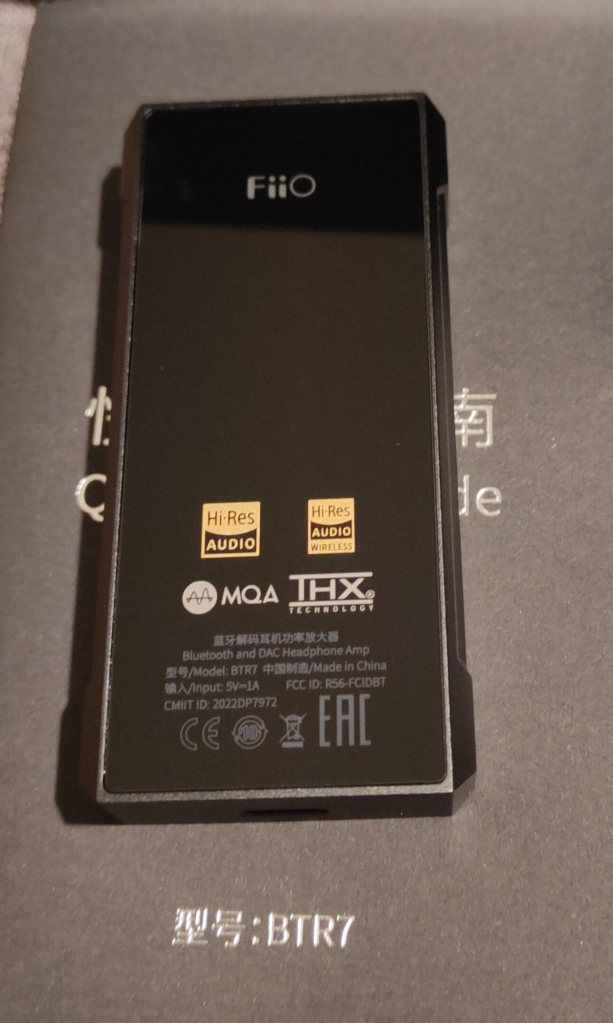
Unboxing and ergonomics:
Now that we have the introduction behind us, it’s time to move on to the next stage. The price of the new BTR7 is currently USD 199, so it is higher than BTR5 or other competitive solutions. In return, we get a nice cardboard packaging with the device itself, documentation, a USB-C to USB-C cable and a USB-to-USBC cable, as well as a nice and functional case made of gray suede-emitting material. Fiio BTR7 includes completely new components in the amplifier and USB sections, and the power from both the SE and BAL outputs has also increased significantly. As performance increased, the size and weight of the device also increased. It is already the size of a small DAC/AMP, but the parameters still do not exceed the concept of mobility and functionality. However, we must take into account that we will not attach the BTR7 to a T-shirt or sweatshirt, but we can still easily fit it in a pocket or even in our hand. The whole thing is made of a solid aluminum frame and two panes of glass. On the front there is a nice color display, unfortunately it is LCD, but its readability is very good even on sunny days. Additionally, we have a power button, volume control and a function button, as well as a microphone and a switch to turn on or off the charging of the device. The ability to power the BTR7 only from the built-in battery is a great solution and I really like it, it’s a pity that we can’t completely bypass the battery power supply and use an external power supply, but at the same time the battery still provides a much more stable current.
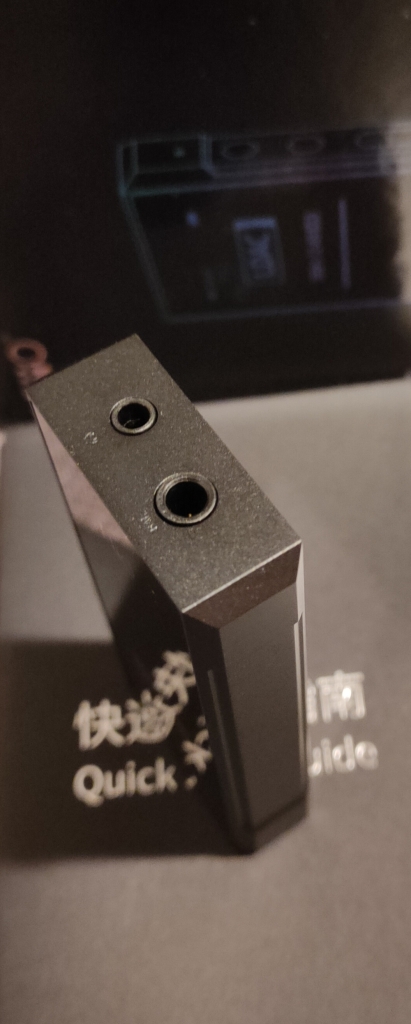
Battery and power supply:
As I have already mentioned, BTR7 can operate as a full-fledged DAC/AMP, both using the built-in battery and charging via the same cable used for data transmission. In DAC/AMP mode, it supports both UAC 1.0 and 2.0 modes and supports all popular Bluetooth codecs, including native MQA. This is a significant advantage over the competition, which at best reaches 92khz/24bit. Wired, the BTR7 sound is smoother and more resolved, with less compression. As for the battery, in real use with FLAC files and the LDAC codec and Tin P1max headphones, I achieved a stable time of 6 hours on the balanced output. This result may, of course, vary depending on the headphones and the selected configuration, but in my case it was always a stable time of over 5 hours.
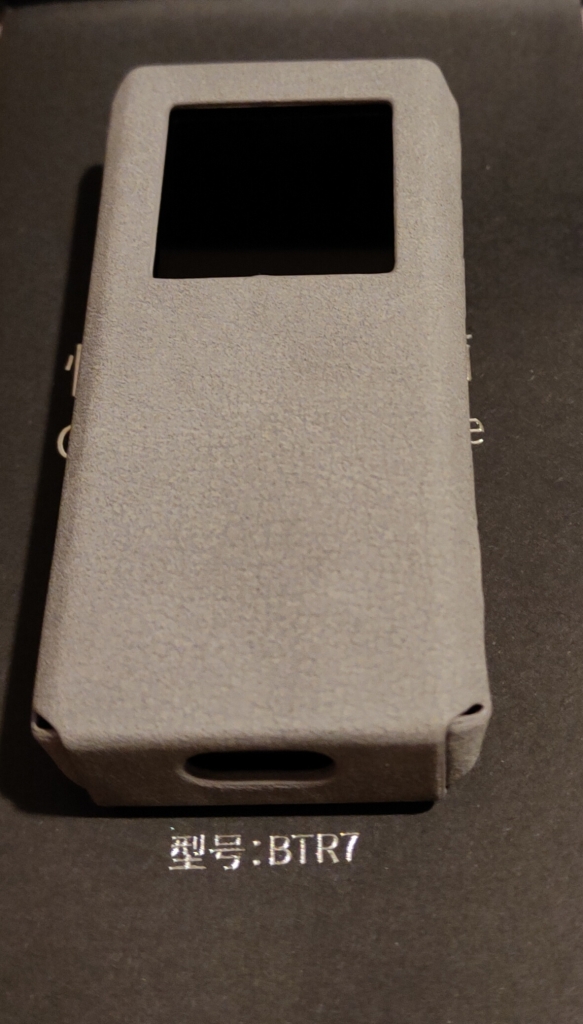
Sound:
Moving on to the next aspect, which is sound, I will divide my description into three main parts.
BASS: The low tones are very transparent and very technical, this technical aspect accompanies us throughout the entire tuning of the BTR7. We will definitely not miss the bass, and the tuning of the BTR7 is less ruthless than in the case of the BTR5 or BTR52021, the resolution of the low tones and their energy are exemplary, and the entire tuning is almost colorless and completely neutral. The amount of bass is adequate to the music presented, and the lower bands hit the right points nicely. The low tones are perfect for reference listening or analysis, but if we are looking for a warm sound, this is not the way to go. It is much better than in previous models, you can already feel a certain amount of heat. However, information and technical aspects still come first.
Midrange: The vocal and instrumental layer remains transparent and colorless, BTR7 shows music exactly as it is. It adds virtually nothing to the Siena, and the neutrality of the midrange is complemented by a quite good soundstage, both in width and depth. The 3D plan outlined in this way is enriched with incredible instrument separation and brilliant positioning. The amount of detail and information is above average, we can hear each instrument separately, and it is brilliantly placed in time and space. The vocals are natural and clear, not lifeless, but still retain an absolutely technical outline. The instruments sound natural, without any coloration.
Treble: The treble has been completely tamed and softened to a completely pleasant level. The high tones are smooth and neutral, showing a lot of information and details, without stinging the ears, which is a very desirable treatment. The high tones still retain their full of information and excellent sound character, but thanks to the minimum amount of warmth they sound much more natural and represent a much higher level, which is due to the tuning and great THX amplifiers. I like this direction of tuning because it allows me to focus entirely on the information contained in the music and analyze the songs completely, literally breaking down the music into its prime factors.
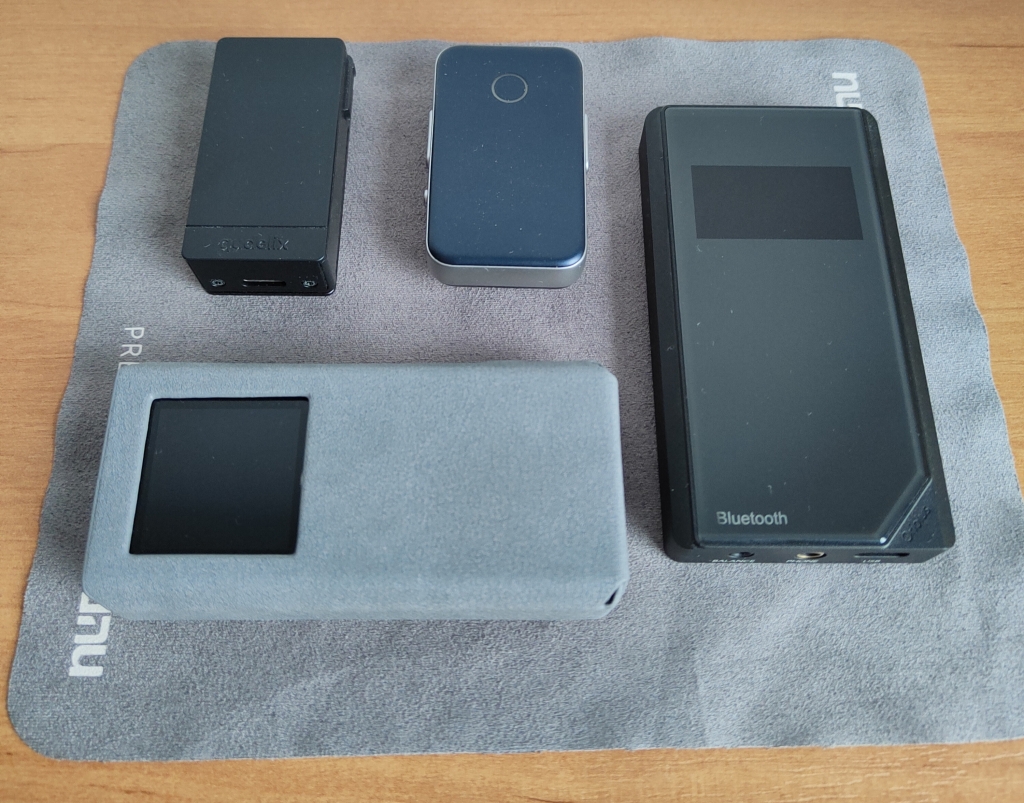
Comparisons:
Fiio BTR 7 (199USD) VS qudelix 5k 2020 (99USD)
Qudelix 5k is the undisputed leader when it comes to this type of devices up to PLN 500. It provides the most extensive application and excellent realistic sound with more warmth than the BTR7. However, BTR7 wins with much better technical features, a much larger sound stage and power. The BTR7 application also provides a lot of functions, and the BTR7 itself also has a functional screen. Sonically, the BTR7 is much more bland, technical and unforgiving of the music, while the qudelix 5k is more compact and provides a more forgiving tuning with a more intimate presentation.
Fiio BTR 7 (199USD) VS radsone es100mk2 (99USD)
Es100mk2 is a warm playing device with much less power than BTR7. Both devices are on completely opposite sides of the barricade when it comes to tuning. The es100mk2 stage is much smaller, more intimate, there is also more warmth and musicality, which is why the technical layer and resolution suffer. So it all depends on our preferences, in general the BTR7 sounds like a higher class device, but the tuning of the es100mk2 may appeal to lovers of warm sound and personally I love both devices.
Fiio BTR 7 (199USD) VS Oriolus 1795S (199USD)
Oriolus 1795S has similar dimensions to the BTR7 and, like it, has inductive charging. The workmanship is also similar – it is an aluminum frame and two glass panes. Oriolus 1795s is a less neutral sound, focusing more on the musical and technical side. However, it has a much smaller soundstage than the BTR7, but is less ruthless and more forgiving. In my opinion, both devices are great, the Oriolus will be perfect for quiet listening, and the BTR7 is an excellent reference and colorless device, but at the same time it is a real leader when it comes to the technical layer.
Summary:
Fiio BTR7 is not the cheapest device on the market, as it costs USD 199. However, you can see a lot of work in every aspect that Fiio put into this project. The quality of workmanship is impeccable, and even the smallest detail is well thought out. The sound offered by BTR7 has been slightly warmed and softened compared to BTR5 and is absolutely colorless and even, highly analytical and full of details. In addition, numerous updates offered by Fiio and many functions as well as good quality of calls via the built-in microphone allow me to clearly evaluate BTR7 as one of the best Bluetooth receivers on the market and an excellent USB DAC/AMP. The sterility and purity of sound offered by fiio, as well as the completely black background in BTR7, are something that should not only be praised, but also absolutely appreciated. The battery life is also satisfactory, and the device itself can operate entirely on the built-in battery, all this makes it my favorite device from an analytical point of view, which I highly recommend. The stability of the Bluetooth system is great, and the support of virtually every Bluetooth codec on the market ensures wide compatibility with many devices.
ywheng89
100+ Head-Fier
Pros: USB Dac mode with charge mode on or off (running straight from the dac/amp's battery or charge and receive power from the laptop or DAP)
Slight warm neutral sound and easy to pair with most transducers
Good battery life
Power amping section (THX) and not dry sounding
Slight warm neutral sound and easy to pair with most transducers
Good battery life
Power amping section (THX) and not dry sounding
Cons: Menu navigation can be improved
General/Packaging/Build
There are several portable bluetooth dongle/dac amps in the market from several manufacturers. I have the Fiio’s BTR7 with me today and this is the 2nd product from Fiio that I will be testing and reviewing. BTR7 is packed with features, not to mention a solid build quality as well. The front and back sports a glass panel and the body of the unit itself is made out of aluminium alloy which makes the whole unit look and feel premium.
The packaging itself is quite good, within the box it contains a leather case, the BTR7 itself as well as a long and short type c data cable. Let’s take a look at the specifications below:
Specifications
- Bluetooth Chip : Qualcomm QCC5124
- Bluetooth Version : Bluetooth V5.1
- Supported Codec’s : AAC, SBC, aptX, aptX Low Latency, aptX HD, LDAC and LHDC
- DAC : 2x Sabre ESS9219C
- Frequency Response : 20~20kHz(aptX connection), 20~50kHz(LDAC connection)
- THD+N : PO<0.00055% / Balanced <0.00048%
- SNR : PO≥118dB (32Ω A-weighted), BAL≥115dB (32Ω A-weighted)
- Sampling Rate : 384kHz/32bit (USB DAC)
- USB in DSD Support : 384KHz 32bit/ DSD256
- Output Interface : 3.5mm Single Ended & 4.4mm Balanced
- Output Power PO : 165mW@16 Ohm / 160mW@32 Ohm / 18mW@300 Ohm
- Output Power BAL : 235mW@16 Ohm / 320mW@32 Ohm / 40mW@300 Ohm
- Output Impedance : PO≤1.8Ω(32Ω loaded) /BAL≤2.8Ω(32Ω loaded)
- Amplitude : PO:2.3Vrms / BAL: 3.2Vrms
- Crosstalk PO : ≥ 75dB
- Crosstalk BAL : ≥ 107dB
- Recommended Imp. : 16~100Ω(PO)/ 16~150Ω(BAL)
- Battery : 880mAH
- Battery Life : approx 9hours
- Wired charging : ≤1.5 hours
- Wireless charging : ≤3 hours
- USB Port : USB Type C
- USB Input : Xmos XU208
- Dimensions : about 39.6x83.6x14.6mm
- Weight : about 68 grams
- Fiio BTR7 wired and wireless mode
- iFi Go Blu
- Spirit Torino Twin Pulse IEM
- Aune AR5000
- Dunu Falcon Ultra
Foreword
My review is solely based on what I hear via my equipment and I never consider my reviews to be objective in any way rather a subjective approach. Do take into consideration that everyone’s ear anatomy is not the same, so the psychoacoustics perception might be different as well, but i believe it will not stray too far
Battery Life
- I have tested the BTR7 in BT mode with AAC (iPhone 15) as well as LDAC (on my android DAP)
- On bluetooth mode, AAC and on low gain, volume step at 28/60, i am getting approximately 8 hours + -
- On LDAC however, it dropped to approximately 6 hours +- with the same volume step and gain
- Recharging the unit is fairly fast, not to mention it supports both wired and wireless charging, the latter is a slower option but a good to have feature
- OTA firmware update via Fiio’s Control App for both iOS and Android, updated my firmware when i gotten the unit via the app and it’s hassle free
- Support being used as a USB Dac/Amp
- There are plenty of features available and customizable for BTR7 within the app itself
- EQ feature, volume limiting, call volume, distortion compensation, second and third harmonic compensation
- Attached the screenshot from the app for a clearer view
Sound Impression (LDAC and Wired)
The overall presentation/tuning of the BTR7 is quite natural and clean, with a slight hint of warmth rather than completely neutral. With the warmth, note weight is good overall and it doesn’t sound dry nor thin making it quite easy to pair with my IEMs and headphones. The bass does have a slight authority but not overpowering the rest of the frequency range, mids are presented with clarity and they’re quite balanced in the sense where it’s not too recessed nor forward. Treble also has good extension and never sounded harsh or sibilant. In wireless mode, LDAC sounds closest to wired setup, while not exactly 100%, probably around 80+ % which is fairly good in my opinion, AAC however does sound a little compressed especially on the highs, hence making it sound a little bit more bassy based on my listening impression
Listening Impression with the following gears (Wired and LDAC)
Dunu Falcon Ultra
- Bass is punchy and tight, mid bass especially, sub bass does have a slight boost in terms of rumble
- Mids have plenty of details from lower mids and upper mids doesn’t sound shouty at all
- Both male and female vocal has good texture to it
- Slightly bigger soundstage
- Not so much changes in terms of detail retrieval
- Overall, a very good synergy pairing the Falcon Ultra with BTR7
- Falcon Ultra is very easy to drive, needing only 15/60 and low gain for my usual listening level, 20 is considered very loud and no, i am not associating loud = easy to drive, don’t get me wrong
- Twin Pulse IEM is a very natural sounding IEM, so any sorts of coloration from the dac/amp is very easy to spot
- Upon listening, the bass from Twin Pulse does seem to have a slightly better punch and extension from the sub bass
- Soundstage is slightly wider with better depth
- Treble on the other hand is slightly too smooth to my taste due to Twin Pulse’s tuning for treble is not overly boosted, but this pairing is very easy to listen to for a long time without any fatigue
- More than enough power to drive the twin pulse to its best performance, high gain on the other hand gives it a bit more dynamics as well as opening up the treble slightly
- AR500’s tuning is leaning toward musical with a tinge of warmth, my experience with this pairing is fairly positive
- Note weight is slightly improved with a thicker note overall
- Mid bass has a bit more punch and sub bass does have better extension
- Treble has good control and never harsh at all times
- Not much changes in terms of soundstage and imaging
- AR5000 doesn’t need a lot of power as it’s quite efficient coming in at 26Ω, but the amp section for BTR7 does a good job in driving the AR5000 to its best performance
- Go Blue sounds warmer to my ears and it is way more coloured compared to BTR7
- The low end is also more elevated compared to BTR7
- Treble is rather smooth with enough energy but not as good in terms of extension
- No high/low gain available, but the xBass (bass boost) and xSpace (enhance the soundstage) does add a bit of fun overall on analog level
- Output power is lower compared to BTR7
- No apps supports and lacking in terms of features
- Priced higher than BTR7
- USB Dac mode only supports up to 96/24
Having tested the BTR7 for several weeks, it’s safe to say the BTR7 is staying in my EDC bag, in fact, I prefer to carry the BTR7 over my DAP for the sake of convenience, not to mention that it does output some great high quality sound as well, coupled with a microphone, i’m also able to take some calls when it's necessary. Overall, the BTR7 is a great little device with good battery life and also a good sounding one. Recommended!
*A big thanks to Fiio for sending this over for the purpose of this review. I thank them for their support.
Head over to their official AliExpress Store and official website if you are interested in getting one:
Fiio BTR7 Aliexpress Store - Non affiliated
Fiio BTR7 Product Page
View previous replies…
ywheng89
Thanks @abheybir 

szore
I had the BTR7 and was shocked at how good it sounded....
Ichos
Reviewer at hxosplus
Pros: + Neutral and transparent sound
+ Highly resolving and refined
+ Not clinical or artificial sounding
+ Dynamic and impactful
+ Powerful THX headphone amplifier
+ 10 band user configurable equalizer
+ Excellent Bluetooth performance
+ USB DAC function with charge on/off button
+ 1.3" IPS color screen
+ Build-in microphone and car mode
+ FiiO Control application compatible
+ Excellent build quality
+ Comes with two cables and a protective case
+ Highly resolving and refined
+ Not clinical or artificial sounding
+ Dynamic and impactful
+ Powerful THX headphone amplifier
+ 10 band user configurable equalizer
+ Excellent Bluetooth performance
+ USB DAC function with charge on/off button
+ 1.3" IPS color screen
+ Build-in microphone and car mode
+ FiiO Control application compatible
+ Excellent build quality
+ Comes with two cables and a protective case
Cons: - Larger and heavier than the BTR5
- Mediocre battery duration
- Menu not that easy to read
- Lighting cable is extra
- The material and the color of the case are poor choices because it gets easily stained and shows dirt
- Mediocre battery duration
- Menu not that easy to read
- Lighting cable is extra
- The material and the color of the case are poor choices because it gets easily stained and shows dirt
The review sample was kindly provided free of charge in exchange for an honest review.
I didn't receive monetary or any other kind of compensation and I don't use affiliate links.
The price of the BTR7 is $199.99 and EU customers can order it from here.

FiiO BTR7
FiiO is a milestone company in the personal audio industry with thousands of satisfied customers around the world and I doubt that there is a need for lengthy introductions.
Let's go straight to the BTR7 which is the flagship, portable, Bluetooth DAC/amp of the company ahead of the BTR3K and BTR5.
The brand new FiiO BTR7 is designed with an innovative 3-level audio architecture including the high performance DAC section, a low pass filter and THX amplifiers.
It houses two ES9219C DAC chips from ESS to do the decoding while it is the first portable Bluetooth amplifier to utilize two THX AAA-28 amplifiers in a fully balanced configuration.
There are two headphone outputs, one 4.4mm balanced and one 3.5mm single ended.

When used for USB audio the BTR7 relies on the XMOS XUF208 chipset as the receiver with support for 384kHz/32bit PCM, native DSD256 and MQA 8x.
The latest Qualcomm QCC5124 Bluetooth 5.1 chip, with its dual DSP and dual-core CPU architecture, ensures stable connection and support for the high resolution codecs LDAC and aptX HD.
The BTR7 uses an 880mAh capacity battery, which supports wireless charging, to provide power to the separated analog and digital sections with no less than 13 discrete voltage regulators.
Battery duration is good but not exemplary, it provided about 6 hours of use from the balanced output with mixed Bluetooth and wired connection.
The BTR7 features a 1.3" IPS color display with a new colorful GUI that presents the configuration menu and other important information.
The screen is not that large so the lettering is tiny but it offers good visibility and it gets the job done much better than the screen of the BTR5.
The BTR7 has a built-in microphone so you can use it for making phone calls and it even supports earphones with CTIA in-line controls.

Appearance and user interface
The BTR7 design deviates from the other products of the series as it now much resembles that of the FiiO digital audio players like the M11S.
It certainly looks better and more modern than the BTR5 but it is slightly larger and heavier.
Still, it is very compact and lightweight to carry it around with you inside a pocket.

The chassis is made from laminated aluminum alloy with excellent finish and workmanship.
This is a well built and sturdy device that looks beautiful and has nice ergonomics.
The BTR7 has a multifunction button for powering and entering the menu, a play/pause button that is also used for making menu selections, a volume adjustment button that is also used to navigate through the menu and a charge on/off switch.
All of them are located at the right side of the chassis and are very easy to use with your right hand.

Volume is independently adjusted in 60 discrete levels and with the charge button set to off you can use the BTR7 as a self-powered USB dongle so it will not drain your phone's battery.
FiiO Control application
The BTR7 supports the FiiO Control application which allows for further customization and allows OTA firmware updates, a function that I have tested and worked flawlessly.
You can set various parameters like what the buttons can do, select the input priority between Bluetooth and USB, select the boosted gain mode, power off timer and others.
All selections are permanently stored in the memory so you can use the BTR7 without further connecting it to the Bluetooth.

Equalizer
The BTR7 has a 10 band equalizer with pre-gain setting which is applicable to both USB DAC and Bluetooth modes.
There are seven preset modes and three user configurable that can be customized through the FiiO Control application and then are permanently stored in the device memory so you can use them from the internal menu of the BTR7 without the need to further access the app.

Accessories
Inside the box you are going to find a type-C USB cable for charging, a short type-C to C data cable and a gray-colored protective leatherette case.
The Apple edition also has a type-C to lightning data cable and it is more expensive than the regular one.

Listening impressions
The BTR7 was left playing music for about 80 hours in order to settle down.
The latest firmware v1.85 was installed.
I have used various headphones and earphones but mostly the Sennheiser HD660s, the Meze ADVAR, the FiiO FDX and the brand new FH7S.
All headphone cables are of pure silver and made by Lavricables.

Power output is really impressive for such a dongle, with 320mW/32Ω from the balanced output, the BTR7 is quite powerful and it drove the HD660s not only painfully loud but also with good authority and grip.
I never needed more than 40 steps from the 60 and I also had good results with the HiFiMan Susvara although I engaged the boost mode just to have all the juice on tap.
Low gain has an impressively low noise floor and you can use it with more sensitive earphones without worrying about hiss.
Sound quality is excellent, the BTR7 is crystal clear, neutral and transparent with excellent linearity and premium fidelity.
At the same time it manages to sound quite musical, engaging and certainly not clinical or artificial.
It is even slightly warm and it ranks as one of the least digital and etched sounding implementations of the ES9219C I have ever tested, a DAC chip that can be notoriously bright and harsh.
The BTR7 is a lively sounding DAC with fast transient response and a firm, well controlled bass which is distinguished by its layering and definition.
The texture is full bodied and not lean as someone would expect while dynamics are stellar.
It seems that the extra THX amplifiers are doing some great job into adding impact, weight and thrust into the sound.
Mid-range is not dry and sounds well articulated with a mostly natural timbrel that gives music a good sense of realism.
The treble is resolving and refined enough with good detail retrieval, excellent clarity and a smoothed texture without causing listener fatigue despite being mildly forward and sparkling.
Another area where the BTR7 seems to benefit from the THX amplifiers is the soundstage which is expanded and wide with spacious and precise allocation of the performers.
It is not that holographic but it still manages to sound large with acceptable depth layering for the price point.

Bluetooth sound performance
The BTR7 is firstly and foremost a Bluetooth DAC/amp and most people are going to buy it for wireless mostly use rather than wired.
And they shouldn't be worried at all because the Bluetooth connection is fast, stable and reliable with good working distance and an excellent sound quality.
With the LDAC codec enabled, the sound performance gets so close to the wired that you shouldn't even bother with the hassle of the cable, at least while on the go.
You can spot the usual treble compression and some loss of overall fidelity but other than that the result is pretty spectacular.
Even with more demanding material like high resolution classical music, I didn't find much to complain about, at least while I was not in critical listening mode.

Compared to the BTR5 (original version)
The BTR7 is finer sounding, it has better clarity, greater definition, it is more resolving and extended to both ends of the spectrum, it has higher quality texture, more natural timbre and greater dynamics.
It can drive demanding earphones and if you don't mind the extra bulk then sound-wise it is a definite upgrade.
I don't have the BTR5 2021 version which uses the same DAC chip as the BTR7 but I doubt if it can compete with it in raw power, shear dynamics and overall realism.

Compared to the EarMen Colibri ($333)
Another pretty interesting comparison is with the EarMen Colibri which despite not having Bluetooth connectivity is $133 more expensive than the FiiO BTR7.
So why would someone, who needs a self-powered device, buy the more expensive Colibri over the BTR7?
One reason would be that it is a slightly more compact and lightweight although differences are not that big.
Another one would be brand fanboyism, not all people like FiiO.
Or the preference for minimalist circuit designs, the Colibri cuts down all unnecessary features for the best possible sound quality.
The last one would be the just slightly more transparent and refined sound quality of the Colibri and its ability to push more current into 16Ω loads from the balanced output, where it can ditch 560mW against the 235mW of the BTR7.
But other than that, the BTR7 is definitely the more feature inclusive device with an equally stunning sound quality and a more friendly price.

In the end
The FiiO BTR7 is a portable, USB DAC dongle which perfectly integrates excellent Bluetooth and wired sound quality with great power output in a sturdy and well built body which is not too bulky.
You can carry it all day long without the need to use a cable and then you can use it as a USB DAC when back at home.
An excellent solution that will equally suit the beginner as his first do-it-all portable source and the advanced user who seeks wireless connectivity without sacrificing sound quality.
Test playlist
Copyright - Petros Laskis 2022.
I didn't receive monetary or any other kind of compensation and I don't use affiliate links.
The price of the BTR7 is $199.99 and EU customers can order it from here.

FiiO BTR7
FiiO is a milestone company in the personal audio industry with thousands of satisfied customers around the world and I doubt that there is a need for lengthy introductions.
Let's go straight to the BTR7 which is the flagship, portable, Bluetooth DAC/amp of the company ahead of the BTR3K and BTR5.
The brand new FiiO BTR7 is designed with an innovative 3-level audio architecture including the high performance DAC section, a low pass filter and THX amplifiers.
It houses two ES9219C DAC chips from ESS to do the decoding while it is the first portable Bluetooth amplifier to utilize two THX AAA-28 amplifiers in a fully balanced configuration.
There are two headphone outputs, one 4.4mm balanced and one 3.5mm single ended.

When used for USB audio the BTR7 relies on the XMOS XUF208 chipset as the receiver with support for 384kHz/32bit PCM, native DSD256 and MQA 8x.
The latest Qualcomm QCC5124 Bluetooth 5.1 chip, with its dual DSP and dual-core CPU architecture, ensures stable connection and support for the high resolution codecs LDAC and aptX HD.
The BTR7 uses an 880mAh capacity battery, which supports wireless charging, to provide power to the separated analog and digital sections with no less than 13 discrete voltage regulators.
Battery duration is good but not exemplary, it provided about 6 hours of use from the balanced output with mixed Bluetooth and wired connection.
The BTR7 features a 1.3" IPS color display with a new colorful GUI that presents the configuration menu and other important information.
The screen is not that large so the lettering is tiny but it offers good visibility and it gets the job done much better than the screen of the BTR5.
The BTR7 has a built-in microphone so you can use it for making phone calls and it even supports earphones with CTIA in-line controls.

Appearance and user interface
The BTR7 design deviates from the other products of the series as it now much resembles that of the FiiO digital audio players like the M11S.
It certainly looks better and more modern than the BTR5 but it is slightly larger and heavier.
Still, it is very compact and lightweight to carry it around with you inside a pocket.

The chassis is made from laminated aluminum alloy with excellent finish and workmanship.
This is a well built and sturdy device that looks beautiful and has nice ergonomics.
The BTR7 has a multifunction button for powering and entering the menu, a play/pause button that is also used for making menu selections, a volume adjustment button that is also used to navigate through the menu and a charge on/off switch.
All of them are located at the right side of the chassis and are very easy to use with your right hand.

Volume is independently adjusted in 60 discrete levels and with the charge button set to off you can use the BTR7 as a self-powered USB dongle so it will not drain your phone's battery.
FiiO Control application
The BTR7 supports the FiiO Control application which allows for further customization and allows OTA firmware updates, a function that I have tested and worked flawlessly.
You can set various parameters like what the buttons can do, select the input priority between Bluetooth and USB, select the boosted gain mode, power off timer and others.
All selections are permanently stored in the memory so you can use the BTR7 without further connecting it to the Bluetooth.

Equalizer
The BTR7 has a 10 band equalizer with pre-gain setting which is applicable to both USB DAC and Bluetooth modes.
There are seven preset modes and three user configurable that can be customized through the FiiO Control application and then are permanently stored in the device memory so you can use them from the internal menu of the BTR7 without the need to further access the app.

Accessories
Inside the box you are going to find a type-C USB cable for charging, a short type-C to C data cable and a gray-colored protective leatherette case.
The Apple edition also has a type-C to lightning data cable and it is more expensive than the regular one.

Listening impressions
The BTR7 was left playing music for about 80 hours in order to settle down.
The latest firmware v1.85 was installed.
I have used various headphones and earphones but mostly the Sennheiser HD660s, the Meze ADVAR, the FiiO FDX and the brand new FH7S.
All headphone cables are of pure silver and made by Lavricables.

Power output is really impressive for such a dongle, with 320mW/32Ω from the balanced output, the BTR7 is quite powerful and it drove the HD660s not only painfully loud but also with good authority and grip.
I never needed more than 40 steps from the 60 and I also had good results with the HiFiMan Susvara although I engaged the boost mode just to have all the juice on tap.
Low gain has an impressively low noise floor and you can use it with more sensitive earphones without worrying about hiss.
Sound quality is excellent, the BTR7 is crystal clear, neutral and transparent with excellent linearity and premium fidelity.
At the same time it manages to sound quite musical, engaging and certainly not clinical or artificial.
It is even slightly warm and it ranks as one of the least digital and etched sounding implementations of the ES9219C I have ever tested, a DAC chip that can be notoriously bright and harsh.
The BTR7 is a lively sounding DAC with fast transient response and a firm, well controlled bass which is distinguished by its layering and definition.
The texture is full bodied and not lean as someone would expect while dynamics are stellar.
It seems that the extra THX amplifiers are doing some great job into adding impact, weight and thrust into the sound.
Mid-range is not dry and sounds well articulated with a mostly natural timbrel that gives music a good sense of realism.
The treble is resolving and refined enough with good detail retrieval, excellent clarity and a smoothed texture without causing listener fatigue despite being mildly forward and sparkling.
Another area where the BTR7 seems to benefit from the THX amplifiers is the soundstage which is expanded and wide with spacious and precise allocation of the performers.
It is not that holographic but it still manages to sound large with acceptable depth layering for the price point.

Bluetooth sound performance
The BTR7 is firstly and foremost a Bluetooth DAC/amp and most people are going to buy it for wireless mostly use rather than wired.
And they shouldn't be worried at all because the Bluetooth connection is fast, stable and reliable with good working distance and an excellent sound quality.
With the LDAC codec enabled, the sound performance gets so close to the wired that you shouldn't even bother with the hassle of the cable, at least while on the go.
You can spot the usual treble compression and some loss of overall fidelity but other than that the result is pretty spectacular.
Even with more demanding material like high resolution classical music, I didn't find much to complain about, at least while I was not in critical listening mode.

Compared to the BTR5 (original version)
The BTR7 is finer sounding, it has better clarity, greater definition, it is more resolving and extended to both ends of the spectrum, it has higher quality texture, more natural timbre and greater dynamics.
It can drive demanding earphones and if you don't mind the extra bulk then sound-wise it is a definite upgrade.
I don't have the BTR5 2021 version which uses the same DAC chip as the BTR7 but I doubt if it can compete with it in raw power, shear dynamics and overall realism.

Compared to the EarMen Colibri ($333)
Another pretty interesting comparison is with the EarMen Colibri which despite not having Bluetooth connectivity is $133 more expensive than the FiiO BTR7.
So why would someone, who needs a self-powered device, buy the more expensive Colibri over the BTR7?
One reason would be that it is a slightly more compact and lightweight although differences are not that big.
Another one would be brand fanboyism, not all people like FiiO.
Or the preference for minimalist circuit designs, the Colibri cuts down all unnecessary features for the best possible sound quality.
The last one would be the just slightly more transparent and refined sound quality of the Colibri and its ability to push more current into 16Ω loads from the balanced output, where it can ditch 560mW against the 235mW of the BTR7.
But other than that, the BTR7 is definitely the more feature inclusive device with an equally stunning sound quality and a more friendly price.

In the end
The FiiO BTR7 is a portable, USB DAC dongle which perfectly integrates excellent Bluetooth and wired sound quality with great power output in a sturdy and well built body which is not too bulky.
You can carry it all day long without the need to use a cable and then you can use it as a USB DAC when back at home.
An excellent solution that will equally suit the beginner as his first do-it-all portable source and the advanced user who seeks wireless connectivity without sacrificing sound quality.
Test playlist
Copyright - Petros Laskis 2022.
Last edited:
NymPHONOmaniac
@Ichos yes, i think it would be a good idea...its near as powerfull, it use dual ess9218p and have genius app with douzens of features and excellent PEQ....excellent connectivity stability, crisp reference neutral sound....oh, and only cost 100$.
Ichos
I have mailed them, let's see if they respond....
NymPHONOmaniac
@Ichos finger crossing! i should email Fiio for BTR7 but last product i receive (FF3) was defective so....im not sure ill get any answer lol a bit sad since i praise BTR5 quite alot and have like...5 bluetooth dac-amps...perhaps more...but its not really something i use alot, apart for hooking to my soundsystem.
ChrisOc
Headphoneus Supremus
Pros: Good sound quality
Lots of power
Pocketable
Convenient portable audio device
Lots of power
Pocketable
Convenient portable audio device
Cons: Software is good but does not yet have the BTR5 finesse, best described as work in progress.
Wireless charging is a useful feature to have, but needs some more work.
Wireless charging is a useful feature to have, but needs some more work.
Intro
These days, we have a lot of choice out there but sometimes something stands out of the crowded marketplace, and yes, I have not tried everything but I have used various dongle DAC/Amps, some with Bluetooth option, some without. As I have the BTR5 and now the BTR7, I can only tell you that, in my experience and in my opinion, the BTR5 has been has been a joy to own and use. I am not saying it is the best thing in town, because I have not heard them all, but what I can say is that the BTR5 has a lot to offer.
The BTR5 had the option of 2.5mm and 3.5mm outputs. For me that virtually locked me into the 2.5mm cable terminations for a long while, despite recognising the fact that our world of audio enthusiasts has moved on and the future is 4.4mm, as someone rightly pointed out a while ago. The reason for my reluctance is not because I was hooked on 2.5mm terminations or reluctant use an adaptor but because the BTR5 gave me the freedom I wanted but that came at a price, the 2.5mm handcuffs.
As we all know, our hobby takes up a lot of our time, and you spend even more time engrossed in the hobby when you choose to review audio gear. We are all also aware that music can be ancillary to other things in our lives, family, study, work, etc. or take your entire focus, and pin you down.
The versatility of the BTR5 gave me is that I can move about and get on with other things and still listen to good quality music or a podcast on the move.
Now, the BTR7 is here and compared to the BTR5, it comes with a 4.4mm and 3.5mm outputs. Freedom from 2.5mm! What that says about me is that I was hooked to the BTR5, which was my companion. Does the BTR7 change that?

Disclosure and Note
Disclosure: All opinions I express here are my own with no influence from anyone. No one has editorial control or influence over the contents of this review. I do not read or watch reviews of items I itend to review. I make an effort to ensure that I give the reader factual information. I appreciate your feedback.
Notes: I bought the BTR7 at Advanced MP3 Players in the UK for £174.99. This is not a free review unit, but it makes no difference to my reporting. I report my experience in the same way I would, whether the item was sent to me as a free review unit or not, my reports are honest and presented in a positive manner.
Reviewing audio gear is a hobby for me. I spend so much time with items I review that if I do not like it I do not review it. That might explain to some why I have a positive approach to reviews as opposed to cynicism, which appears to be a style and an expectation in some circles. That "machismo" is just childish. No dumping on what I do not like, I simply do not waste my time reviewing the item at all. That is not to say that I do not point out the faults of items I do review, as I see them.
My grading is relative to price, so a 4 star for a $20 product does not mean I rate it the same as a $200 product.
My setup for this review
I paired them with Samsung galaxy note 10 plus,Mi Mix and various earphones, and headphones.
Form, Features and Function
The package: The BTR7 comes in a mid-sized clear cardboard box. Inside the packaging are three sections. The top foam compartment is simply a chunk of foam cut out with the BTR7 tightly hugged in place. You then have a second compartment with the BTR7 suede-like case. The third section lies at the bottom of the package and has a short USB C to USB cable and a second cable which is USB C to USB C cable. You also get a warranty card and a Quick Start Guide.
Form: The frame of the BTR7 appears to be a full metal shell and measures approximately 14.6 mm x 39.6 mm with a Length of 83.6mm. The metal casing feels solid. The design cue is angular and appears to have trickled down from Fiio’s current house style, evident on their recent DAP design.

The front and back of the device are covered in glass. The glass back has no more than inscriptions of Fiio Logo and the de rigueur “Hi Res Audio” and Hi Res Wireless Audio” stickers plus the MQA and THX logos. The top of the device has the 4.4mm port and the 3.5mm port. Looking at the device from the front, the left side has nothing on it. The bottom of the device has a USB C port, for charging and data transmission. The right side is action packed with 5 functional items.
At the top you get a pin point microphone hole. The next in line is your multi purpose buttons, on/off and return button. That is followed by play/pause and select button. You then have the volume up and down button which also functions as the “scroll” up and down selection button (can be customised in the FiiO Control App).
The last in line is the charge on and off button, which in essence allows you to charge the device, but it is intended to give the user the option of not draining the power of a host device, such as a phone when connected by USB. However, beware, the device will not charge if you forget to flick the switch to charge (it is indicated by showing the red coloured surface under the button).
The front of the device has a 1.3 inch IPS display with a 240 x 240 resolution colour display. The standard information on the screen display gives you, volume, battery meter limited to an icon with a solid white bar which shows the depleting battery by changing to decreasing white are and increasing black area, so the more black area you have the less battery you have available. However, there is no percentage indication, except in the app and your phone or tablet, when you first connect the BTR7 you get a brief indication of how much power you have. That battery percentage is currently in blocks of 20% as on the BTR5 no less.

Features: The BTR7 is a feature packed Bluetooth DAC/Amp and is an unexpectedly wonderful yet balanced sound it delivers. The highlight of the features are USB Audio with in-built XMOS chip, just remember to cancel USB Audio notification when it comes up on your phone.
The BTR7 is probably the only device in its class to come with wireless charging. The reasoning being that you can use your phone's reverse wireless charging to top it up or charge it up in your car. However, it needs some tweaking.
Function: In USB mode: As previously mentioned, above, XMOS is built into your device. All you need is to plug in and play from any music App including your streaming Apps, which clearly may come to your host device (phone tablet or computer as wireless but no longer are you restricted to UAPP.
Bluetooth mode: The Bluetooth mode gives you all the bluetooth codecs, but ensure your phone supports the codec you want to use and if it does, ensure it is all activated. My phones play 24bit and connects to LDAC without issue.
The Bluetooth range I got was about 12 meters or 39 feet of clean Bluetooth signal away from my phone from the BTR7 without issue. When I had my phone in my pocket and I had no issues using my phone mobile data. My only restrictions are if I had my in one place and I went beyond 12 meters or using Wifi at home, where walls are the main limitation to the connection.
The FiiO Control App: This is a useful App, no doubt it is a work in progress, which means we might get additional features and certainly updates. In any case, the available options are quite effective. In essence the App once installed on your phone, tablet or desktop computer, gives you the option to operate or install a number of features, settings and software updates on your device using the App.
On opening the App you have the option to add other Fiio devices. Once your Fiio device is set up on the App, you can click on the specific device which will open the control screen for that device. For the BTR7 you have at the bottom of your screen four sections. They are, Status, Equaliser, Audio and User guide. Under status, you get battery percentage (again in 20% blocks), the option to put the charge function, wire function and Car mode on or off.
You also get the option to determine how long your device remains idle (when not in use) before it turns off the power completely. Quite usefully you also have a question mark [?] which when you click on, gives you a short explanation of the particular function next to that question mark.
There is also a selection of Bluetooth codec. You can click them all and your device will click connect using the best codec available at any point. The other functions are, Input priority, which is whether to prioritise bluetooth or USB in, your choice applies when you have a USB connection on the BTR7, so in effect it goes for what you choose to prioritise but does not restrict you if you only have one of the two options in use. You have the “Menu Option” which allows you to select whether you want to hold the power button to enter the menu or double click the power button to enter the menu.
For selecting the operation, you use volume buttons up to select tracks or double click to switch tracks. The final one in this section is how long you want your screen to remain on before BTR7 automatically turns off your LCD screen.
The EQ gives you the option for one saved EQ setting. Of course you can have a separate EQ App to have multiple EQ settings.

The Audio option allows you to set your maximum Bluetooth volume, call volume and channel balance volume. You then have the “Boost balanced out mode” this gives you the option to boost the sound quality and volume coming out of the balanced part, but you drain power and increase the noise floor. In my experience the boost in sound quality is noticeable, and the reduction in battery life and increased noise are not noticeable.
Then you have distortion compensation and Low pass filter, both of which I have never used, so I cannot comment on.
You can dive deeper into each category by reading the user guide for yourself.
The sound
The FIIO BTR7 is tuned to give you a balanced sound. The effect of this is that you get good bass, a well presented rather than recessed midrange and plenty of sparkle in the highs, all of which would reflect your monitors’ quality, the device will not improve your earphones or headphones, it will bring out very good quality of the monitors.
The THX technology means you get a clean and noise-free sound from your BTR7. As has become a Fiio signature on many FIIO DACs and Amps.
For me what has been done is to slightly reduce the bass impact, extend the treble, giving the impression of improvement in clarity and detail retrieval. When I listen to the same set of monitors on the BTR5, I pick up a slightly more impactful bass, and detect the same detail in the midrange and treble but less pronounced compared to the BTR7.
It makes the BTR7 seem more detailed when in fact there is nothing I could hear on the BTR7 which is not audible on the BTR5, simply a bit more bass on the BTR5 and a more pronounced treble on the BTR7. Having said that I prefer the implementation of the sound on the BRT7. If I want more bass, I get a bassier set of earphones or headphones, but the details are then put on a plate for me, I do not have to strain to hear the details. Add to that the cleaner THX amplification power and cleanliness and the BTR7 moves up a level aove the BTR5, everything sounds more detailed.
The BTR7 will power difficult to drive monitors. My hard to drive monitors were driven well on the BTR7, but like all portables do not be surprised if you can get more out of your monitors on a fixed system, simply because these devices are intended to give you mobile music without sapping too much power. The management of power means there are limitations, but I am happy to report that there is plenty for most to get a lot of pleasure out of most monitors.
Comparision with the BTR5 [Note Original not 2021 version]

I have used the BTR5 for almost three years and it has regularly been at my side for much of that time. The BTR5 remains a benchmark for a portable Bluetooth DAC/Amp particularly because of its size, ease of use and features. How does the bigger sibling, the BTR7 fare? In my view Fiio has improved some respects on the BTR7 and in other respects the BTR has some catching up to do.
The BTR7 does incredibly well on sonics. Why? When it comes to sound quality, I think there has been a marginal but perceptible improvement in sound quality. The BTR5 is no slouch in the sound quality and the improvement is described above. When it comes to power, there is no doubt that BTR7 has a marked improvement on the power it can call on compared to the BTR5.
What improvements are required? When charging the BTR5 shows you an image of a battery with 5 bars. The BTR5 animation blinks sequentially through the 5 bars, lighting each up (the bar stays lit as opposed to blinking)) as the battery’s charge percentage increases.
The same logical animation is used to show battery depletion with each bar dimmed as the battery depletes.
On the BTR7 the bar is coloured green (that looks good but it is no improvement) there is a hilarious attempt to replicate the increasing charge on the BTR5, but that falls apart within a few seconds of the animation starting, so instead of increasing lit up bars while charging, you get about 3 bars lit up initially, which then reduce to two and then one (does that mean battery depleted successfully?).
I have every faith that Fiio will resolve this issue, it has been done successfully on the BTR5 why not the BTR7.
The BTR5 also has the function where the play/pause button (second from top when display is facing the user) is used to play a music player on screen, when you press pause on the BTR5, the music player stops (logical you might say).
On the BTR7 when you press stop, the App on your screen stops BUT the second App starts playing. If I have multiple music Apps open, the BTR7 will just stop one and play the other. These are software features which work seamlessly on the BTR5, there is no reason why they cannot be fixed on the BTR7. Due to the fact that I write reviews, I do not use equalisers, but for some it is a highlight to manipulate the sound on their monitors. The equaliser on the BTR7 is limited to one setting, granted it does not prevent the use of other EQ Apps.
Comparison with the HAAFEE HA1
The HA1 is a joy to listen to the implementation of the ESS DAC chips is one of the best I have heard, the sound is so melodic. The HA1 also offers Bluetooth, claims 1Watt of power. It is a solid feeling unit, with the exception of the volume knob which falls off often.
The problems are that the battery life seems to be around four hours and it takes virtually all night to charge. The other issue is the size, this is the of an ample size DAP. For convenience, the BTR7 wins, for sound quality to my ears, the HAFEE has it.
Conclusion
The indispensable convenience of the BTR5 has not been improved on the BTR7 possibly because the convenience of the BTR5 is as good as it gets, but what is important is that the BTR7 is no less convenient.
However, with the improvement in power, some features and sound quality on the BTR7, in my view, the BTR7 is a worthy successor to the BTR5. I hope Fiio gets the software features on the BTR7 to the level of the BTR5 and I would say they have done it….. they have perfectly improved the BTR5!
Enjoy your music!
These days, we have a lot of choice out there but sometimes something stands out of the crowded marketplace, and yes, I have not tried everything but I have used various dongle DAC/Amps, some with Bluetooth option, some without. As I have the BTR5 and now the BTR7, I can only tell you that, in my experience and in my opinion, the BTR5 has been has been a joy to own and use. I am not saying it is the best thing in town, because I have not heard them all, but what I can say is that the BTR5 has a lot to offer.
The BTR5 had the option of 2.5mm and 3.5mm outputs. For me that virtually locked me into the 2.5mm cable terminations for a long while, despite recognising the fact that our world of audio enthusiasts has moved on and the future is 4.4mm, as someone rightly pointed out a while ago. The reason for my reluctance is not because I was hooked on 2.5mm terminations or reluctant use an adaptor but because the BTR5 gave me the freedom I wanted but that came at a price, the 2.5mm handcuffs.
As we all know, our hobby takes up a lot of our time, and you spend even more time engrossed in the hobby when you choose to review audio gear. We are all also aware that music can be ancillary to other things in our lives, family, study, work, etc. or take your entire focus, and pin you down.
The versatility of the BTR5 gave me is that I can move about and get on with other things and still listen to good quality music or a podcast on the move.
Now, the BTR7 is here and compared to the BTR5, it comes with a 4.4mm and 3.5mm outputs. Freedom from 2.5mm! What that says about me is that I was hooked to the BTR5, which was my companion. Does the BTR7 change that?

Disclosure and Note
Disclosure: All opinions I express here are my own with no influence from anyone. No one has editorial control or influence over the contents of this review. I do not read or watch reviews of items I itend to review. I make an effort to ensure that I give the reader factual information. I appreciate your feedback.
Notes: I bought the BTR7 at Advanced MP3 Players in the UK for £174.99. This is not a free review unit, but it makes no difference to my reporting. I report my experience in the same way I would, whether the item was sent to me as a free review unit or not, my reports are honest and presented in a positive manner.
Reviewing audio gear is a hobby for me. I spend so much time with items I review that if I do not like it I do not review it. That might explain to some why I have a positive approach to reviews as opposed to cynicism, which appears to be a style and an expectation in some circles. That "machismo" is just childish. No dumping on what I do not like, I simply do not waste my time reviewing the item at all. That is not to say that I do not point out the faults of items I do review, as I see them.
My grading is relative to price, so a 4 star for a $20 product does not mean I rate it the same as a $200 product.
My setup for this review
I paired them with Samsung galaxy note 10 plus,Mi Mix and various earphones, and headphones.
Form, Features and Function
The package: The BTR7 comes in a mid-sized clear cardboard box. Inside the packaging are three sections. The top foam compartment is simply a chunk of foam cut out with the BTR7 tightly hugged in place. You then have a second compartment with the BTR7 suede-like case. The third section lies at the bottom of the package and has a short USB C to USB cable and a second cable which is USB C to USB C cable. You also get a warranty card and a Quick Start Guide.
Form: The frame of the BTR7 appears to be a full metal shell and measures approximately 14.6 mm x 39.6 mm with a Length of 83.6mm. The metal casing feels solid. The design cue is angular and appears to have trickled down from Fiio’s current house style, evident on their recent DAP design.

The front and back of the device are covered in glass. The glass back has no more than inscriptions of Fiio Logo and the de rigueur “Hi Res Audio” and Hi Res Wireless Audio” stickers plus the MQA and THX logos. The top of the device has the 4.4mm port and the 3.5mm port. Looking at the device from the front, the left side has nothing on it. The bottom of the device has a USB C port, for charging and data transmission. The right side is action packed with 5 functional items.
At the top you get a pin point microphone hole. The next in line is your multi purpose buttons, on/off and return button. That is followed by play/pause and select button. You then have the volume up and down button which also functions as the “scroll” up and down selection button (can be customised in the FiiO Control App).
The last in line is the charge on and off button, which in essence allows you to charge the device, but it is intended to give the user the option of not draining the power of a host device, such as a phone when connected by USB. However, beware, the device will not charge if you forget to flick the switch to charge (it is indicated by showing the red coloured surface under the button).
The front of the device has a 1.3 inch IPS display with a 240 x 240 resolution colour display. The standard information on the screen display gives you, volume, battery meter limited to an icon with a solid white bar which shows the depleting battery by changing to decreasing white are and increasing black area, so the more black area you have the less battery you have available. However, there is no percentage indication, except in the app and your phone or tablet, when you first connect the BTR7 you get a brief indication of how much power you have. That battery percentage is currently in blocks of 20% as on the BTR5 no less.

Features: The BTR7 is a feature packed Bluetooth DAC/Amp and is an unexpectedly wonderful yet balanced sound it delivers. The highlight of the features are USB Audio with in-built XMOS chip, just remember to cancel USB Audio notification when it comes up on your phone.
The BTR7 is probably the only device in its class to come with wireless charging. The reasoning being that you can use your phone's reverse wireless charging to top it up or charge it up in your car. However, it needs some tweaking.
Function: In USB mode: As previously mentioned, above, XMOS is built into your device. All you need is to plug in and play from any music App including your streaming Apps, which clearly may come to your host device (phone tablet or computer as wireless but no longer are you restricted to UAPP.
Bluetooth mode: The Bluetooth mode gives you all the bluetooth codecs, but ensure your phone supports the codec you want to use and if it does, ensure it is all activated. My phones play 24bit and connects to LDAC without issue.
The Bluetooth range I got was about 12 meters or 39 feet of clean Bluetooth signal away from my phone from the BTR7 without issue. When I had my phone in my pocket and I had no issues using my phone mobile data. My only restrictions are if I had my in one place and I went beyond 12 meters or using Wifi at home, where walls are the main limitation to the connection.
The FiiO Control App: This is a useful App, no doubt it is a work in progress, which means we might get additional features and certainly updates. In any case, the available options are quite effective. In essence the App once installed on your phone, tablet or desktop computer, gives you the option to operate or install a number of features, settings and software updates on your device using the App.
On opening the App you have the option to add other Fiio devices. Once your Fiio device is set up on the App, you can click on the specific device which will open the control screen for that device. For the BTR7 you have at the bottom of your screen four sections. They are, Status, Equaliser, Audio and User guide. Under status, you get battery percentage (again in 20% blocks), the option to put the charge function, wire function and Car mode on or off.
You also get the option to determine how long your device remains idle (when not in use) before it turns off the power completely. Quite usefully you also have a question mark [?] which when you click on, gives you a short explanation of the particular function next to that question mark.
There is also a selection of Bluetooth codec. You can click them all and your device will click connect using the best codec available at any point. The other functions are, Input priority, which is whether to prioritise bluetooth or USB in, your choice applies when you have a USB connection on the BTR7, so in effect it goes for what you choose to prioritise but does not restrict you if you only have one of the two options in use. You have the “Menu Option” which allows you to select whether you want to hold the power button to enter the menu or double click the power button to enter the menu.
For selecting the operation, you use volume buttons up to select tracks or double click to switch tracks. The final one in this section is how long you want your screen to remain on before BTR7 automatically turns off your LCD screen.
The EQ gives you the option for one saved EQ setting. Of course you can have a separate EQ App to have multiple EQ settings.

The Audio option allows you to set your maximum Bluetooth volume, call volume and channel balance volume. You then have the “Boost balanced out mode” this gives you the option to boost the sound quality and volume coming out of the balanced part, but you drain power and increase the noise floor. In my experience the boost in sound quality is noticeable, and the reduction in battery life and increased noise are not noticeable.
Then you have distortion compensation and Low pass filter, both of which I have never used, so I cannot comment on.
You can dive deeper into each category by reading the user guide for yourself.
The sound
The FIIO BTR7 is tuned to give you a balanced sound. The effect of this is that you get good bass, a well presented rather than recessed midrange and plenty of sparkle in the highs, all of which would reflect your monitors’ quality, the device will not improve your earphones or headphones, it will bring out very good quality of the monitors.
The THX technology means you get a clean and noise-free sound from your BTR7. As has become a Fiio signature on many FIIO DACs and Amps.
For me what has been done is to slightly reduce the bass impact, extend the treble, giving the impression of improvement in clarity and detail retrieval. When I listen to the same set of monitors on the BTR5, I pick up a slightly more impactful bass, and detect the same detail in the midrange and treble but less pronounced compared to the BTR7.
It makes the BTR7 seem more detailed when in fact there is nothing I could hear on the BTR7 which is not audible on the BTR5, simply a bit more bass on the BTR5 and a more pronounced treble on the BTR7. Having said that I prefer the implementation of the sound on the BRT7. If I want more bass, I get a bassier set of earphones or headphones, but the details are then put on a plate for me, I do not have to strain to hear the details. Add to that the cleaner THX amplification power and cleanliness and the BTR7 moves up a level aove the BTR5, everything sounds more detailed.
The BTR7 will power difficult to drive monitors. My hard to drive monitors were driven well on the BTR7, but like all portables do not be surprised if you can get more out of your monitors on a fixed system, simply because these devices are intended to give you mobile music without sapping too much power. The management of power means there are limitations, but I am happy to report that there is plenty for most to get a lot of pleasure out of most monitors.
Comparision with the BTR5 [Note Original not 2021 version]

I have used the BTR5 for almost three years and it has regularly been at my side for much of that time. The BTR5 remains a benchmark for a portable Bluetooth DAC/Amp particularly because of its size, ease of use and features. How does the bigger sibling, the BTR7 fare? In my view Fiio has improved some respects on the BTR7 and in other respects the BTR has some catching up to do.
The BTR7 does incredibly well on sonics. Why? When it comes to sound quality, I think there has been a marginal but perceptible improvement in sound quality. The BTR5 is no slouch in the sound quality and the improvement is described above. When it comes to power, there is no doubt that BTR7 has a marked improvement on the power it can call on compared to the BTR5.
What improvements are required? When charging the BTR5 shows you an image of a battery with 5 bars. The BTR5 animation blinks sequentially through the 5 bars, lighting each up (the bar stays lit as opposed to blinking)) as the battery’s charge percentage increases.
The same logical animation is used to show battery depletion with each bar dimmed as the battery depletes.
On the BTR7 the bar is coloured green (that looks good but it is no improvement) there is a hilarious attempt to replicate the increasing charge on the BTR5, but that falls apart within a few seconds of the animation starting, so instead of increasing lit up bars while charging, you get about 3 bars lit up initially, which then reduce to two and then one (does that mean battery depleted successfully?).
I have every faith that Fiio will resolve this issue, it has been done successfully on the BTR5 why not the BTR7.
The BTR5 also has the function where the play/pause button (second from top when display is facing the user) is used to play a music player on screen, when you press pause on the BTR5, the music player stops (logical you might say).
On the BTR7 when you press stop, the App on your screen stops BUT the second App starts playing. If I have multiple music Apps open, the BTR7 will just stop one and play the other. These are software features which work seamlessly on the BTR5, there is no reason why they cannot be fixed on the BTR7. Due to the fact that I write reviews, I do not use equalisers, but for some it is a highlight to manipulate the sound on their monitors. The equaliser on the BTR7 is limited to one setting, granted it does not prevent the use of other EQ Apps.
Comparison with the HAAFEE HA1
The HA1 is a joy to listen to the implementation of the ESS DAC chips is one of the best I have heard, the sound is so melodic. The HA1 also offers Bluetooth, claims 1Watt of power. It is a solid feeling unit, with the exception of the volume knob which falls off often.
The problems are that the battery life seems to be around four hours and it takes virtually all night to charge. The other issue is the size, this is the of an ample size DAP. For convenience, the BTR7 wins, for sound quality to my ears, the HAFEE has it.
Conclusion
The indispensable convenience of the BTR5 has not been improved on the BTR7 possibly because the convenience of the BTR5 is as good as it gets, but what is important is that the BTR7 is no less convenient.
However, with the improvement in power, some features and sound quality on the BTR7, in my view, the BTR7 is a worthy successor to the BTR5. I hope Fiio gets the software features on the BTR7 to the level of the BTR5 and I would say they have done it….. they have perfectly improved the BTR5!
Enjoy your music!
Attachments
Last edited:
Another Audiophile
Does anyone knows if there is level line out?
tashikoma
What about the autonomy?
Moonstar
100+ Head-Fier
Pros: Solid Sound Performance for an Ultra Potable BT&USB DAC/Amplifier,
Looks Great,
Excellent Built quality,
Comes with a IPS Display,
2x THX AAA-28 Amplifier do offer Plenty of Power,
Support of All Actual Codes,
Come with Tons of Features,
Leather Case is a nice addition
Looks Great,
Excellent Built quality,
Comes with a IPS Display,
2x THX AAA-28 Amplifier do offer Plenty of Power,
Support of All Actual Codes,
Come with Tons of Features,
Leather Case is a nice addition
Cons: A bit larger than the competition,
Navigation is a bit tricky,
UI needs some impovements
Navigation is a bit tricky,
UI needs some impovements
FiiO BTR7 Ultra Portable Bluetooth & USB DAC/AMP Review
Introduction:
The BTR7 is FiiO’s latest flagship All-in One BT & USB DAC Amplifier with MQA support, which offers some impressive hardware features such like Dual ESS9219C DAC Chips, Qualcomm’s latest QCC5124 Bluetooth Chipset with LDAC, aptX HD, aptX LL, aptX, AAC, SBC audio codec support, XMOS XUF208 USB input, THX AAA™ Achromatic Audio Amplifier & Fully Balanced Design and many more that I will now review for you.
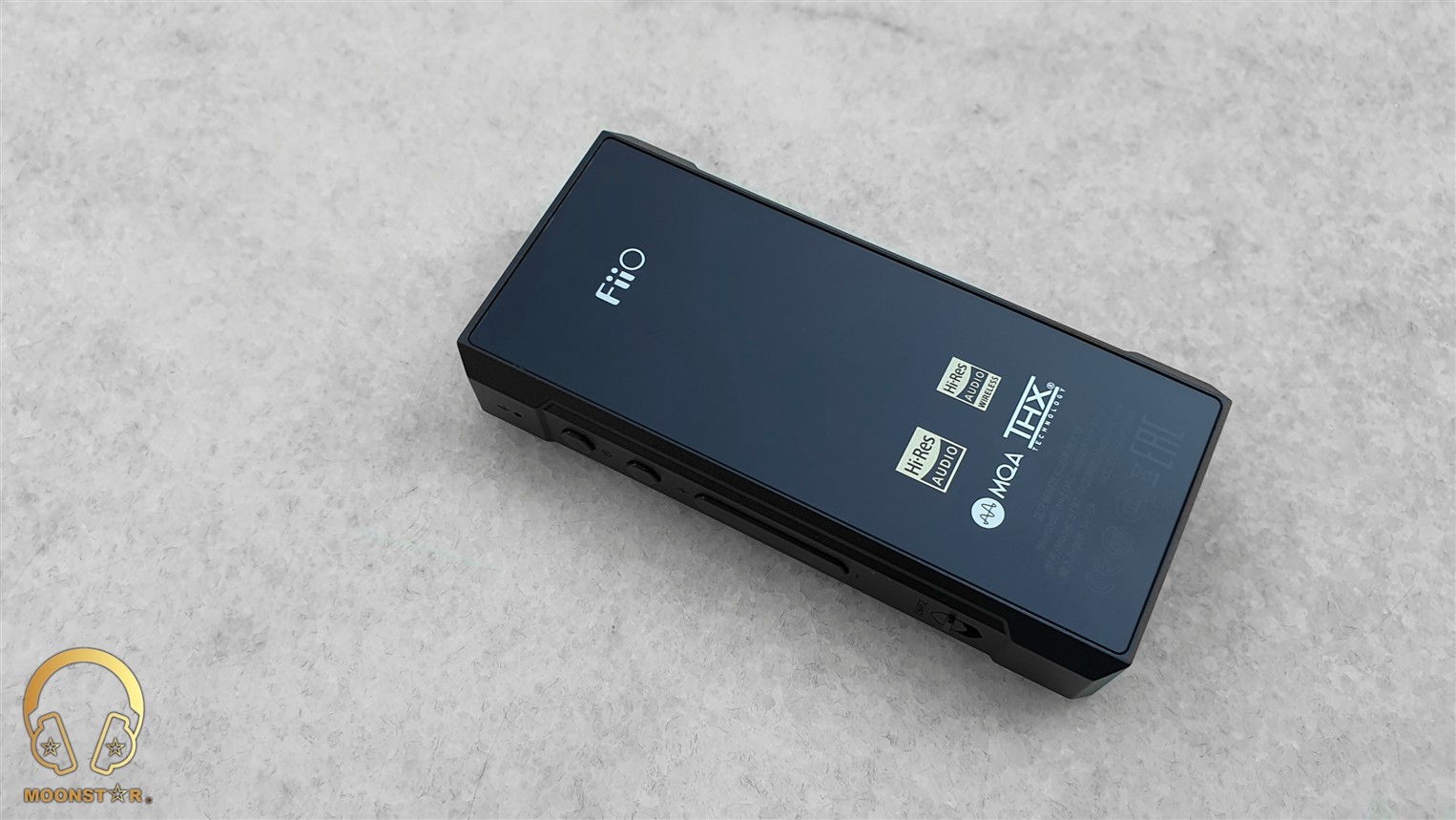
Disclaimer:
I would like to thank FiiO for providing me the FiiO BTR7 as review sample. I am not affiliated with FiiO beyond this review and these words reflect my true and unaltered, opinions about the product.
Price & Availability:
The actual MSRP price for the FiiO BTR7 is 199.99 USD. Detailed information’s can be found under the link below;
Package & Accessories:
The BTR7 came inside a box that is wrapped with a fancy looking black cardboard sleeve that reflects the companies new package design. It shows the illustration of the device and some branding (Hi-Res, LDAC, etc.) on its surface.
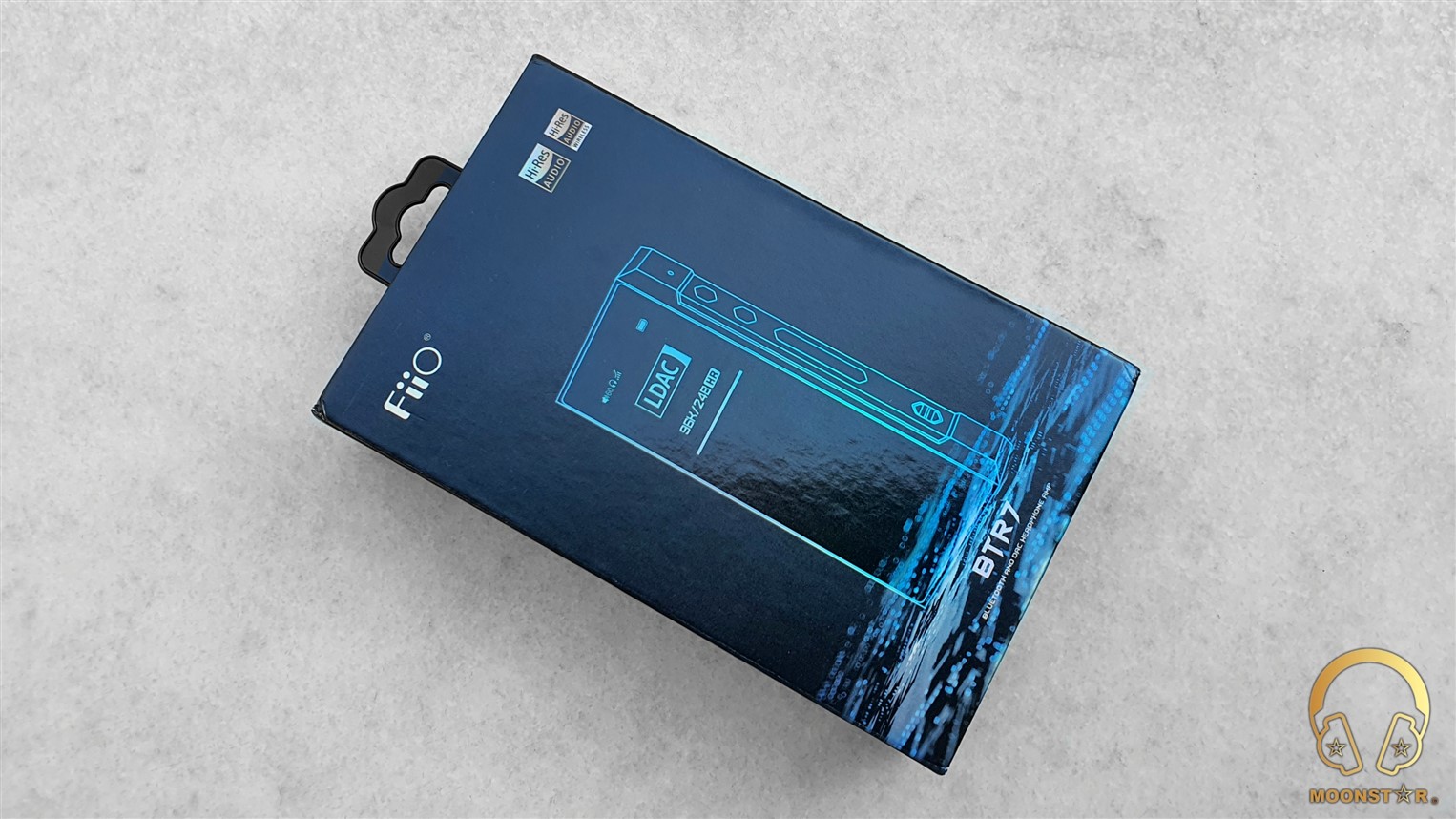
This box is containing the following items/accessories;
- 1 x FiiO BTR7 Portable Bluetooth DAC/Amplifier
- 1 x USB A to USB Type-C cable for data cable and charging
- 1 x USB Type-C to USB Type-C Low Profile Data Cable
- 1 x Leather Case
- 1 x Quick Start Guide
- 1 x Warranty card
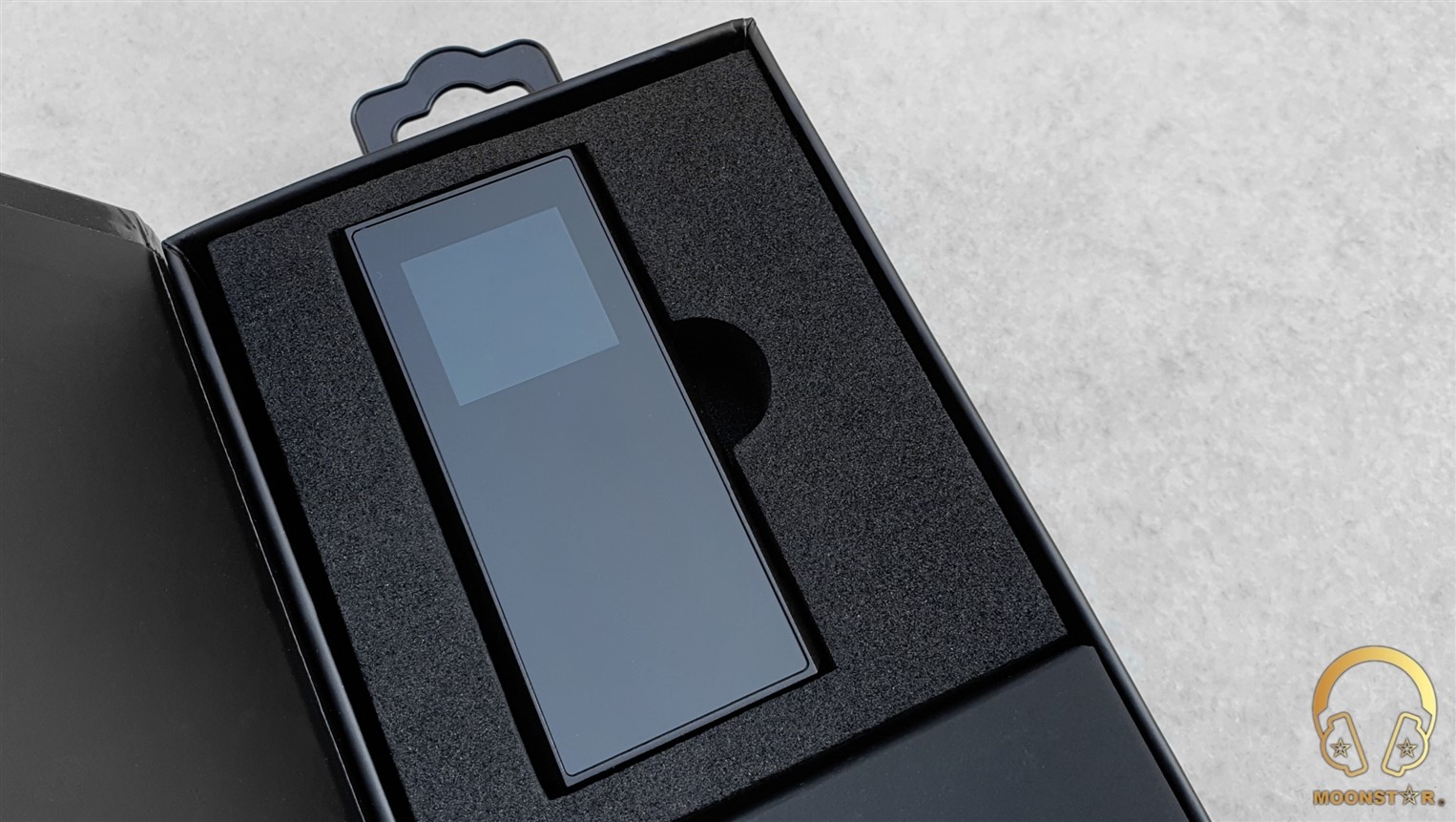
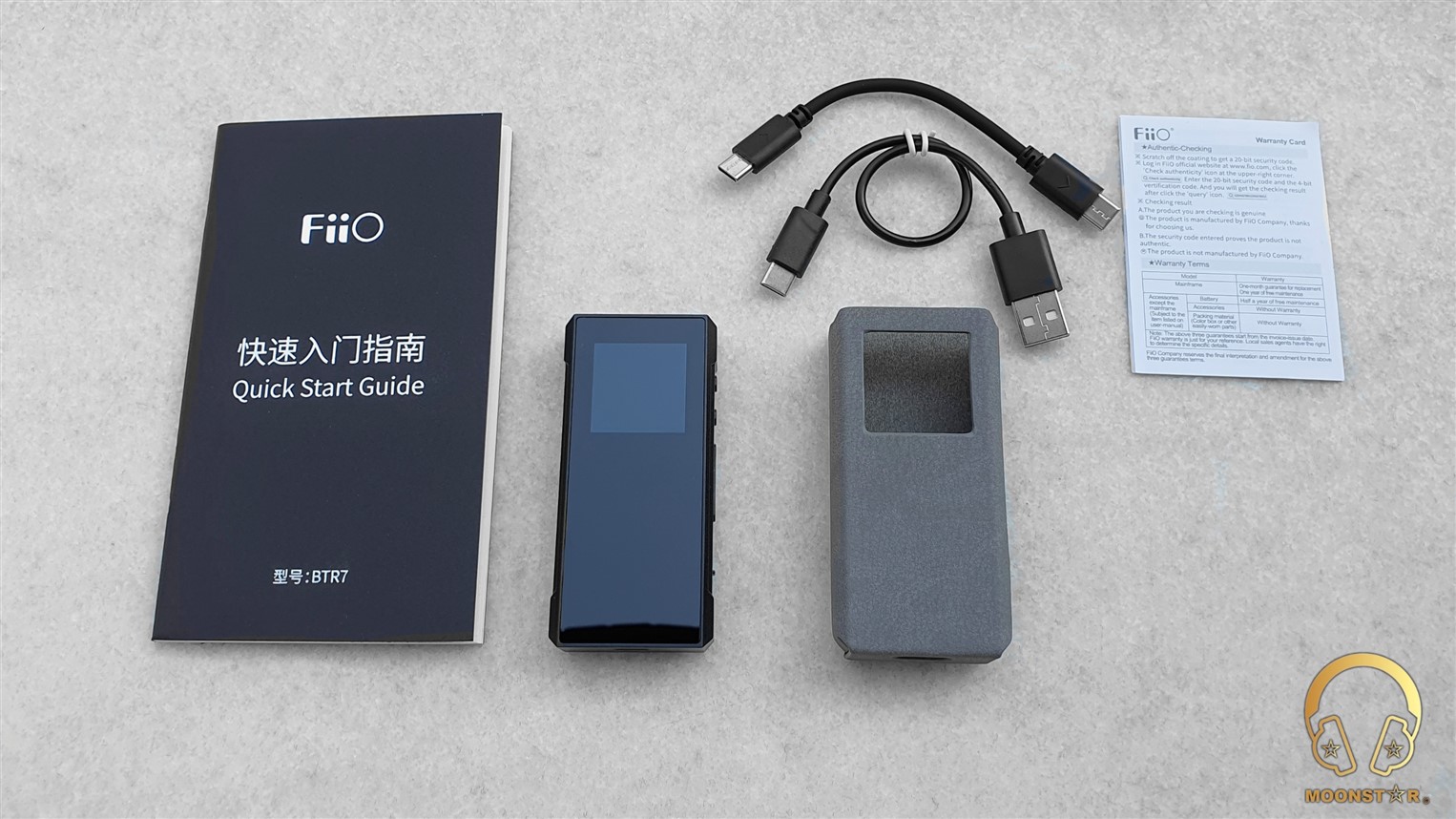
The BTR7 comes with a very well made and design wise very esthetic looking premium leather case in grey color.
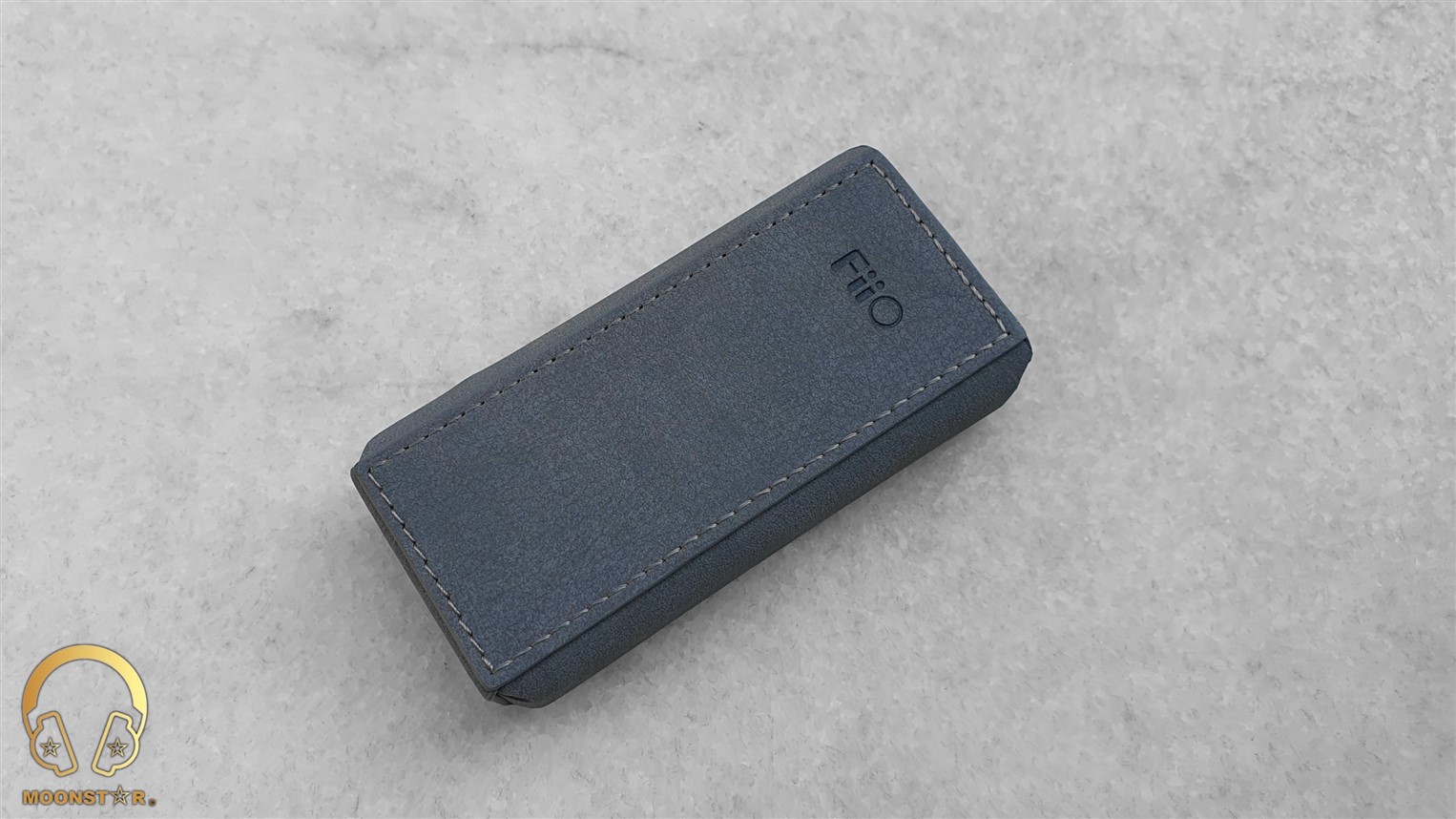
The leather case has an excellent craftsmanship.

The right surface has the button assignment that makes it easier to navigate.
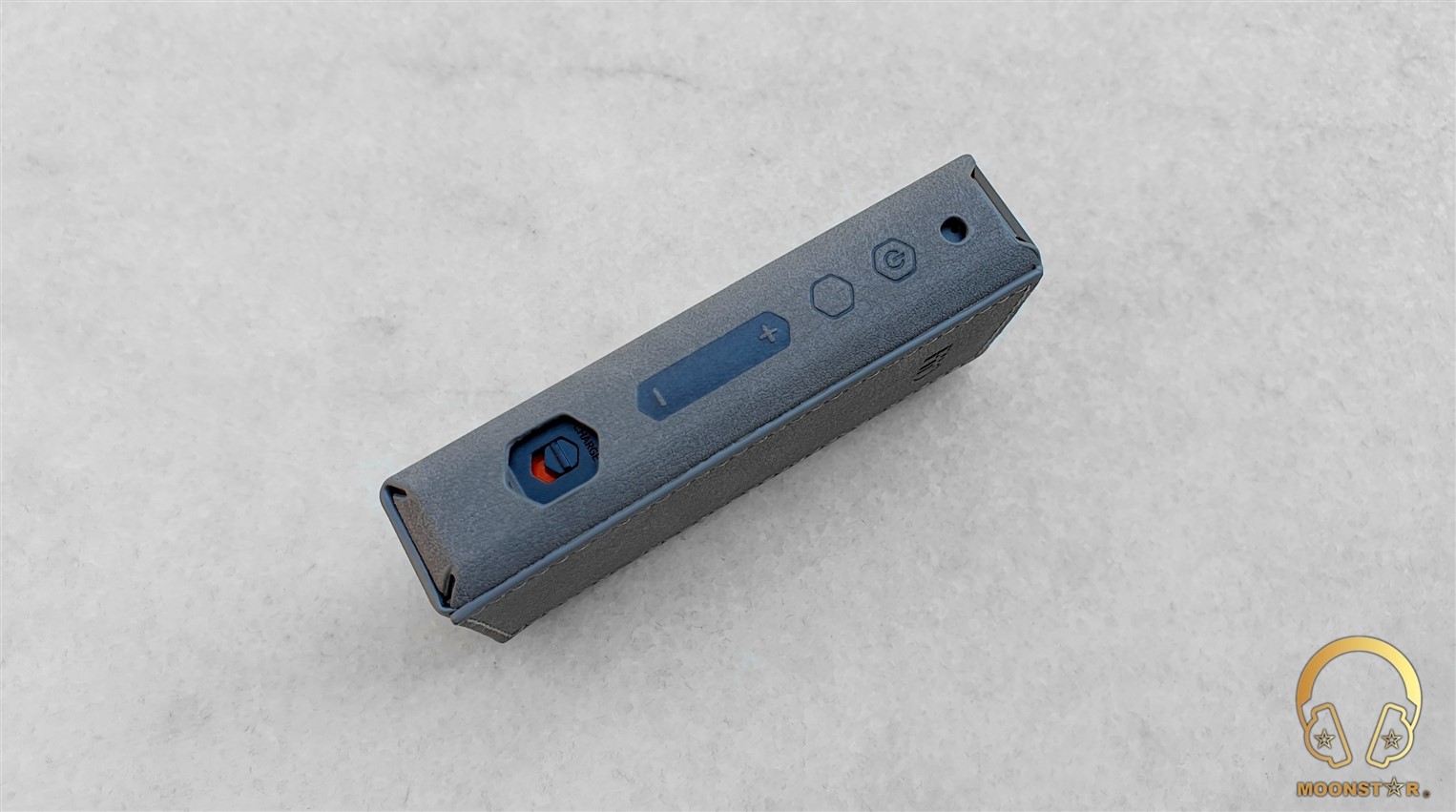
It is great to see that FiiO has added such a nice leather case in to the box of the BTR7.

Design & Build Quality:
The BTR7 is a gorgeous looking little device that reflects FiiO’s new design langue that adopts some pretty similar esthetic elements we have seen on devices like the M11 Plus. The FiiO BTR7 a very portable and pretty lightweight Bluetooth DAC/Amplifier with dimensions of about 39.6x83.6x14.6mm that weights only about 68 grams, ideal to throw it in to your pocket and use it on the go.

The main chassis is made from laminated aluminum alloy material with a black fisnish that reminds me to the look of the M11 Plus that I really like to hold in my hand. The overall build quality of the devices is excellent same like any other FiiO product and fulfills my expectation from a device at this price level.
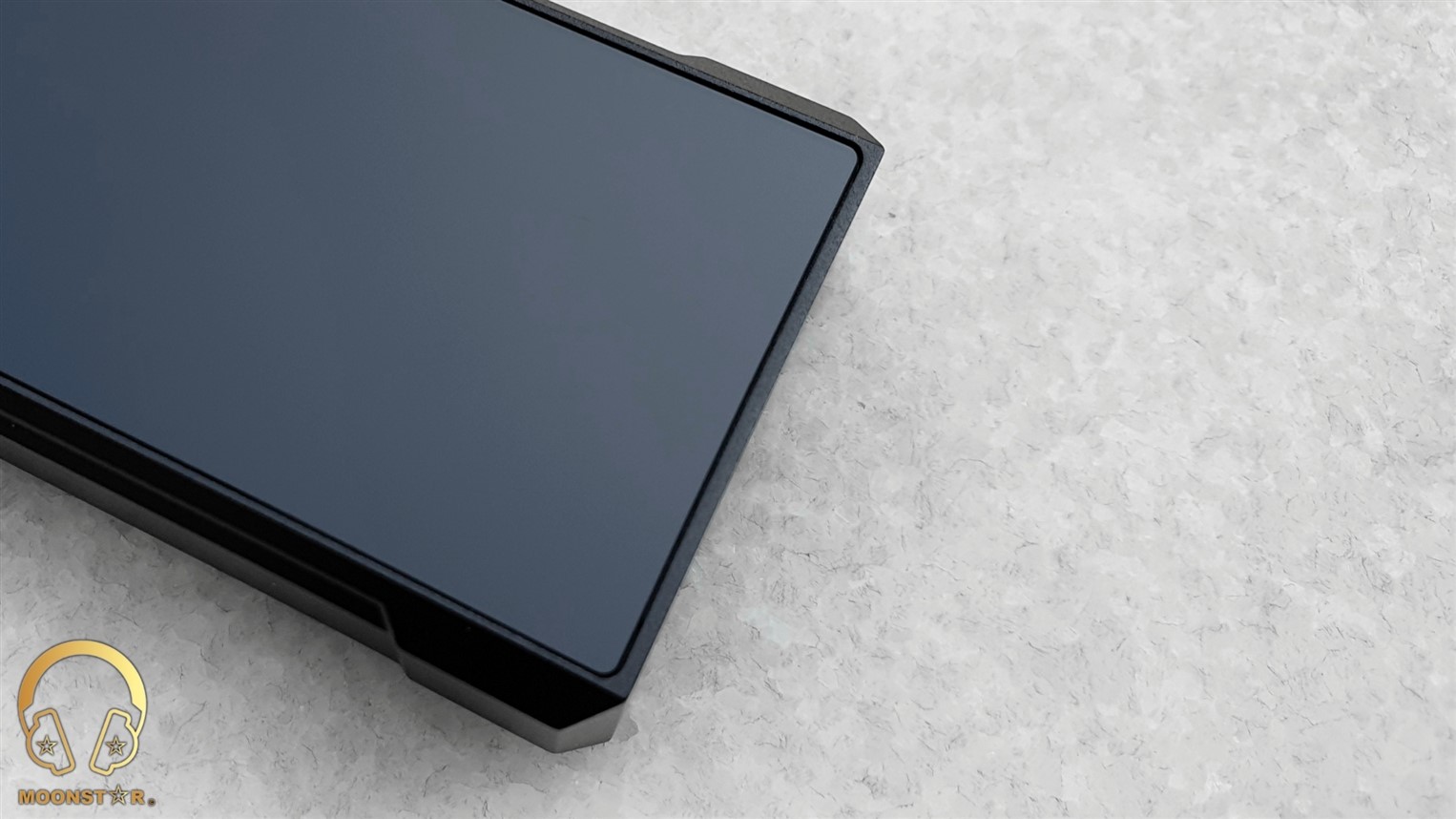
The BTR7 is the first devise of the BTR Series that comes with a color display. The display is located on the top of the front surface that is laminated behind the glass surface that covers the surface of this area.
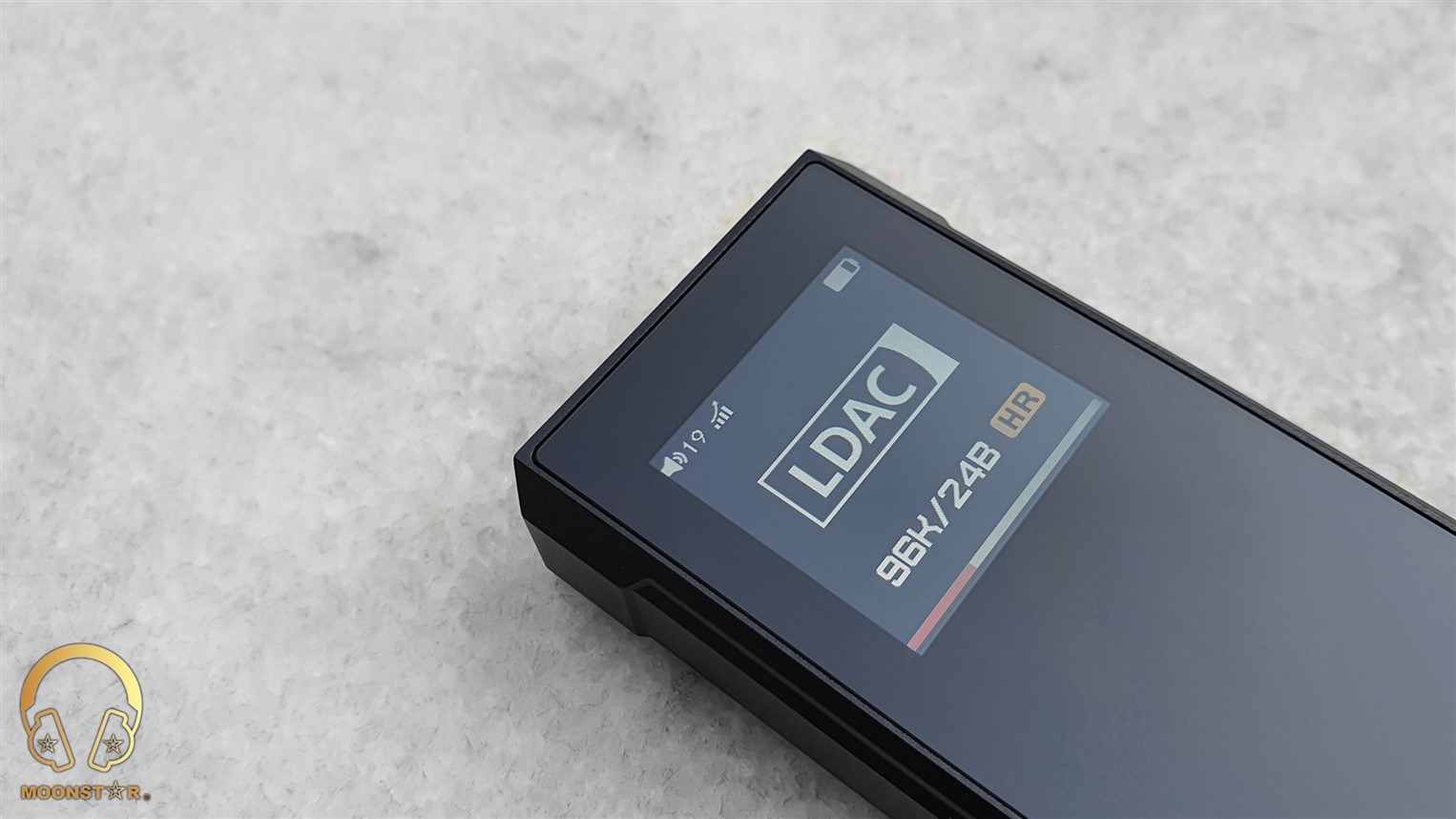
It’s a 1.3 inch IPS color display with a pixel density of 240x240 that is used to display a new UI specially designed for the new BTR7.

The main screen gives information about battery, gain, volume status and many more. Moreover you can see the actual Bluetooth Pairing status, Bluetooth Codec, while there is a submenu that gives you access to the settings (Filters, EQ, Display Brightness, etc.) of the device.
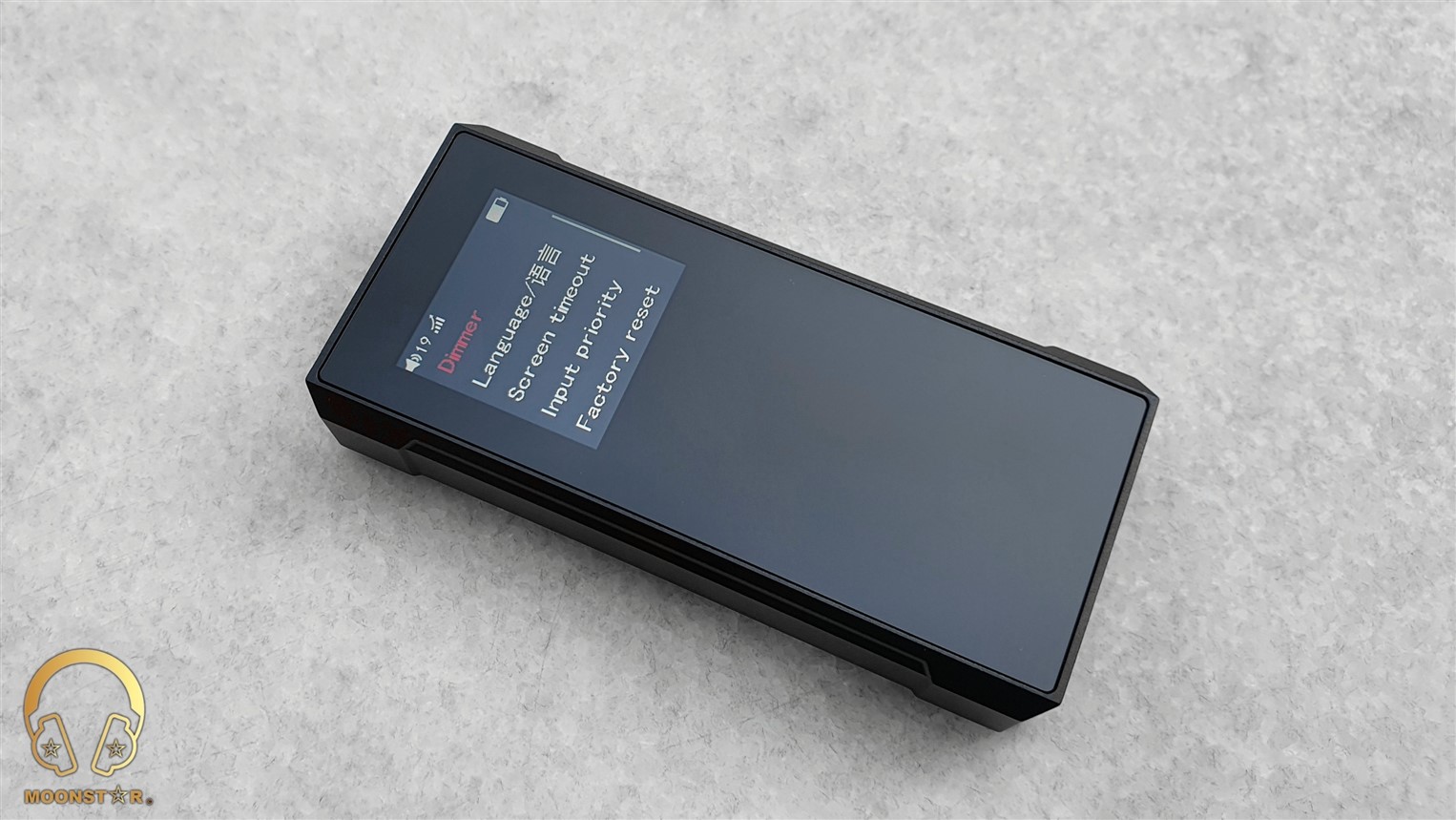

The right surface of the device sports a small opening for the microphone that is dedicated for voice calls, which is a nice addition.
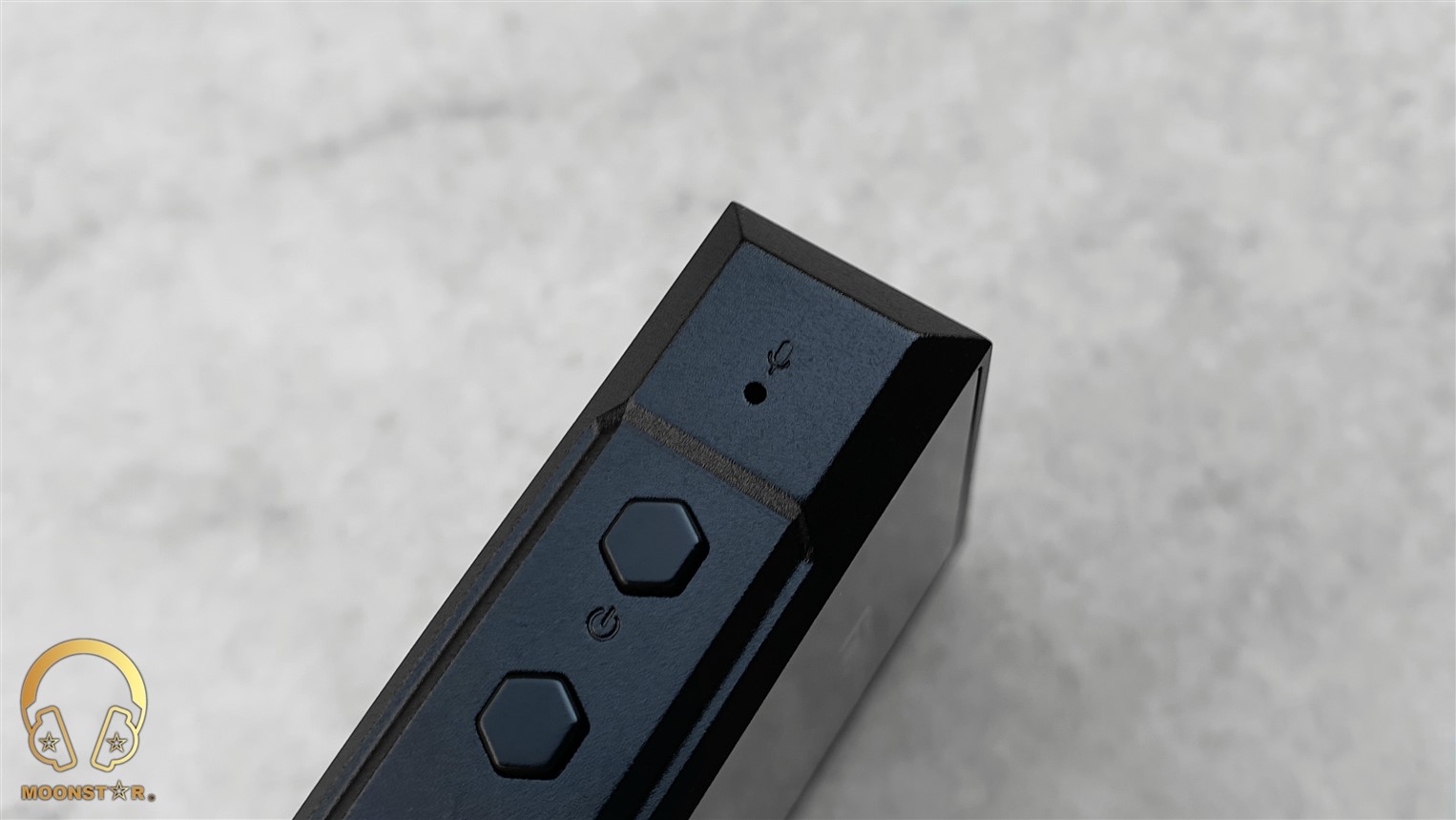
Hear are also the multifunctional power button (power on/off, activate menu, exit menu, etc.), the Play/Pause Button (works also as reconnect, pairing, confirm, voice assistant activation, button), Navigation button (Volume Up/Down, Previous/Next Track) and the charging switch.

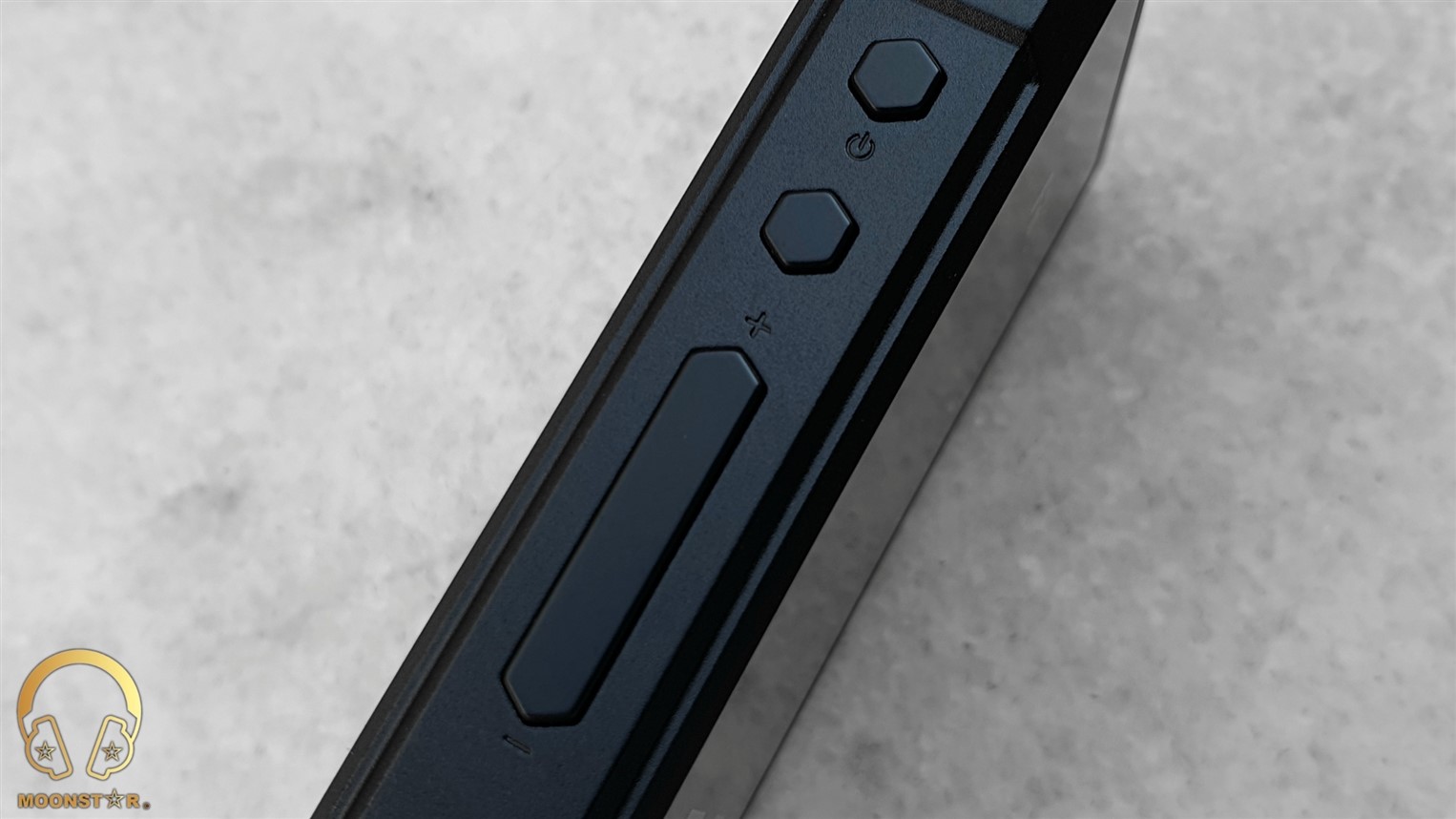
Near the bottom of these surface is the charging switch that has a nice hexagonal design. This switch is a smart solution inn order to easly stop the charging of the device while connected to a USB source, which is good fro the healt of the build in battery.
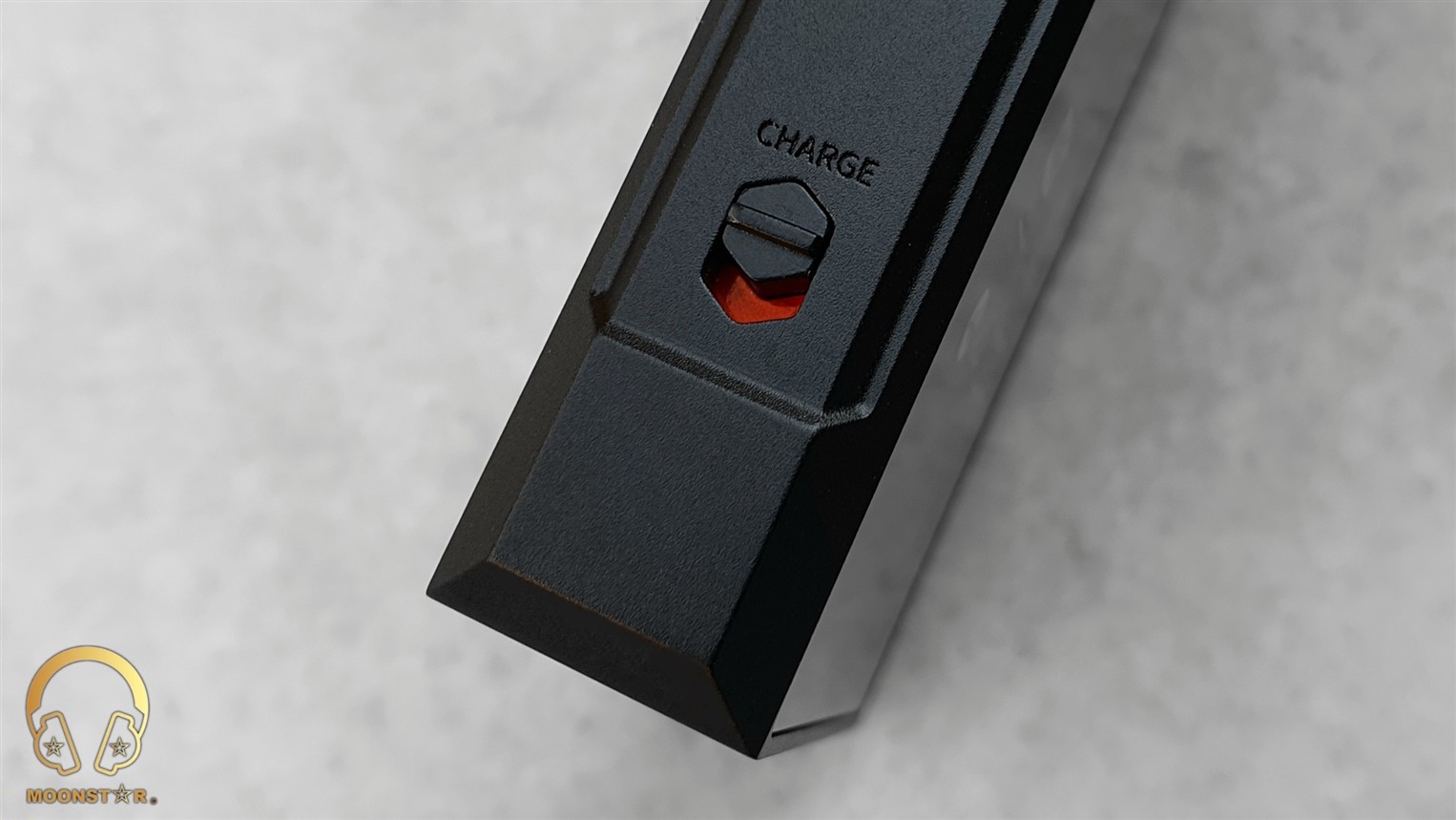
However, the navigation takes a bit of getting used to, if you want to access the submenus, especially when you use it with the leather case.
On the top of the BTR7 are the 4.4mm Balanced and 3.5mm Single Ended analog outputs.
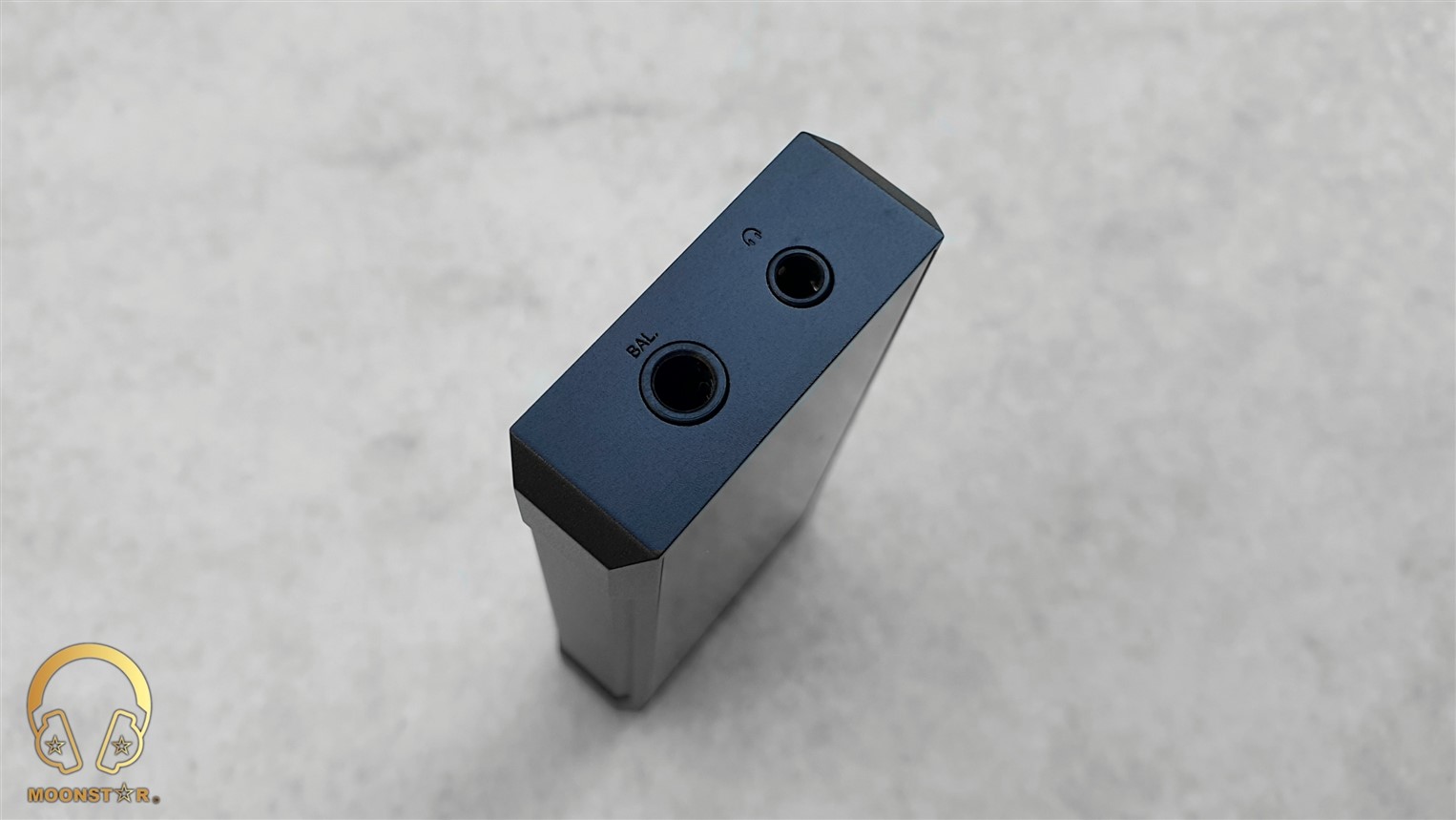
At the bottom of the device is the USB Type-C Data (for USB DAC purposes) and charging port.

At the rear side of the device is a glass surface that sports the FiiO brand logo on the top.
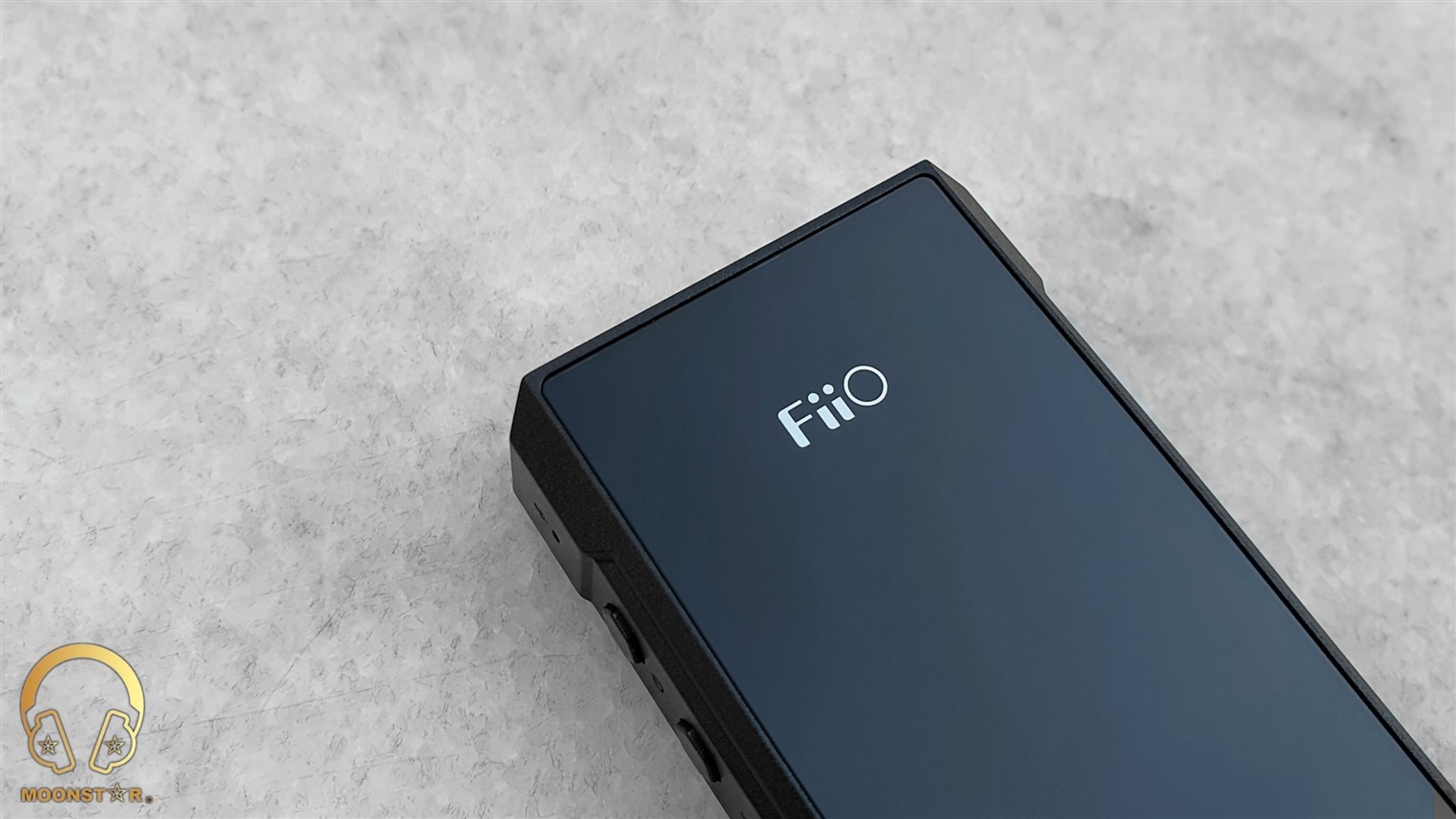
Near the bottom are the Hi-Res Audio/Hi-Res Audio Wireless, MQA, THX logos and some industrial standards and certifications about the device.
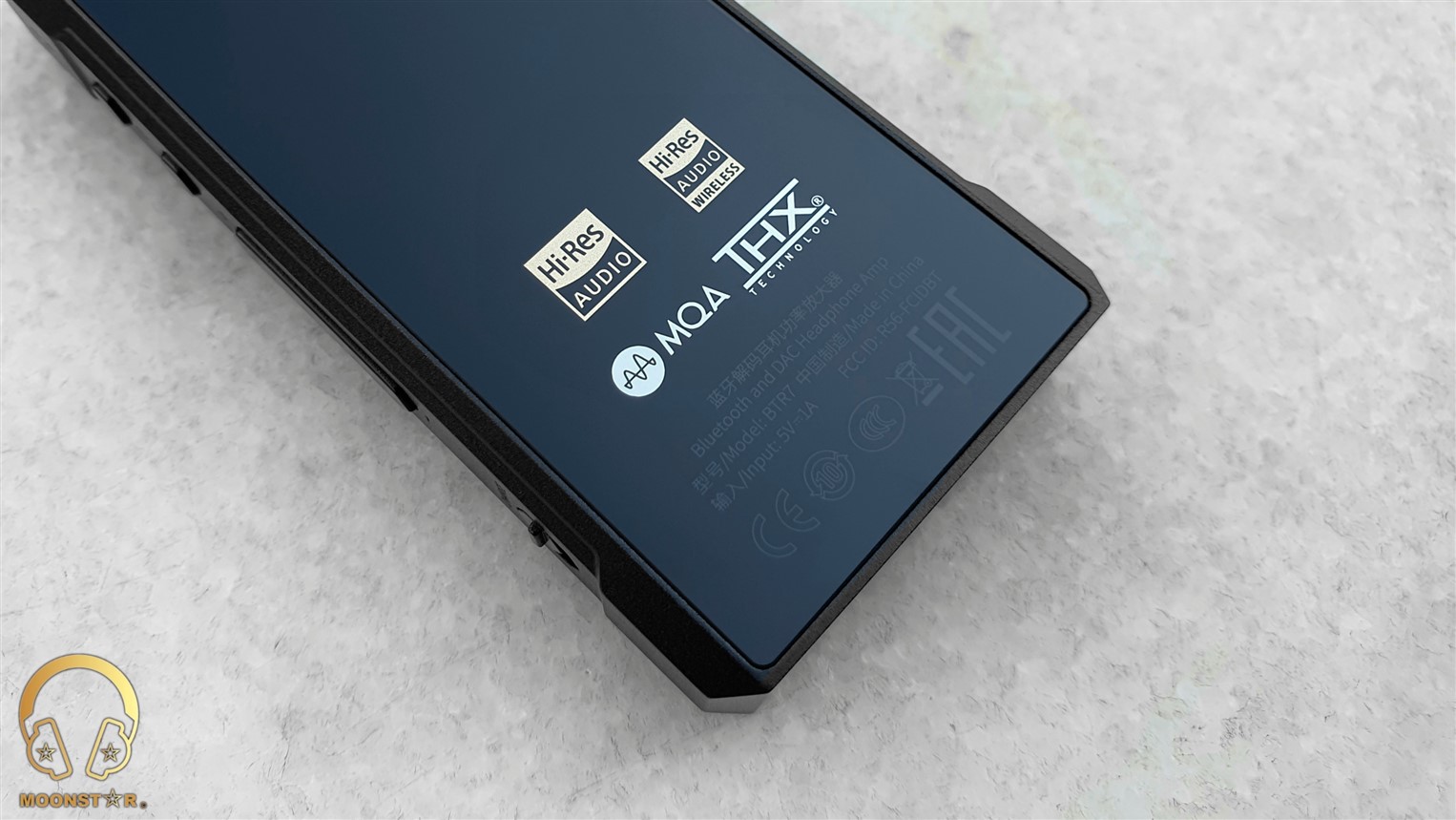
Technical Specifications:
- Model : BTR7
- Display : 1.3 inch IPS Color Display with 240x240 resolution
- Bluetooth Chip : Qualcomm QCC5124
- Bluetooth Version : Bluetooth V5.1
- Supported Codec’s : AAC, SBC, aptX, aptX Low Latency, aptX HD, LDAC and LHDC
- DAC : 2x Sabre ESS9219C
- Frequency Response : 20~20kHz(aptX connection), 20~50kHz(LDAC connection)
- THD+N : PO<0.00055% / Balanced <0.00048%
- SNR : PO≥118dB (32Ω A-weighted), BAL≥115dB (32Ω A-weighted)
- Sampling Rate : 384kHz/32bit (USB DAC)
- USB in DSD Support : 384KHz 32bit/ DSD256
- Output Interface : 3.5mm Single Ended & 4.4mm Balanced
- Output Power PO : 165mW@16 Ohm / 160mW@32 Ohm / 18mW@300 Ohm
- Output Power BAL : 235mW@16 Ohm / 320mW@32 Ohm / 40mW@300 Ohm
- Output Impedance : PO≤1.8Ω(32Ω loaded) /BAL≤2.8Ω(32Ω loaded)
- Amplitude : PO:2.3Vrms / BAL: 3.2Vrms
- Crosstalk PO : ≥ 75dB
- Crosstalk BAL : ≥ 107dB
- Recommended Imp. : 16~100Ω(PO)/ 16~150Ω(BAL)
- Battery : 880mAH
- Battery Life : approx 9hours
- Wired charging : ≤1.5 hours
- Wireless charging : ≤3 hours
- USB Port : USB Type C
- USB Input : Xmos XU208
- Dimensions : about 39.6x83.6x14.6mm
- Weight : about 68 grams
Hardware & Functionality:
The BTR7 is the flagship Portable Bluetooth DAC & Amplifier and USB DAC of the company that offers some pretty interesting hardware features such like 2 x ES9219C DAC Chips, Qualcomm’s latest QCC5124 Bluetooth Chip, 2x THX AAA-28 amplifiers, XMOS XUF208 Chip, 3.5mm Single Ended + 4.4mm Balanced outputs Wireless Charging and many more.

Dual DAC ESS9219C:
The FiiO BTR7 will feature an ESS9219C SABRE DAC chipset with 32-bit “HyperStream” architecture, which delivers a SNR (Signal to Noise Ratio) of 118dB over both the 3.5mm Single Ended and 4.4mm Balanced (TRRRS) outputs.
Bluetooth & USB DAC Functions:
The FiiO BTR7 comes with Qualcomm’s QCC5124 BT SoC that supports the BT 5.1 protocol and formats like SBC, AAC, aptX LL (LL = Low Latency), aptX HD, aptX Adaptive and LDAC.
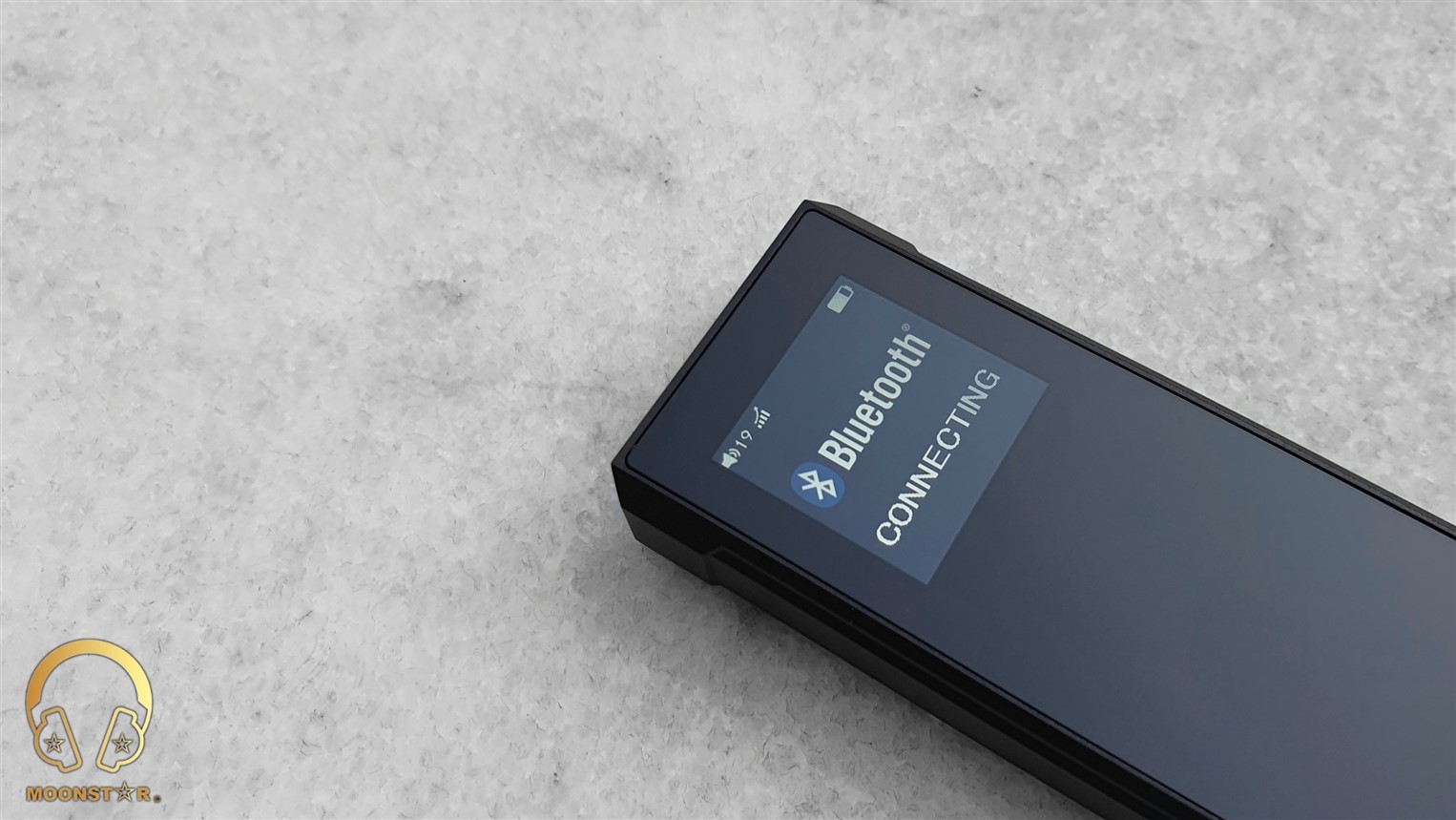
Moreover, the BTR7 is a very capable All-in One device that offers Hi-Res USB Input capabilities, in addition to its lossless Bluetooth format support. The BTR7 will be equipped with a XMOS XUF208 chip that gives it the ability to work as USB DAC/Amplifier, which will support sampling rates up to 32 bit/384kHz and Native DSD256.
Outputs & Amplification (THX AAA):
The FiiO BTR7 offers a fully balanced audio architecture, which means that each channel is driven separately. It will be equipped with both 3.5mm Single Ended (TRS) and 4.4mm Balanced (TRRRS) balanced outputs.
Another remarkable feature is the THX AAA™ "Achromatic Audio Amplifier” design that was used to create a clean and pretty powerful analog output. The 3.5mm Single Ended interface has an output power of 150mW @ 32ohm, while the 4.4mm Balanced port is even more powerful with up to 300mW @32ohm.
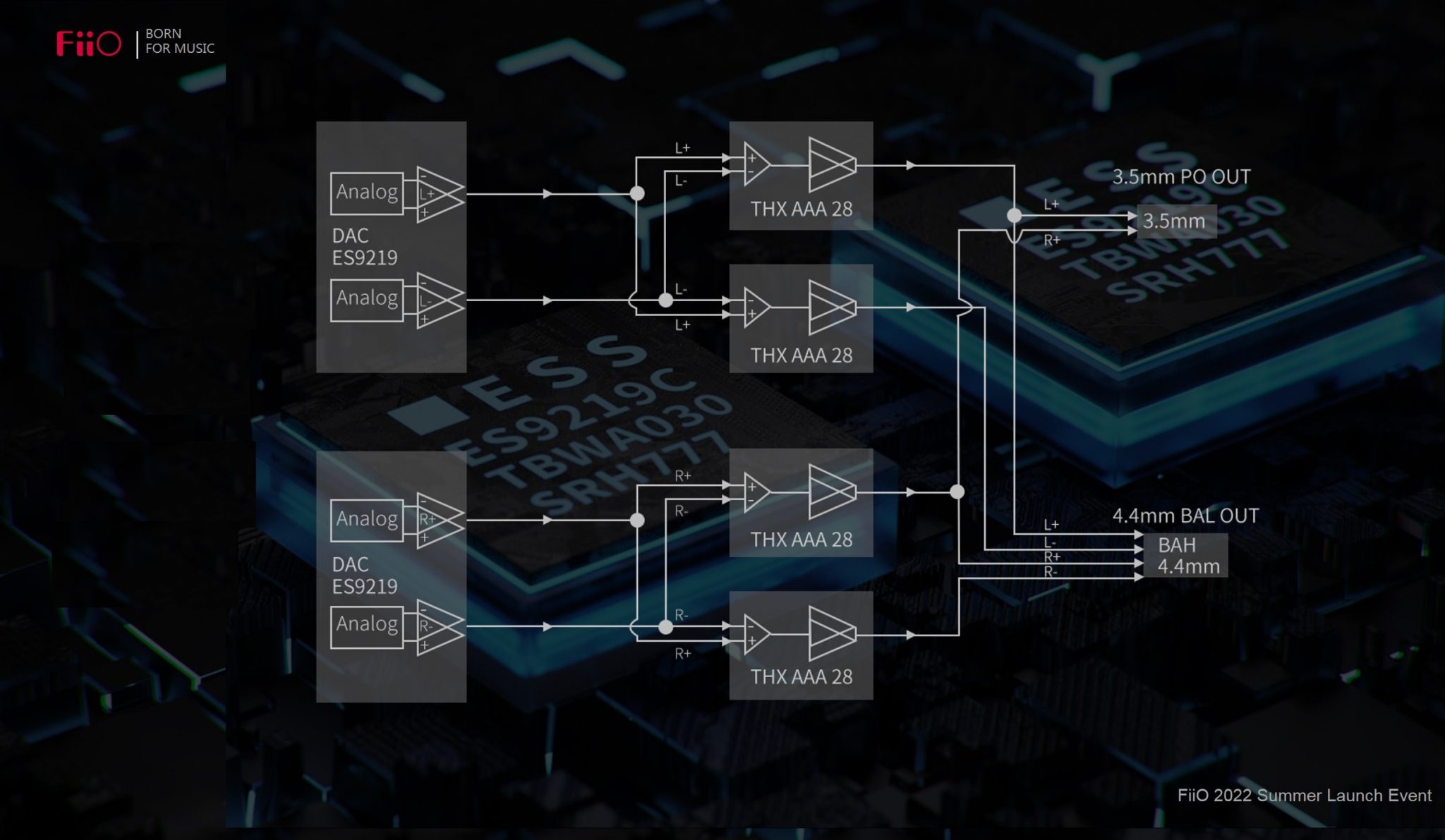
Bluetooth Performance & Pairing:
The BTR7 comes with FiiO’s patented metal frame antenna design in order to archive a stable and interference-free Bluetooth connection, which seems to work pretty well!
The Bluetooth operating distance of the FiiO BTR7 up to a distance of 9 - 10 meters in open areas, while latency starts about 6 meters if there is a wall. The BTR7 benefits from its LDAC and aptX LL (LL = Low Latency) codec support, which is a remarkable feature while watching a Video on YouTube, Netfix, Amazon, etc. I didn’t noticed any remarkable lip-sync issue, when paired with my Samsung Galaxy Note 10Plus

The pairing of the FiiO BTR7 with sources like Android/iOS phones, tablets, etc are quite easy. Just power on de device and the device will automatically start in pairing mode.
Battery Life & Wireless Charging:
The FiiO BTR7 comes with a 880mAh built-in battery that offers up to 9 hours of continues audio playback with the AAC over the 3.5mm balanced output. The charging process will take about 1.5 hours over the USB Type-C port.
The battery life of the BTR7 is pretty good, especially for its size and output power. Here are some results and testing conditions.
- ~ 9 hours – AAC Codec, 3.5mm SE Output, Volume %50
- ~ 7 Hours – LDAC, 3.5mm SE Output, Volume %50
- ~ 6 – 6.5 Hours – LDAC, 4.4mm Balanced Output, Volume %40
The BTR7 is the first Bluetooth DAC/Amp that supports wireless charging, which is a great addition. I have used my Samsung Note 10 Plus as Wireless charging source that worked perfectly.
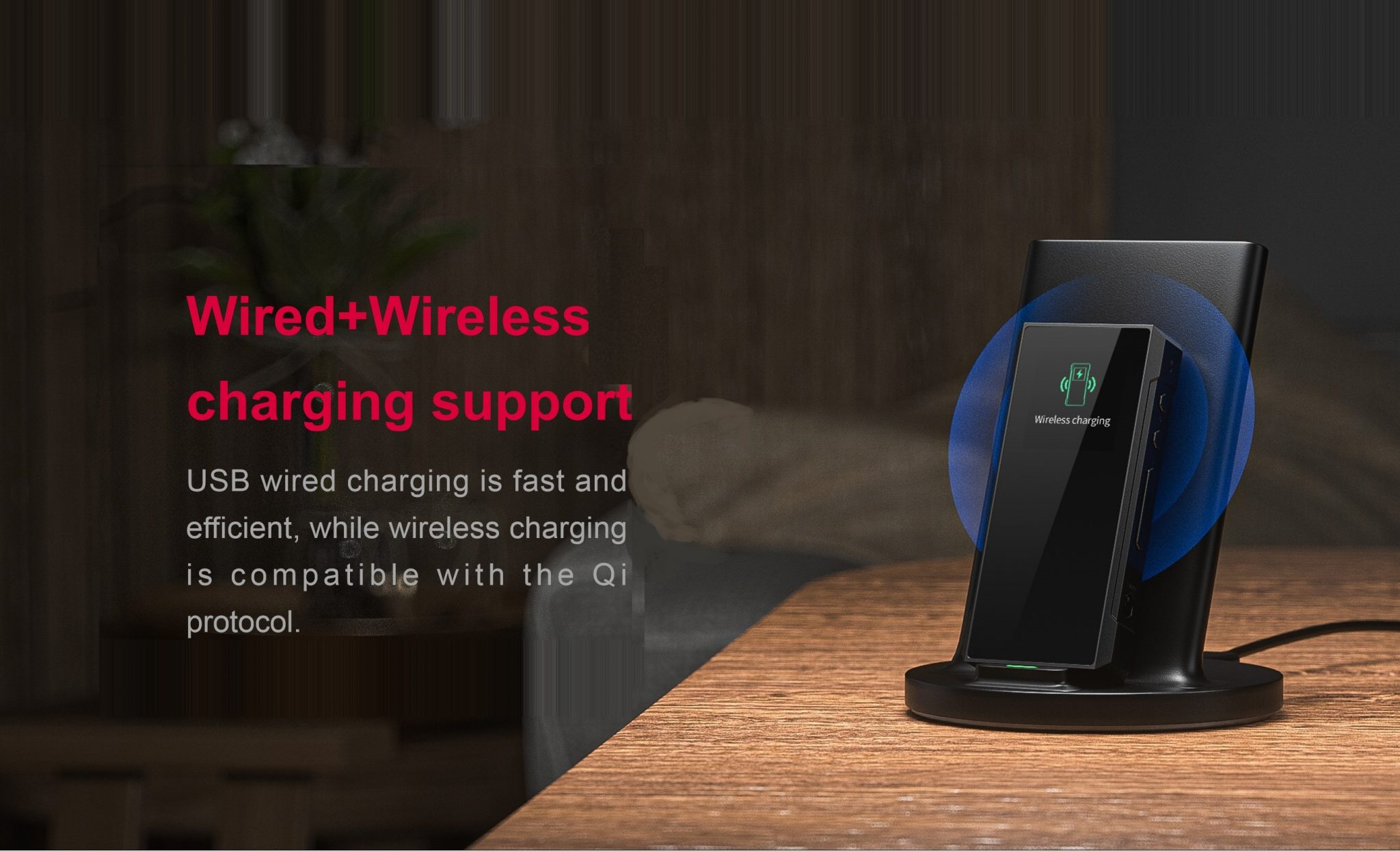
Background Noise / Hissing:
The sound output over both the 3.5mm Single Ended and the 4.4mm Balanced outputs is very clean in terms of white noise. There is nearly zero hissing and a pretty dark background, which is quite impressive. Such a clean output means that you will have better conditions to concentrate to the details in your song.
Microphone:
The FiiO BTR7 is equipped with an omnidirectional built-in microphone that offers a decent noise cancellation performance. The performance of the build-in microphone was pretty good during some of my voice conversations.

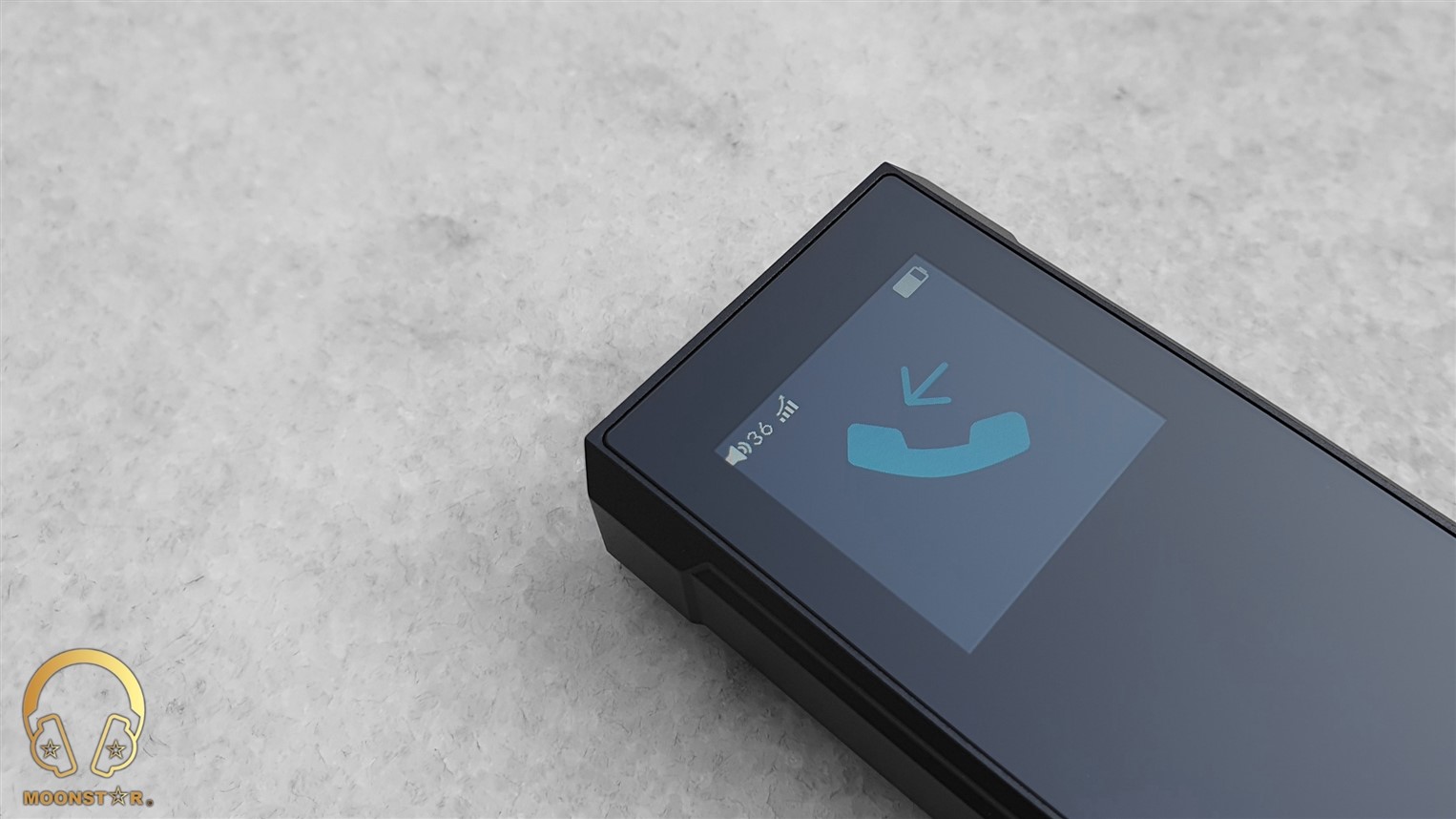
MQA Support:
The FiiO BTR7 supports the latest MQA decoding to experience Master Quality Audio files. The source device should be loaded with MQA supported software such as UAPP, Tidal, etc.
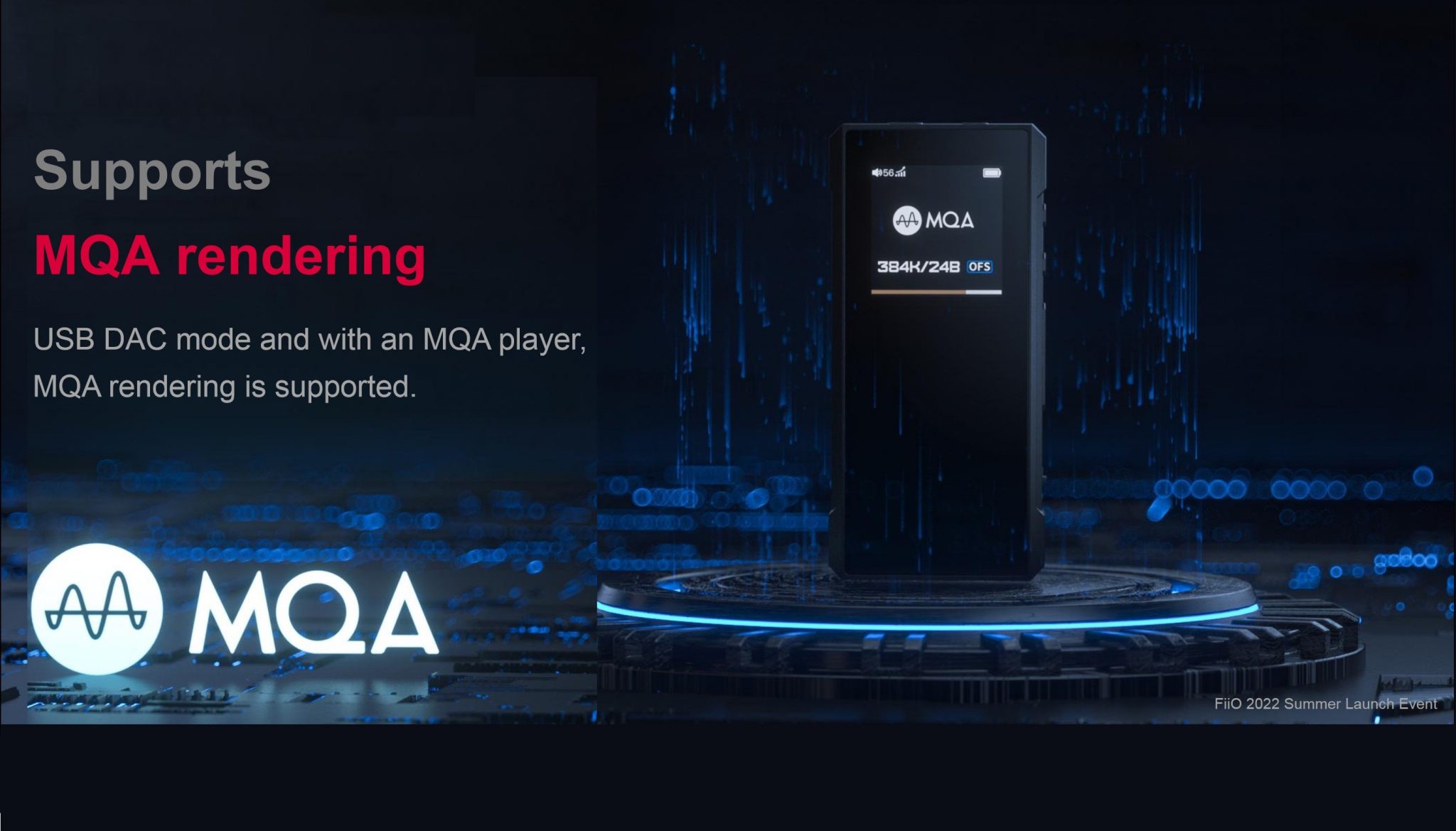
FiiO Control App:
The BTR7 supports FiiO’s Control Application that allows for managing different functions on the units. You can adjust the EQ settings, Channel Balance and other Audio options of the device. Even an OTA (Over the Air) FW update is possible.

Equipments used for this review:
- BT DAC/AMP : FiiO BTR7, Shanling UP5
- Sources : FiiO M11 Plus, Samsung Note 10 Plus
- IEM’s : FiiO FH9, FiiO FA7S, Meze Audio ADVAR
- Headphones : Moondrop Void
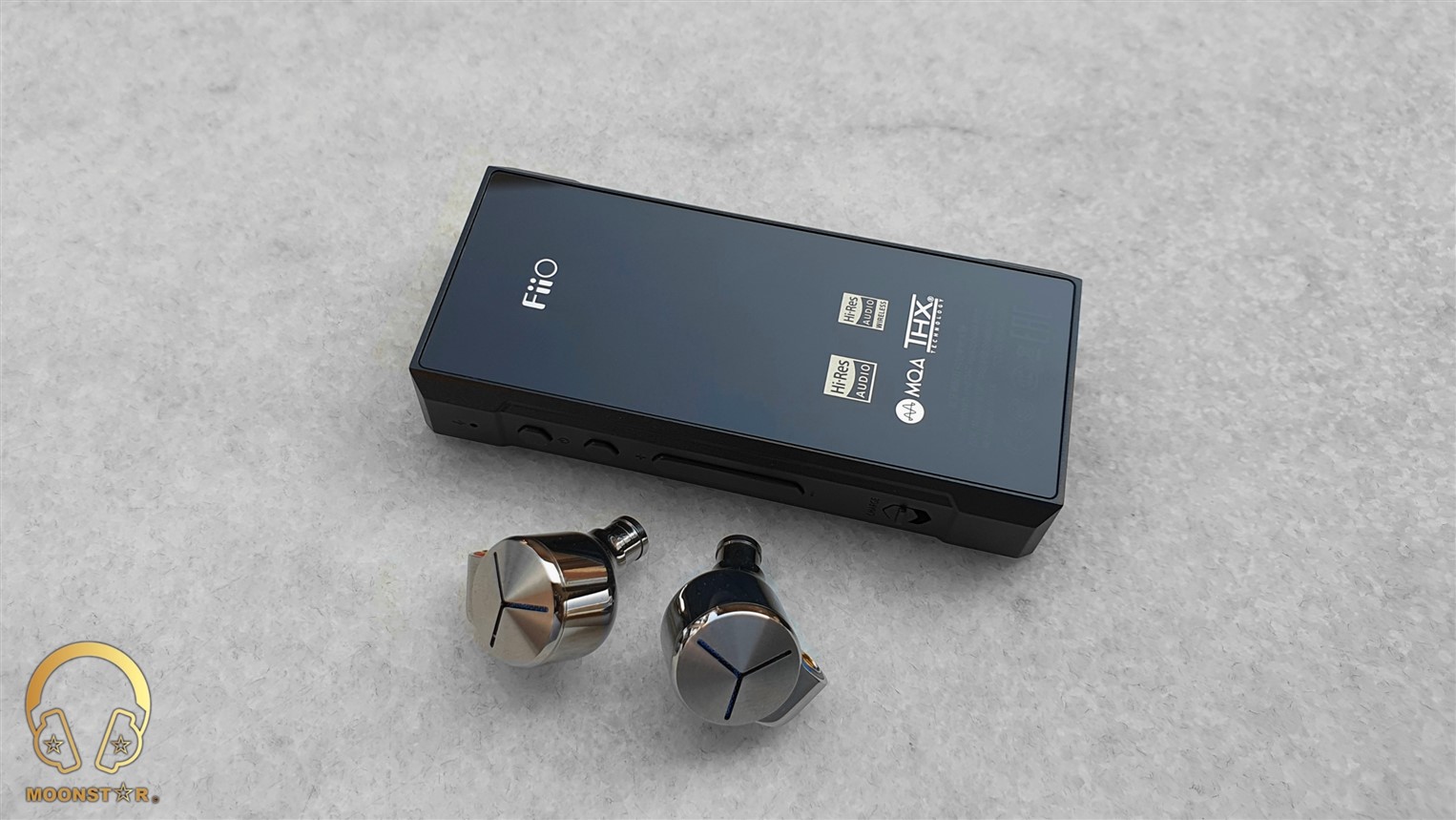
Albums & tracks used for this review:
- Adele – My Little Love (Spotify)
- Randy Crawford – On Day I Will Fly Away (Flac 16bit/44.1kHz)
- Hayley Westenra – Odyssey Album (Dezzer HiFi)
- Dionne Warwick – Walk On By (Flac 16bit/44.1kHz)
- Sarah McLachlan – Angel (Flac 24bit/48kHz)
- Sertap Erener – Aşk (Flac 16bit/44.1kHz)
- Edith Piaf – Non Je Ne Regrette Rien (Flac 16bit/44.1kHz)
- Diana Krall – So Wonderful (DSF)
- Aretha Franklin – I Say A Little Payer (Flac 24bit/96kHz)
- Sonya Yoncheva – (Giuseppe Verdi) II Trovatore, ActI (Flac 24bit/96kHz)
- George Michael – Don’t Let the Sun Go Down on Me (Flac 24bit/192kHz)
- David Bowie – Heroes (Flac 24bit/192kHz)
- Elton John – Rocket Man ((Flac 24bit/96kHz)
- Barry White – Just The Way You Are (Flac 24bit/48kHz)
- Isaac Hayes – Walk On By (Flac 16bit/44.1kHz)
- Sting – Englishman in New York – (Flac 24bit/48kHz)
- Eric Clapton – Wonderful Tonight (Flac 24bit/96kHz)
- B.B. King – Riding With The King (Tidal Hi-Fi)
- Dave Gahan – Kingdom (Tidal Hi-Fi)
- U2 – Sunday Bloody Sunday (Flac 16bit/44.1kHz)
- Bro Safari, UFO! – Drama (Deezer HiFi)
- Armin Van Buuren – Vini Vici (Flac 16bit/44.1kHz)
- Daft Punk – Doin’ it Right (Flac 24bit/96kHz)
- Jo Blankenburg – Meraki (Spotify)
- Lorde – Royals (Flac 24bit/48kHz)
- Massive Attack – Angel (Flac 24bit/48kHz)
- Toutant – Rebirth (Deezer HiFi)
- Gogo Penguin – Raven (Flac 24bit/192kHz)
- Gogo Penguin – Murmuration (Flac 24bit/192kHz)
- GoGo Penguin – Fanfares (Flac 24bit/192kHz)
- Portishead – It Could Be Sweet (Spotify)
- Max Richter – On the Nature of Daylight (Flac 24bit/96kHz)
- Charly Antolini – Duwadjuwandadu (Flac 24bit/192kHz)
- Ferit Odman – Look, Stop & Listen (Flac 24bit/192kHz)
- Chopin – Nocturn No. 20 In C-Sharp Minor (Flac 16bit/44.1kHz)
- Fazıl Say – Nazım Oratoryosu (Live) (Flac 16bit/44.1kHz)
- Vivaldi – Le QuarttroStagioni “The Four Season” (Deezer HiFi)
- Otto Liebert& Luna Negra – The River (Flac 24bit/192kHz)
- Lunatic Soul – The Passage (Flac 16bit/44.1kHz)
- Deftones – My Own Summer (Shove it) (Flac 16bit/44.1kHz)
- Metallica – Sad but True (Flac 24bit/96kHz)
- Opeth – Windowpane (Flac 16bit/44.1kHz)
- Megadeth – Sweating Bullets (Tidal Hi-Fi)
- Rush’s – Leave That Thing Alone (Flac 16bit/44.1kHz)
- Slayer – Angel of Death (Spotify)
- Liquid Tension Experiment 2 – Acid Rain (Spotify)
- Yosi Horikawa – Bubbles (Spotify)

The Sound:
The FiiO BTR7 offers a pretty clean, natural and detailed overall presentation, while it shows a tad warmer than neutral tonality. The lows are shown with a good level of body/volume, depth and authority, the midrange has a decent sense of clarity and resolution, while the treble range is represented with successful grade of separation, extension and sparkle.
This review has been written after a burn-in period of about 50 hours. My sound impressions below are based on my experiences over the 4.4mm Balanced output paired with IEM’s like the FiiO FH9, Meze Audio ADVAR and FiiO FA7S.
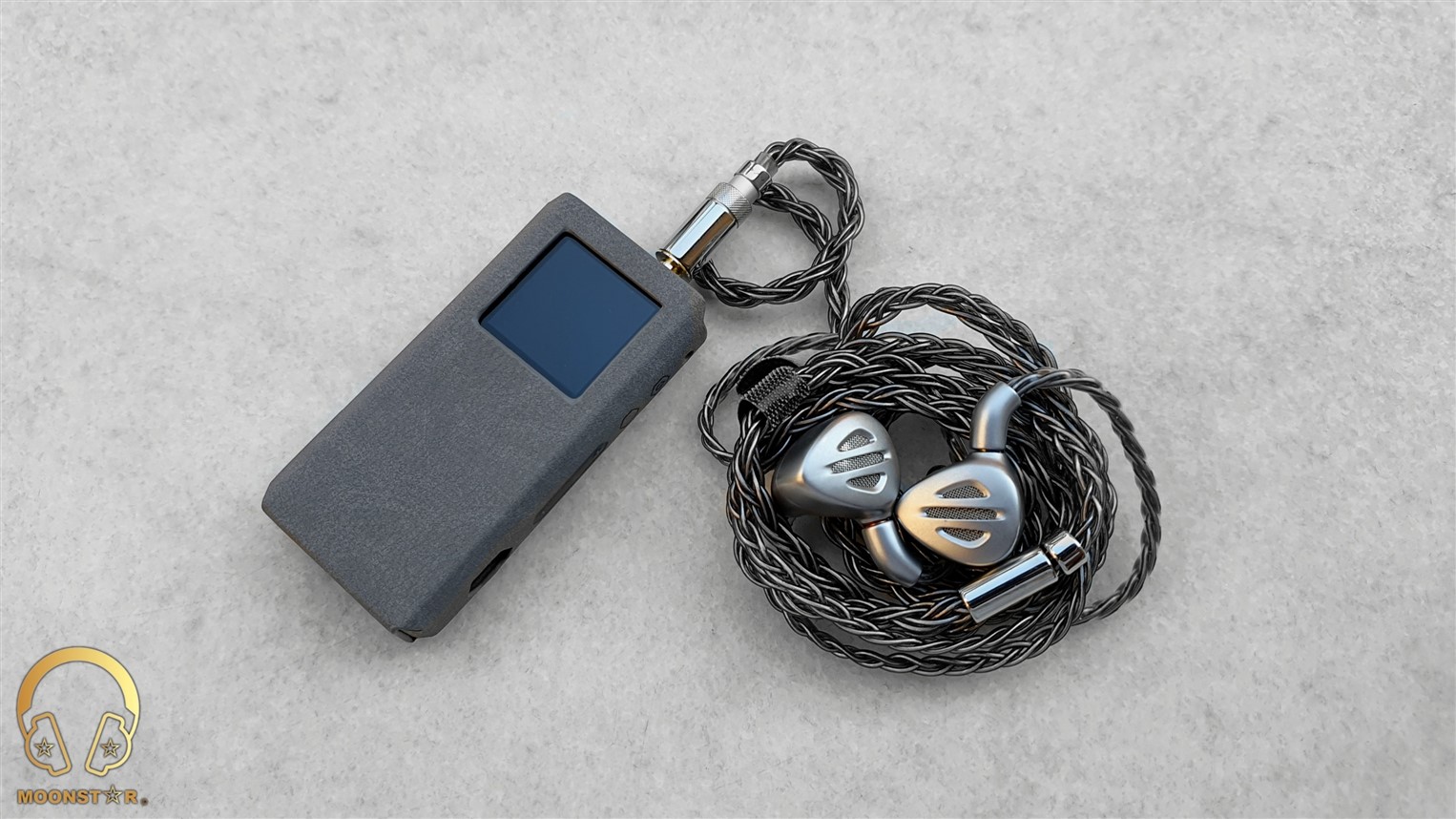
Bass:
The lower frequency region of the FiiO BTR7 sounds pretty uncolored and detailed. Both the subbass and the midbass regions are shown in a clean and controlled manner. The subbass area has a good level of rumble and intensity when I do pair the BTR7 with the FiiO FH9 an do listen to songs like Lorde’s “Royals”, Massive Attack’s “Angle” or Armin Van Buuren’s "Vini Vici" that do sound pretty exiting.
The midbass area sounds again pretty transparent and detailed, without to have negative conditions such like a midbass hump or mixings when I do listen to fast and complex passages such like Gogo Penguin’s “Murmuration”. Percussion instruments such like cross drums or brass instruments like trumpets do sound pretty accented and are reproduced with a mildly warm tonality. Other instruments such like electro and acoustic guitars are shown with a good amount of body and warmth, while toms and kick drums are punchy and quite musical when I do pair the device with my FA7S.

Midrange:
The FiiO BTR7 has a fairly neutral and quite detailed and spacious overall midrange presentation. It has a slightly warmer than neutral tonality that avoids a too sterile and dry atmosphere in this area. The sense of airiness and transparency is pretty good, epically when I do listen to it with the Meze Audio ADVAR.
Male vocals such like George Michael, Barry White or Sting do sound lively and emotional, which is an audible improvement after the BTR5. Female vocals on the other hand are reproduced in a pretty vivid, detailed and emotional manner. Female voices including soprano vocals such like Sertap Erener and Hayley Westenra did sound fairly controlled and emotional both when paired with the FiiO FA7S and Meze Audio ADVAR, without to show a remarkable sibilance or harshness.
The successful sense of transparency and airiness found in the midrange of the BTR7 creates good conditions for instruments. They are shown with a good level of separation for an Ultra Portable BT DAC/AMP, which is a remarkable advantage you do listen to songs with complex and relative instrument dense passages such like GoGo Penguin’s “Fanfares”. Instruments such like pianos, cymbals, flutes or cellos are reproduced in a pretty detailed, lively and fairly natural manner.
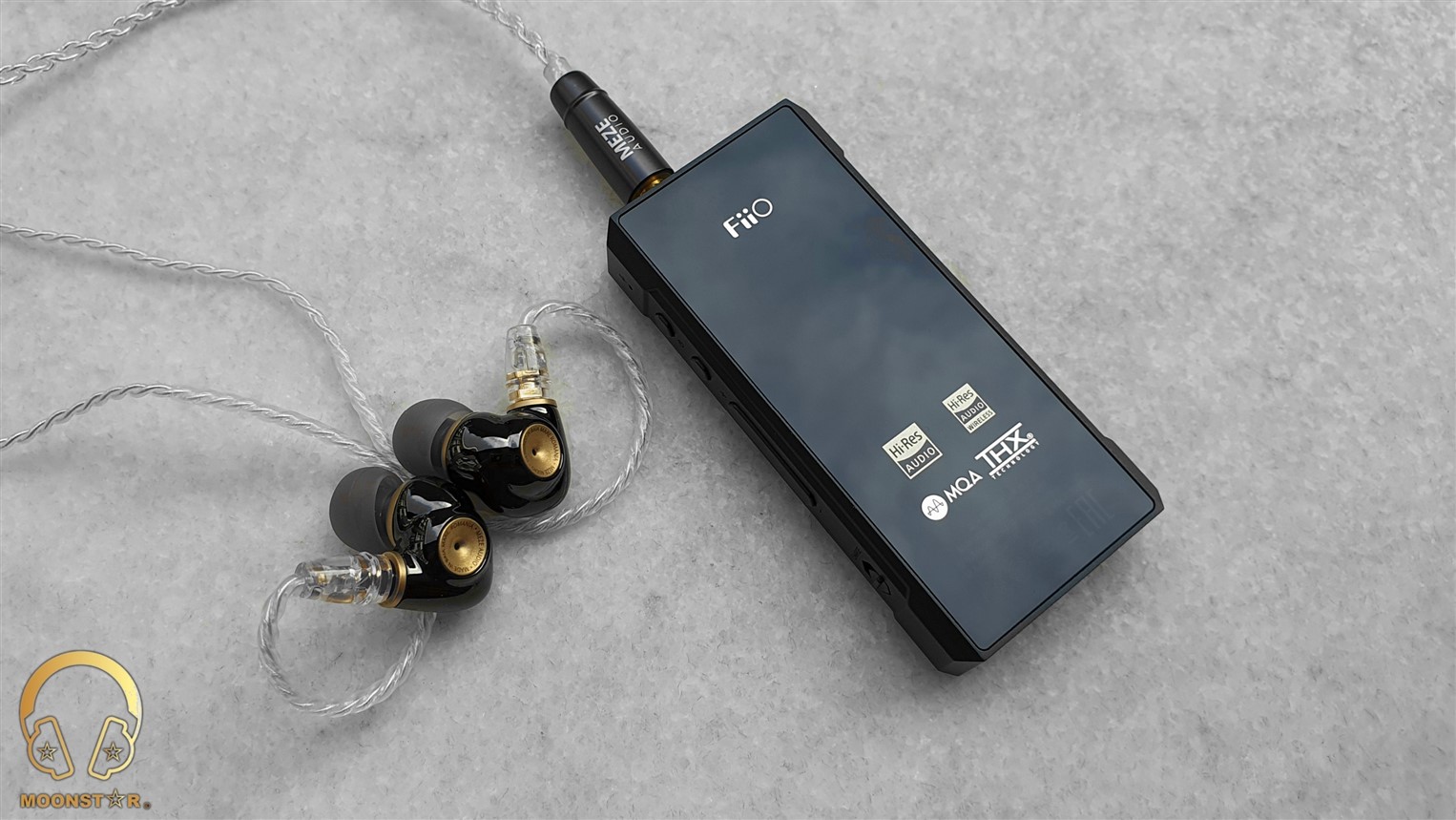
Treble:
The FiiO BTR7 shows a fairly natural and almost uncolored treble response with solid grade of resolution that will definitely fulfill your expectation from an ultra portable source at this price range.
A remarkable plus point of the treble range is the authority & control that the BTR7 offers in this area. Songs with fast and complex instrument transitions such like Charly Antolini’s “Duwadjuwandadu” are reproduced in a pretty controlled way.
The BTR7 is able to produce a decent sense of resolution and sparkle in this area, when I have listened to it with both the FiiO FH9 and Meze Audio ADVAR. Instruments from violins to synthesizers, from pianos to flutes do sound quite natural and musical, without o be show unwanted sharpness.
Other treble intensive instruments such like cymbals or hi-hats in both jazz and metal music do sound nicely pronounced, fairly detailed and are shown with a good grade of extension that doesn’t falls short.

Soundstage & Imaging:
The FiiO BTR7 offers a quite natural and realistic soundstage atmosphere along with a pretty successful sense of airiness and space, which creates good conditions for a precise placement of instruments and vocals. The soundstage shows a sufficient level of depth and wideness that won’t disappoint you with respect of a device at this price tag.
Comparison:
FiiO BTR7 versus Shanling UP5:
The Shanling UP5 is another portable All-in One BT & USB DAC Amplifier, which is the direct concurrent of the FiO BTR7. Both devices do have a decent built quality and do share a nice looking glass surface in black color and a pretty ergonomic shape. However, the UP5 has a more rounded shape compared to the BTR7 that reflects FiiO’s 6th Gen 3D cut design with Hexagonal elements. The UP5 and the BTR7 are quite similar went it comes to the width and thickness (BTR7 39.6x14.6mm vs UP5 39x14.5mm), while the BTR7 is taller with 83.6mm versus 68mm that the UP5 has.

The BTR7 and the UP5 do share some similar hardware specs such like 2x ESS Sabre ES9219C DAC’s, Xmos XU208 Chip, 3.5mm SE & 4.4mm Balanced Outputs, while the UP5 has also a 2.5mm Balanced output. Both devices do have a BT Chip implementation that supports the BT 5.1 protocol and all modern codes like AAC, SBC, aptX, aptX Low Latency, aptX HD, LDAC. However the BTR7 comes with Qualcomm’s latest QCC5124 BT SoC, while the UP5 is equipped with the older QCC5120. The BTR7 supports Wireless Charging that the UP5 don’t has, while the UP5 offers NFC connection. The biggest difference should be the IPS Display on the BTR7 that looks more modern compared to OLED screen that is integrated to the UP5.
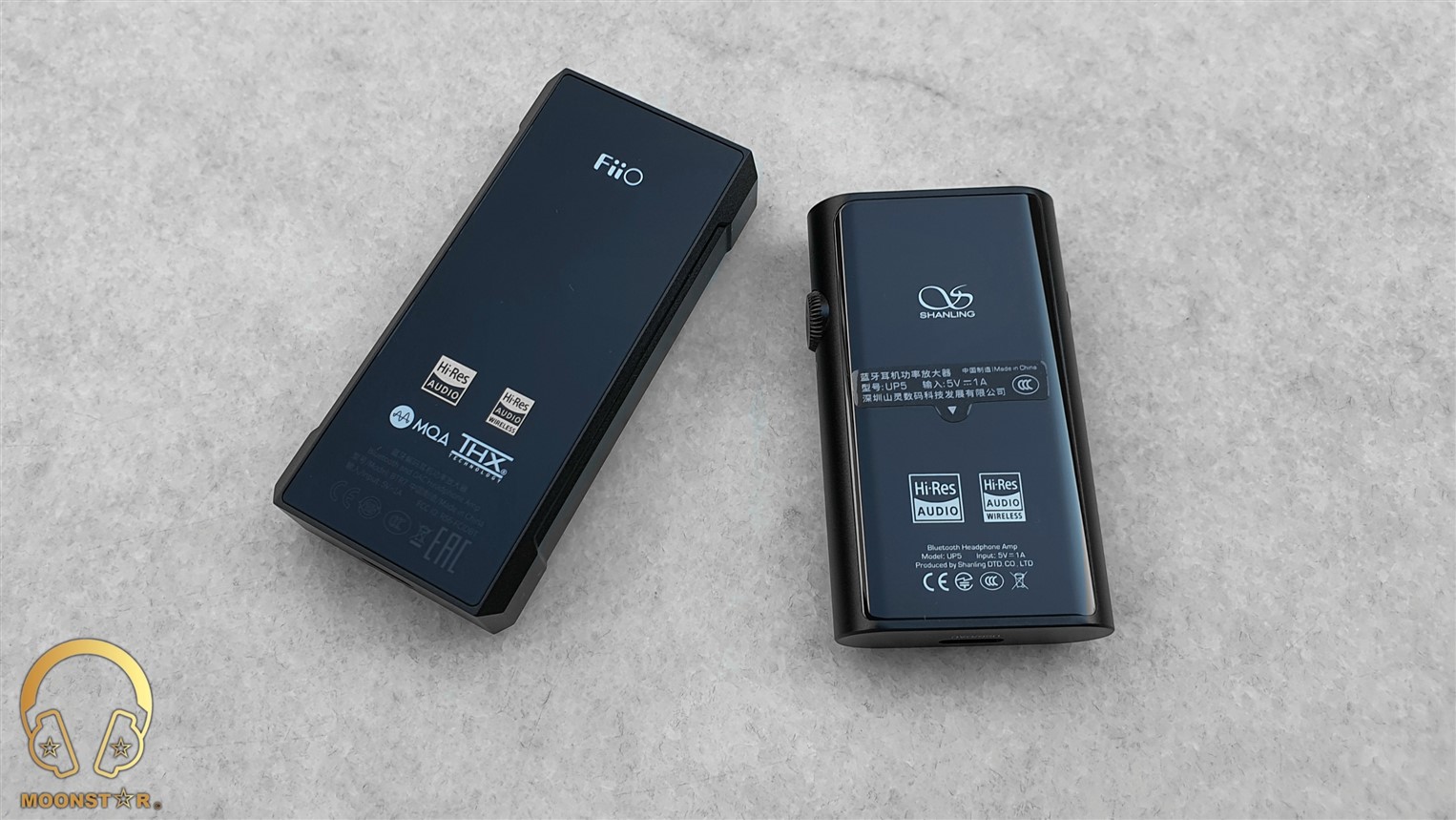
Both the FiiO BTR7 and the Shanling UP5 do come with a powerful amplifier section. The Shanling UP5 offers up to 240mW @32 Ohm over the 4.4mm Balanced output that means plenty of power. However, the BTR7 is equipped with a THX Amplifier section that comes with 2x THX AAA-28 amplifiers that is even more powerful with up to 320mW@32 Ohm over the 4.4mm Balanced output. The FiiO BTR7 and the Shanling UP5 are equipped with built-in batteries with a capability of 880mAh. The UP5 offers up to 11 hours over its Balanced outputs, while the BTR7 last up to 9 hours due to the THX AAA-28 amplifier section that shows a higher power consumption.

When it comes to the sound, I can say that both devices do offer a solid performance that won’t disappoint you. The Sahnling UP5 has a slightly warmer tonality that is typical for Shanling products, while the FiiO BTR7 shows a closer to neutral tonality.
The subbass region of both devices shows a good level of depth and rumble, while the BTR5 has the slightly edge when it comes to the clarity and authority in this area. The midbass region of the BTR7 shows a slightly better sense of layering and sounds a bit more controlled, while both are pretty similar in terms of resolution.
The midrange of the Sahnling UP5 shows a tad warmer tonality compared to the FiiO BTR7, which offers a slightly better grade of transparency and detailed retrieval. The lower midrange of the UP5 sounds a bit fuller than the BTR7, which has the upper hand when it comes to the clarity and authority in this area. The Shanling UP5 is slightly behind the FiiO BTR7 in terms of overall technical performance and resolution, both in the upper midrange and treble region.
Both devices are pretty successful when it comes to the soundstage performance, especially for their price. However, the FiiO BTR offers in general a better sense of airiness and spaces between instruments. The BTR7 has the slightly edge when it comes to the wideness of the stage, while the difference in terms of depth is quite minimal.
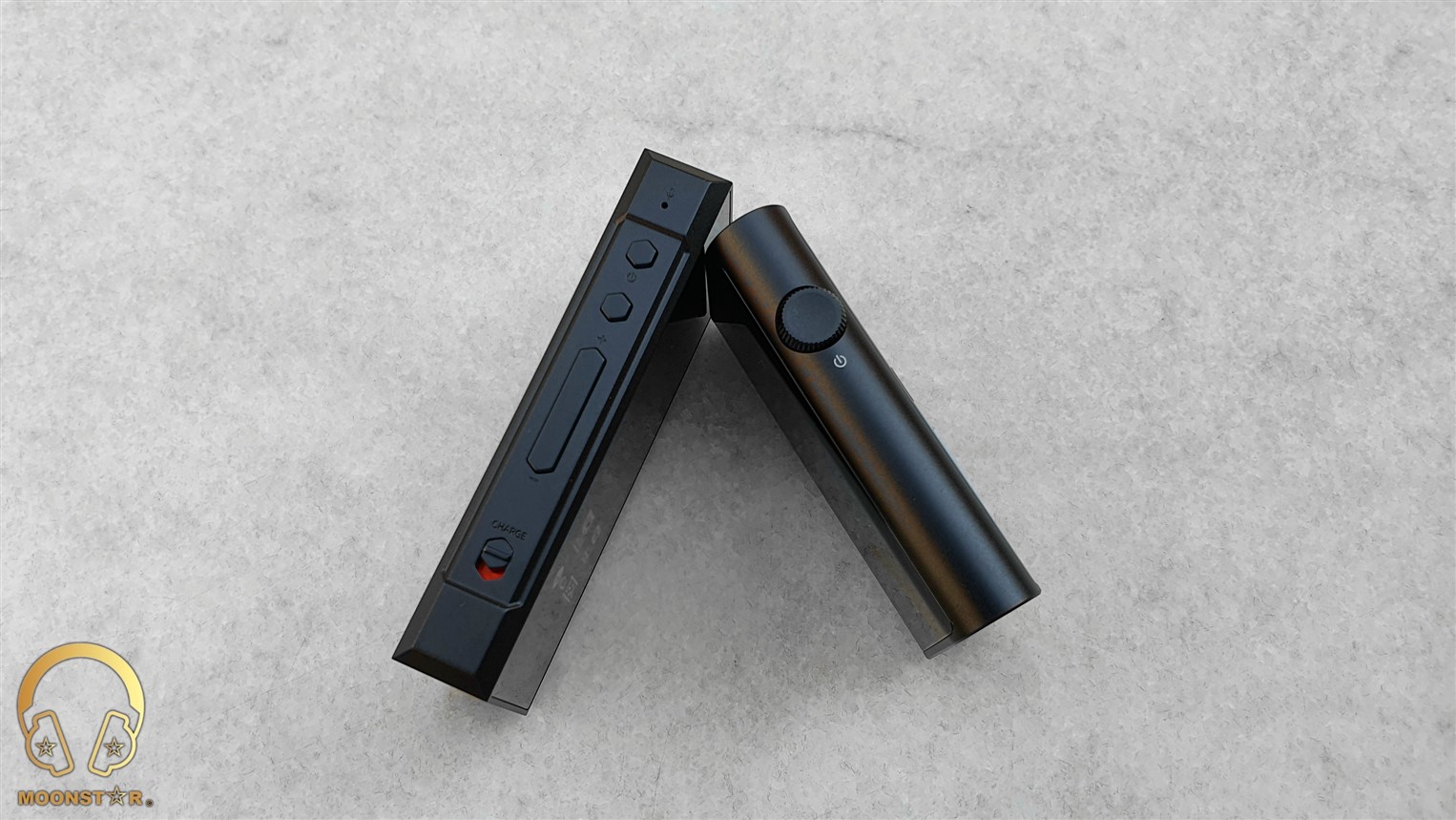
Conclusion:
The FiiO BTR7 is an ultra portable all-in one BT/USB DAC/Amplifier solution that immediately impressed me with its overall sound performance, great built quality and solid looking industrial design that adopts design elements from DAP’s like the M11 Plus. Furthermore, the BTR7 is an excellent device that comes with lots of features such like a powerful THX AAA-28 amplifier section, an innovative metal frame antenna for a stable connection, Wireless Charging, 1.3 inch IPS Color Display and many more, while the leather case that came with the device is a nice addition.
Thank you for the Read!
Dsnuts
Headphoneus Supremus
Pros: Smaller form factor
Solidly engineered
Excellent full bored SQ
Perfect for IEM use with a dead silent background.
Very nice for Can use up to 300 Ohms
More power than the competition.
Easy UI with additional functionality with control app
PEQ for folks that like to tinker
Decent 8 hours of real usage on high gain.
Wireless connectivity up to 70ft outdoors, up to 40ft indoors
Digital filters affect the base sound quality giving you 2 options
Which makes the BTR7 very versatile for all types of phones you attach to it.
Wired or wireless charging.
Can be use wired or wireless
Does not drain your phone battery when connected via wired
Included Mic is fantastic, clear vocal calls with good range.
Makes you realize how good wireless dac amps have come along.
Solidly engineered
Excellent full bored SQ
Perfect for IEM use with a dead silent background.
Very nice for Can use up to 300 Ohms
More power than the competition.
Easy UI with additional functionality with control app
PEQ for folks that like to tinker
Decent 8 hours of real usage on high gain.
Wireless connectivity up to 70ft outdoors, up to 40ft indoors
Digital filters affect the base sound quality giving you 2 options
Which makes the BTR7 very versatile for all types of phones you attach to it.
Wired or wireless charging.
Can be use wired or wireless
Does not drain your phone battery when connected via wired
Included Mic is fantastic, clear vocal calls with good range.
Makes you realize how good wireless dac amps have come along.
Cons: Not as small as prior Fiio and competition devices but easily pocketable
No clip? In the works actually.
Not the most refined EQ interface. In the works actually.
No clip? In the works actually.
Not the most refined EQ interface. In the works actually.
Fiio BTR7

Fiio needs no introduction as the company seems to keep on innovating and bringing out audio goods for enthusiasts around the world. Fiio has introduced so many innovative electronic devices over the years that enhance our music listening experiences in so many ways, with the advent of the Bluetooth wireless devices. We see an ever-increasing number of portable sources. As feature packed as the newest smartphones and tablets are, our phones and tablets when it comes to sound, just don’t cut it. When it comes to actually having enough power to drive a set of cans to sound correct or have enough SQ to drive your nicely resolving IEMs. We all know that there are limitations on our daily communication devices for sound. The BTR7 represents a well-engineered easy solution to the issue of. What to take with you on the go to get proper music happening out and about.
A wired dongle DAC solves the issue for a proper sound quality output for our phone devices but then poses another problem altogether. As small as these devices are, they are tethered via USB cable to our charging port which causes several issues. Dangling and swinging from the bottom end of our phones which is not exactly ideal. You can throw on the awkward band to have it not swinging from the bottom of the phone but then it increases the bulk of the phone and is not so pocketable after. And what happens when you get an important phone call?


I suppose if you were stationary that is not an issue, but then better driving power also means it will be using that precious battery life of your phone. The idea of using that wired device when you're walking around or doing physical activities. Not really ideal, you know what I am getting at. I am an admitted old school enthusiast. I am that one guy that invested too much money on interconnect cables thinking those will enhance the output of the amplifiers attached to my source. Heck I still have a few on hand that I use.

Fiio E12A I still have around to test IEMs with. I am a firm cable believer and even do cable reviews and it took Fiio to make me realize just how cumbersome a wired source is on the go vs wireless. The last bluetooth device I did a review for was Fiios own UTWS5. A dedicated dac chip embedded into wireless IEM arms that allows for more power and a full ranged sound connected to your favorite IEMS to make them wireless. To this day has blown my mind just how capable those things are. You can read my take on them here.
With the BTR7 in hand, this little device allows for much greater possibilities as you can connect everything you own right into your shirt pocket and use all the cables you amassed for use on your IEMs and Cans. Essentially the answer to a no compromised sound and power right in your shirt or pants pocket and with a mic so you can have conversations while you're listening.

First time I booted them out of the box. I turned on my Fiio M15 bluetooth and it immediately recognized its smaller brother the BTR7 and I was streaming high-res files via LDAC transmission. I kept on thinking no way this is a wireless sound quality. I got Fiios new FF3 buds at the same time I got the BTR7 so I threw those on there.
I was not prepared to hear a big bold musical sound experience. I posted about it right away on the discovery thread. As this was indeed a discovery for me. The out of box experience was one for the ages, it was mind shatteringly good it was unbelievable what I was hearing. OK so I was grinning from ear to ear at that point and I was giddy with how that sounded.
Disclaimers. The Fiio BTR7 bluetooth dac/amp was provided by Fiio for the purpose of a review. I have been using the BTR7 for the past month on a regular basis for this review. You can find more information about the BTR7 here on Fiios aliexpress page.

What you get.
The BTR7 measures 1.5 inches wide by 3.¼ inches tall and 3/4th inches thick. Roughly 40mm wide by 84mm tall, 15mm thick. I have read some grumblings of the size on the BTR7. To me this thing is still small. Folks that say it is too big? Really? I suppose if they are coming from Fiios prior devices or the competition which all have some smaller form factors but for what this thing sounds like and its power output it is still a smaller form factor and can easily be thrown in a shirt or pant pocket with no issue.

The BTR7 comes with a nice form fitting case and a USB type-C charging cable and a Type C to Type C or Type C to lighting cable for either android or apple devices when buying a set for you. So a bit about the case. I actually like the case as shiny as this BTR7 is, yes you need something to protect it. However, it has one glaring omission. What about the clip? It goes without saying, you get these smaller wireless dac/amps to use out and about. A clip makes a whole lot of sense. This is an early prototype, not finalized yet of the official case with clip that will be available in the near future. For now you get the gray colored faux leather case.

The BRT7 is roughly the size of a larger lighter, my use case scenario is that I throw the Bluetooth in my left shirt pocket and just connect one of my earphones to it on the go. I have thrown it into my jeans pocket on the go as well. In both cases it works as intended and with ease of use. I have tested the unit on a fairly large variety of IEMs and CANs in both wired and wireless connection and this here is my report about the BTR7.

Battery life.
I did several full charges, full use cycles and I am getting 8 hours consistently using the BTR7 in high gain via LDAC in the 4.4mm balanced out. The battery life increases to roughly 10 hours in single ended with the same high gain and LDAC settings. I know there were some rumblings on the BTR7 thread about battery life not being too good on the BTR7. To me, this is very acceptable considering the BTR7 has enough power to drive most efficient CANs. I would say anything 300 Ohms and lower should do just fine. Lastly, I will explain why the BTR7 is ideal for IEMs in the sound section.
Connectivity.
Based on my testing the BTR7 was connected to my phone or to my Fiio M15 and can be used up to 40 feet away indoors and this is through 2 walls. Which is over the 10 meters Fiios claims. This seems to be slightly reserved in how strong the connection is with my testing and even more so outdoors at 70ft roughly double from Fiios official distance at 20 meters away. This will allow the BTR7 connected to your source when doing some chores indoors or even better outdoors doing something like cutting the grass. I can say cutting the grass using the BTR7 has never been more enjoyable.

Specs;
Bezel less 1.3 inch color IPS Display
ES9219CX2
THX AAA-28X2 amps
Qualcom QCC5124 Bluetooth chip supporting up to 5.1
Supported formats: SBC,AAC,aptX,aptX low latency,aptX HD,aptX Adaptive, LDAC
XMOS XUF208 wired + Wireless support
Data stream support up to OCM 3/84Khz native DSD256
USB DAC mode with MQA 8X rendering support.
Wired and Qi wireless charging 880nAh battery, with 8-10 hours real life use.
3.5mm+4.4mm outputs
Built in microphone for voice calls
Supports CTIA wired devices with inline controls and mics
One click “dongle” mode/ USB mode
Fiio control app support with OTA upgrade
As of writing this review 10 band PEQ functionality
UAC 1.0 driverless mode, UAC 2.0 highest bit rate with driver
Weight: 68g

Ease of use/UI
The bright and clear colored 240x240 IPS display shows how you're connected to your source. It has an embedded mic at the top right corner and then 4 buttons on the same side with 2 of them functioning as forward back and volume up and down at the same time and lastly a rocker switch that enables USB functionality for connected use and charging.

A prolonged press on the power button gets you the menu options, a longer press turns the system off. Menu options are as follows; gain setting Low and High, filter settings fast which seems more dynamic/ full sounding to my ears, more dense. Hybrid fast which sounds more neutral, more open with a wider stage presentation, EQ: Jazz, pop, rock, dance, USER, R&B, classical, Hip-hop. Car mode and U-Audio, dimmer 5 settings, Language English/ Chinese, screen timer 5-30 seconds, Input priority, factory reset, and finally, version. Pressing the function button below the power button gets you into the menu option and pressing it again gets you out, also functioning as pause and continue playback.
In terms of just usability and functionality wise it is definitely user friendly and intuitive; I have never used any of Fiios prior Bluetooth dac amps and I was able to navigate within the minute I opened up the box and booted up the first time. The first thing the BTR7 does on power up is look for a source and is in pairing mode. Once connected it will auto detect the highest Bluetooth codec and you're connected playing music. The only potential issue I can think of is for folks that have some sausage fingers might have some issue doing some precise presses against the buttons. As the buttons are set fairly tight next to each other spaced approximately half an inch apart. Most folks should have no issues with the button layout, however.

Boost balanced out mode on the control app means it will bust out a bit more power for more demanding headphones and user PEQ can also be set from the control app with better precision but apparently seems to have a few bugs noted on the BTR7 thread. I am not a huge EQ user so this part is not a big deal for me but I can see if you're precise in how you like to hear certain genres of music, this might not be the most ideal for your needs. I am confident however that Fiio will bring a more refined EQ experience with better firmware's in the near future. Control app by the way is a good bit of software to have for additional control functions such as Bluetooth codec selection, additional volume controls from your phone, channel balance, distortion compensation, and operation mode. Lastly the control app is how you upgrade the firmware as it will download the latest and install it using this app. There are some adjustments you can do on the control app and for some reason you need directions on what all the buttons do and don’t read the included directions. The control app actually has the directions on it as well.
For the most part this is what folks will be greeted with on open box use. The volume buttons up and down act as next track, previous track depending on a prolonged press which will activate next track or quick presses which will activate the volume level. Will also work to scroll up and down on the menu options. Overall navigating and the use of the control app on your phone gives some extra functionality and works easily enough.

Mic function.
Ok so beyond just being a proper sounding wireless dac amp. Let's say you're listening to your music connected to your phone and you get a call. No worries there. The BTR7 includes a high-quality mic on the unit. Brilliant in that you can just speak toward where you have your BTR7. I use it in my left shirt pocket. My voice was heard nice and clear when making a call. Music will stop when you get a call and when you're making a call and continue to play afterwards. So essentially the BTR7 makes your wired mic with controls obsolete. You can be listening to your closed cans out and about and you will clearly be heard when getting a call. OK so I am a noob with these Bluetooth devices but as basic as this functionality is. It is brilliant to include a mic on the unit itself and works flawlessly with good range.
Power and Sound. Providing up to 160mW+160mW in single ended and 320mW+320mW (32 Ohm loaded)

Ok so why the physically bigger BTR7 vs even their older smaller, cheaper BTR5? Well, it has to do with including 2 THX amps for the amp stage. AKA more powa! When you're thinking THX you're not thinking some wimpy limp sound with no bass are you? Hecks no. I did some testing for my more moderately demanding Cans and my more harder to drive IEMs, results at the bottom of the read and the BTR7 has no issues pumping glorious sound through all of it is my point. With ample power on tap, the BTR7 gives a nice balance of power, functionality and most importantly sound quality on the go. The whole purpose of such a device is to be clutter less and to be used in your commutes and such but it can also be used as a sound card for your laptop or phone in wired connectivity. Best part about that is the BTR7 uses its own internal battery.

The sound of the BTR7 can best be described as a fluid, dynamic with a clean black background, bold, well detailed and layered in its presentation. When you look at the physical size of the BTR7. No way was I thinking it would have a big musical sound signature. How surprised was I when that is exactly what I got from the BTR7 out of the box. The sound from the BTR7 is a big full burly type of sound with plenty of authority. Nothing light or overly neutral, my goodness these things have no business sounding so good using your earphones and headphones. It's not the most resolving sound but where dynamic swings for your music counts the BTR7 delivers with the type of aplomb that you want to hear when out and about. You gotta understand what this thing was made for and then it makes complete sense how it was tuned.
Its default fast digital filter mode the sound is best suited for IEMs and Cans with more neutrality and balance as it synergizes better with the big bold musical sound signature of the default Fast setting. On the Hybrid Fast setting, trebles seem to be affected a bit more in this setting and the BTR7 takes on more of a neutral, more extended treble presentation with a slight increase for stage that matches better with more colored IEMs and Cans. Sometimes these DAC chip filters can sound more subtle than actually make a difference but for the BTR7 having what essentially is 2 types of sound profiles is a good thing. Then you add the PEQ in the mix and you can fine tune the BTR7 to how you want to hear your music.

Trebles has a clean well-rounded presentation, and it seems to extend a bit more so using the hybrid fast digital filter as mentioned earlier. Its treble gets a solid tonal footing to the base BTR7 sound with no over or under enhancement for the trebles. It's not the most resolving treble presentation for sources but at the same time is difficult to fault how the treble plays out. Playing around with the filters and or the PEQ in combination should get you an approximation of how the BTR7 should sound for you. My review here is mostly based on just the filter settings with no EQ.
Overall, in the base FAST setting the BTR7 is a good solid treble end but overall SQ does sound ever so slightly warm with more emphasis in its mids to bass presentation more so than focusing on the treble aspect of its tuning. One good way to describe the BTR7 base sound signature is that it sounds like a nicely resolving closed can with a bold bass end. Hybrid Fast is like the sound that comes from an open can with a bit more neutrality to the base sound. In the cable realm. A pure copper cable vs using a pure silver cable. I think you might get a general ideal here of what the filter settings are doing.

Mids of the BTR7 is where the magic sauce of the sound signature of the BTR7 is doing its thing. Mids sound broad, open and very nicely layered yet linear in how it is portrayed. Its precise imaging sounds like how a good DAC/AMP should and I am not just talking about a small form dac/amp. I am talking about a dedicated DAC/AMP you use on your desktop with a full-bodied amplification. And that is what really made me sit back countless times. I just could not believe the sound that was coming out of this small form factor. It might look small, but it certainly doesn't sound small.
I owned the first Fiio DAP the X3 a long time ago and their first Android DAP the X5 3rd gen. Showing a bit of the old school audio sound signature. Natural warmth, well balanced and detailed in its presentation with clearly evident dynamics and that is how the BTR7 sounds to my ears. Mids with body and fullness that is highly euphoric due to that natural tonal character and big dynamics from the bass end.

The Bass end of the BTR7 is what you would consider a THX amplification should and could do. The Bass is nothing less than fantastic in its presentation on the BTR7. Being a former basshead in my younger days I can always appreciate sources that are not shy about bringing the thunder. In its base form the bass is where the emphasis lies for its presentation, so you get a big bold deep hitting bass end from the BTR7. Again, IEMS with a neutral tuning will benefit the most from the BTR7 base FAST sound signature. But for bass fans even without using EQ I can say the BTR7 has an unexpected bass presence that will be a crowd pleaser. It has bass and it is a part of its base tuning. Bass shows a tactile impact from mid bass to the deep end and anything connected to the BTR7 will benefit from its emphasis on bass presence.
Of course, if you feel the need to bring even more boom, that is what the PEQ functionality is for and you can turn it on hip hop or dance EQ and get some more of that. The bass leaning signature of the BTR7 makes a whole lot of sense to me as the first aspect of how we hear sound out and about will drown out the bass end first actually equalizing how you're hearing your music. Music ends up sounding more balanced out and about of course that all depends on what IEMs and Cans you have connected to the BTR7.

Connected USB mode
Sound quality ramps up a touch expanding its stage and dynamics. It is not a night and day difference between wired and something like LDAC mode wireless. But it does seem to benefit a bit from being connected SQ wise. Same mostly neutral signature with excellent power and extensions on both ends. Sounds a touch fuller and more detailed but the actual sound quality difference is not so drastic to where it is a clear winner over using it wirelessly. For wired connectivity I tested it using my laptop. And to be honest I prefer connecting it via Bluetooth from my laptop as I have enough things, mouse, CD drive, external HD connected to my laptop and having the Bluetooth option where there is one less wire connected to my laptop with really not much in the way of sacrifices for sound. THX amplification for gaming is a treat using my gaming laptop and the BTR7.
How does it sound with my IEMs and Cans?
As good as the BTR7 is to drive your easy to drive headphones with. It is the IEMs that will benefit from the sound quality and its power all with a supreme silent background of the BTR7.

First up is with the Fiio FF3
Which I got the same time the BTR7 arrived. It was in the same package actually. This combo is amazing. The wide sound of the FF3 with its punchy bass end in use with the BTR7 right off the bat was made of one another. The 45 Ohm sensitivity is moderate for buds but easy for the BTR7 to drive to full capacity. This combo as good as it synergizes with each other ultimately is for stationary use as the FF3 is a bud meaning its sound leakage is not ideal for using outdoors. This combo got me thinking of just how good the BTR7 sounded as much as the FF3 sounded. The dynamism and synergy for this combo is simply astounding. If you're an old school enthusiast and you take precedence for rangy broad musical sounding sources and earphones with a punchy bass end. This bud is most definitely for you in combo with the BTR7

Next up. Fiios own FD7
This is even harder to drive at 50 ohms in a semi open all metal build. This IEM needs power to really strut its performance to the next level and here I am hearing the FD7 sound as good as I have ever heard it on anything I own including some sources that dwarf the cost of the BTR7 by 10X fold. Best results are utilizing the 4.4 balanced out. The FD7 sounds like it is on steroids with this combo. The FD7 is closer to a neutral type balanced signature so the FAST filter was used for this combo, and it clearly shows it benefits from the fuller note weight of this filter. Broad reference type sound is achieved using this combo. I can say the BTR7 does the Fiio flagship Beryllium dynamic justice giving it plenty of power with ample headroom to spare. Just a fantastic pairing of these two.

Why stop it at just two Fiio earphones.
Next up with the 18 ohm FH9. In many ways the FH9 is tuned a lot like how the BTR7 is tuned. Forward projecting big musical yet technical in its sound presentation the FH9 and the BTR7 is a case where two of the similar type signatures actually match. BTR7 brings out the strengths of the FH9 sound presentation. Bass is full on, mids highly emotive and treble extended and sparkly with a wide broad engaging deep sound. This is yet another earphone that benefits from the power and highly dynamic presentation of the BTR7. You would deduce the fact that maybe Fiio here produces IEMs to synergize with their own sources or something. Just astounding how good this combo sounds with each other this time in Hybrid Fast filter. A highly detailed presentation with high levels of imaging, very engaging from the first time I plugged into the BTR7.
Between how the FD7 and the FH9 performs on the BTR7. The FD7 sounds spectacular with a bit of volume and the FH9 with lower volume listening due to how detailed the presentation can be. Both sets sound spectacular on the BTR7.

Now onto some Cans.
Yes you can. First Can in use is a headfi favorite the Sennheiser X58 in balanced. This 150 Ohm can is not the most efficient but can be driven even out of a phone. The question is. Can the BTR7 do this can justice? The quick answer is yes. BTR7 has absolutely no struggle bringing the the X58 to blaring volumes. Dynamic cans even the more efficient types actually benefit from some amplification, and it goes without saying the X58 ramps up nicely with the power of the BTR7. Dynamic and full range in how it sounds, this is yet another pairing where I don’t feel using a desktop rig is necessary when you got the BTR7 on tap. Clean, well balanced and superbly dynamic in its delivery. If you need a simple source for your X58 to do its sound some justice. Look no further than the BTR7 as it will not only give you enough driving power but also will allow you to make some phone calls if you decide to use these out and about.

Lastly, I plugged in one of my favorite Cans, my Beyerdynamic Amiron Homes. The 250 Ohm Amiron Home. I mean it's got Home for a title, right? Not so on the BTR7. You can use a can like the Amiron Home out and about if you choose. Cus it drives them with good authority. With the Amiron Home I do have to crank up the volume to about 75% for good volume so I am starting to see the limitation of the driving power of the BTR7 but sound quality wise. It is right up there with some of the best-connected DAC/AMPs I have tried on the Amiron Homes. I have used this combination doing chores inside and outside my home and the joy of making my Amiron Home wireless just made me giddy to be honest and with really no sacrifice to SQ. This gives the widest BTR7 presentation as the Amiron Home is an open can. Bass is a bit more drowned out outdoors but still very much enjoyable to listen to. Absolute treat listening to the Amiron Home using the BTR7.

So I tested out easily over a dozen IEMs and 4 Cans at my home and really the performance of the BTR7 is consistent across the board.
OK so this one was a longerun
But I was having so much fun testing out the BTR7. I have a nickname I give to things I am fond of and I can proudly give the name… Drum roll please… How about mighty mouse.

Older folks know what mighty mouse is and that is exactly what the BTR7 is. It is mighty in its performance but small in stature. If the smile inducing dynamic sound signature doesn't get you moving than how's about the supreme black background with no hiss whatsoever for your sensitive IEMs. Has enough driving power for Cans and buds up to 300 Ohms with ease. It has a crowd-pleasing signature that is easy to use for your daily walks and or excursions. The BTR7 is a device I never knew I needed until I got to use one. I can see a scenario where folks will ditch their large DAPs or cumbersome dongles for the BTR7. If you're looking for a killer everyday solution for sound and power on the go. I can’t recommend the BTR7 highly enough. I don’t know what is better about it, the crazy good sound quality or the power driving the sound. How's about both, all wrapped up in a convenient easy to use package. Thanks for taking the long time to read. You're truly appreciated…. Ds.

Fiio needs no introduction as the company seems to keep on innovating and bringing out audio goods for enthusiasts around the world. Fiio has introduced so many innovative electronic devices over the years that enhance our music listening experiences in so many ways, with the advent of the Bluetooth wireless devices. We see an ever-increasing number of portable sources. As feature packed as the newest smartphones and tablets are, our phones and tablets when it comes to sound, just don’t cut it. When it comes to actually having enough power to drive a set of cans to sound correct or have enough SQ to drive your nicely resolving IEMs. We all know that there are limitations on our daily communication devices for sound. The BTR7 represents a well-engineered easy solution to the issue of. What to take with you on the go to get proper music happening out and about.
A wired dongle DAC solves the issue for a proper sound quality output for our phone devices but then poses another problem altogether. As small as these devices are, they are tethered via USB cable to our charging port which causes several issues. Dangling and swinging from the bottom end of our phones which is not exactly ideal. You can throw on the awkward band to have it not swinging from the bottom of the phone but then it increases the bulk of the phone and is not so pocketable after. And what happens when you get an important phone call?


I suppose if you were stationary that is not an issue, but then better driving power also means it will be using that precious battery life of your phone. The idea of using that wired device when you're walking around or doing physical activities. Not really ideal, you know what I am getting at. I am an admitted old school enthusiast. I am that one guy that invested too much money on interconnect cables thinking those will enhance the output of the amplifiers attached to my source. Heck I still have a few on hand that I use.

Fiio E12A I still have around to test IEMs with. I am a firm cable believer and even do cable reviews and it took Fiio to make me realize just how cumbersome a wired source is on the go vs wireless. The last bluetooth device I did a review for was Fiios own UTWS5. A dedicated dac chip embedded into wireless IEM arms that allows for more power and a full ranged sound connected to your favorite IEMS to make them wireless. To this day has blown my mind just how capable those things are. You can read my take on them here.
With the BTR7 in hand, this little device allows for much greater possibilities as you can connect everything you own right into your shirt pocket and use all the cables you amassed for use on your IEMs and Cans. Essentially the answer to a no compromised sound and power right in your shirt or pants pocket and with a mic so you can have conversations while you're listening.

First time I booted them out of the box. I turned on my Fiio M15 bluetooth and it immediately recognized its smaller brother the BTR7 and I was streaming high-res files via LDAC transmission. I kept on thinking no way this is a wireless sound quality. I got Fiios new FF3 buds at the same time I got the BTR7 so I threw those on there.
I was not prepared to hear a big bold musical sound experience. I posted about it right away on the discovery thread. As this was indeed a discovery for me. The out of box experience was one for the ages, it was mind shatteringly good it was unbelievable what I was hearing. OK so I was grinning from ear to ear at that point and I was giddy with how that sounded.
Disclaimers. The Fiio BTR7 bluetooth dac/amp was provided by Fiio for the purpose of a review. I have been using the BTR7 for the past month on a regular basis for this review. You can find more information about the BTR7 here on Fiios aliexpress page.

What you get.
The BTR7 measures 1.5 inches wide by 3.¼ inches tall and 3/4th inches thick. Roughly 40mm wide by 84mm tall, 15mm thick. I have read some grumblings of the size on the BTR7. To me this thing is still small. Folks that say it is too big? Really? I suppose if they are coming from Fiios prior devices or the competition which all have some smaller form factors but for what this thing sounds like and its power output it is still a smaller form factor and can easily be thrown in a shirt or pant pocket with no issue.

The BTR7 comes with a nice form fitting case and a USB type-C charging cable and a Type C to Type C or Type C to lighting cable for either android or apple devices when buying a set for you. So a bit about the case. I actually like the case as shiny as this BTR7 is, yes you need something to protect it. However, it has one glaring omission. What about the clip? It goes without saying, you get these smaller wireless dac/amps to use out and about. A clip makes a whole lot of sense. This is an early prototype, not finalized yet of the official case with clip that will be available in the near future. For now you get the gray colored faux leather case.

The BRT7 is roughly the size of a larger lighter, my use case scenario is that I throw the Bluetooth in my left shirt pocket and just connect one of my earphones to it on the go. I have thrown it into my jeans pocket on the go as well. In both cases it works as intended and with ease of use. I have tested the unit on a fairly large variety of IEMs and CANs in both wired and wireless connection and this here is my report about the BTR7.

Battery life.
I did several full charges, full use cycles and I am getting 8 hours consistently using the BTR7 in high gain via LDAC in the 4.4mm balanced out. The battery life increases to roughly 10 hours in single ended with the same high gain and LDAC settings. I know there were some rumblings on the BTR7 thread about battery life not being too good on the BTR7. To me, this is very acceptable considering the BTR7 has enough power to drive most efficient CANs. I would say anything 300 Ohms and lower should do just fine. Lastly, I will explain why the BTR7 is ideal for IEMs in the sound section.
Connectivity.
Based on my testing the BTR7 was connected to my phone or to my Fiio M15 and can be used up to 40 feet away indoors and this is through 2 walls. Which is over the 10 meters Fiios claims. This seems to be slightly reserved in how strong the connection is with my testing and even more so outdoors at 70ft roughly double from Fiios official distance at 20 meters away. This will allow the BTR7 connected to your source when doing some chores indoors or even better outdoors doing something like cutting the grass. I can say cutting the grass using the BTR7 has never been more enjoyable.

Specs;
Bezel less 1.3 inch color IPS Display
ES9219CX2
THX AAA-28X2 amps
Qualcom QCC5124 Bluetooth chip supporting up to 5.1
Supported formats: SBC,AAC,aptX,aptX low latency,aptX HD,aptX Adaptive, LDAC
XMOS XUF208 wired + Wireless support
Data stream support up to OCM 3/84Khz native DSD256
USB DAC mode with MQA 8X rendering support.
Wired and Qi wireless charging 880nAh battery, with 8-10 hours real life use.
3.5mm+4.4mm outputs
Built in microphone for voice calls
Supports CTIA wired devices with inline controls and mics
One click “dongle” mode/ USB mode
Fiio control app support with OTA upgrade
As of writing this review 10 band PEQ functionality
UAC 1.0 driverless mode, UAC 2.0 highest bit rate with driver
Weight: 68g

Ease of use/UI
The bright and clear colored 240x240 IPS display shows how you're connected to your source. It has an embedded mic at the top right corner and then 4 buttons on the same side with 2 of them functioning as forward back and volume up and down at the same time and lastly a rocker switch that enables USB functionality for connected use and charging.

A prolonged press on the power button gets you the menu options, a longer press turns the system off. Menu options are as follows; gain setting Low and High, filter settings fast which seems more dynamic/ full sounding to my ears, more dense. Hybrid fast which sounds more neutral, more open with a wider stage presentation, EQ: Jazz, pop, rock, dance, USER, R&B, classical, Hip-hop. Car mode and U-Audio, dimmer 5 settings, Language English/ Chinese, screen timer 5-30 seconds, Input priority, factory reset, and finally, version. Pressing the function button below the power button gets you into the menu option and pressing it again gets you out, also functioning as pause and continue playback.
In terms of just usability and functionality wise it is definitely user friendly and intuitive; I have never used any of Fiios prior Bluetooth dac amps and I was able to navigate within the minute I opened up the box and booted up the first time. The first thing the BTR7 does on power up is look for a source and is in pairing mode. Once connected it will auto detect the highest Bluetooth codec and you're connected playing music. The only potential issue I can think of is for folks that have some sausage fingers might have some issue doing some precise presses against the buttons. As the buttons are set fairly tight next to each other spaced approximately half an inch apart. Most folks should have no issues with the button layout, however.

Boost balanced out mode on the control app means it will bust out a bit more power for more demanding headphones and user PEQ can also be set from the control app with better precision but apparently seems to have a few bugs noted on the BTR7 thread. I am not a huge EQ user so this part is not a big deal for me but I can see if you're precise in how you like to hear certain genres of music, this might not be the most ideal for your needs. I am confident however that Fiio will bring a more refined EQ experience with better firmware's in the near future. Control app by the way is a good bit of software to have for additional control functions such as Bluetooth codec selection, additional volume controls from your phone, channel balance, distortion compensation, and operation mode. Lastly the control app is how you upgrade the firmware as it will download the latest and install it using this app. There are some adjustments you can do on the control app and for some reason you need directions on what all the buttons do and don’t read the included directions. The control app actually has the directions on it as well.
For the most part this is what folks will be greeted with on open box use. The volume buttons up and down act as next track, previous track depending on a prolonged press which will activate next track or quick presses which will activate the volume level. Will also work to scroll up and down on the menu options. Overall navigating and the use of the control app on your phone gives some extra functionality and works easily enough.

Mic function.
Ok so beyond just being a proper sounding wireless dac amp. Let's say you're listening to your music connected to your phone and you get a call. No worries there. The BTR7 includes a high-quality mic on the unit. Brilliant in that you can just speak toward where you have your BTR7. I use it in my left shirt pocket. My voice was heard nice and clear when making a call. Music will stop when you get a call and when you're making a call and continue to play afterwards. So essentially the BTR7 makes your wired mic with controls obsolete. You can be listening to your closed cans out and about and you will clearly be heard when getting a call. OK so I am a noob with these Bluetooth devices but as basic as this functionality is. It is brilliant to include a mic on the unit itself and works flawlessly with good range.
Power and Sound. Providing up to 160mW+160mW in single ended and 320mW+320mW (32 Ohm loaded)

Ok so why the physically bigger BTR7 vs even their older smaller, cheaper BTR5? Well, it has to do with including 2 THX amps for the amp stage. AKA more powa! When you're thinking THX you're not thinking some wimpy limp sound with no bass are you? Hecks no. I did some testing for my more moderately demanding Cans and my more harder to drive IEMs, results at the bottom of the read and the BTR7 has no issues pumping glorious sound through all of it is my point. With ample power on tap, the BTR7 gives a nice balance of power, functionality and most importantly sound quality on the go. The whole purpose of such a device is to be clutter less and to be used in your commutes and such but it can also be used as a sound card for your laptop or phone in wired connectivity. Best part about that is the BTR7 uses its own internal battery.

The sound of the BTR7 can best be described as a fluid, dynamic with a clean black background, bold, well detailed and layered in its presentation. When you look at the physical size of the BTR7. No way was I thinking it would have a big musical sound signature. How surprised was I when that is exactly what I got from the BTR7 out of the box. The sound from the BTR7 is a big full burly type of sound with plenty of authority. Nothing light or overly neutral, my goodness these things have no business sounding so good using your earphones and headphones. It's not the most resolving sound but where dynamic swings for your music counts the BTR7 delivers with the type of aplomb that you want to hear when out and about. You gotta understand what this thing was made for and then it makes complete sense how it was tuned.
Its default fast digital filter mode the sound is best suited for IEMs and Cans with more neutrality and balance as it synergizes better with the big bold musical sound signature of the default Fast setting. On the Hybrid Fast setting, trebles seem to be affected a bit more in this setting and the BTR7 takes on more of a neutral, more extended treble presentation with a slight increase for stage that matches better with more colored IEMs and Cans. Sometimes these DAC chip filters can sound more subtle than actually make a difference but for the BTR7 having what essentially is 2 types of sound profiles is a good thing. Then you add the PEQ in the mix and you can fine tune the BTR7 to how you want to hear your music.

Trebles has a clean well-rounded presentation, and it seems to extend a bit more so using the hybrid fast digital filter as mentioned earlier. Its treble gets a solid tonal footing to the base BTR7 sound with no over or under enhancement for the trebles. It's not the most resolving treble presentation for sources but at the same time is difficult to fault how the treble plays out. Playing around with the filters and or the PEQ in combination should get you an approximation of how the BTR7 should sound for you. My review here is mostly based on just the filter settings with no EQ.
Overall, in the base FAST setting the BTR7 is a good solid treble end but overall SQ does sound ever so slightly warm with more emphasis in its mids to bass presentation more so than focusing on the treble aspect of its tuning. One good way to describe the BTR7 base sound signature is that it sounds like a nicely resolving closed can with a bold bass end. Hybrid Fast is like the sound that comes from an open can with a bit more neutrality to the base sound. In the cable realm. A pure copper cable vs using a pure silver cable. I think you might get a general ideal here of what the filter settings are doing.

Mids of the BTR7 is where the magic sauce of the sound signature of the BTR7 is doing its thing. Mids sound broad, open and very nicely layered yet linear in how it is portrayed. Its precise imaging sounds like how a good DAC/AMP should and I am not just talking about a small form dac/amp. I am talking about a dedicated DAC/AMP you use on your desktop with a full-bodied amplification. And that is what really made me sit back countless times. I just could not believe the sound that was coming out of this small form factor. It might look small, but it certainly doesn't sound small.
I owned the first Fiio DAP the X3 a long time ago and their first Android DAP the X5 3rd gen. Showing a bit of the old school audio sound signature. Natural warmth, well balanced and detailed in its presentation with clearly evident dynamics and that is how the BTR7 sounds to my ears. Mids with body and fullness that is highly euphoric due to that natural tonal character and big dynamics from the bass end.

The Bass end of the BTR7 is what you would consider a THX amplification should and could do. The Bass is nothing less than fantastic in its presentation on the BTR7. Being a former basshead in my younger days I can always appreciate sources that are not shy about bringing the thunder. In its base form the bass is where the emphasis lies for its presentation, so you get a big bold deep hitting bass end from the BTR7. Again, IEMS with a neutral tuning will benefit the most from the BTR7 base FAST sound signature. But for bass fans even without using EQ I can say the BTR7 has an unexpected bass presence that will be a crowd pleaser. It has bass and it is a part of its base tuning. Bass shows a tactile impact from mid bass to the deep end and anything connected to the BTR7 will benefit from its emphasis on bass presence.
Of course, if you feel the need to bring even more boom, that is what the PEQ functionality is for and you can turn it on hip hop or dance EQ and get some more of that. The bass leaning signature of the BTR7 makes a whole lot of sense to me as the first aspect of how we hear sound out and about will drown out the bass end first actually equalizing how you're hearing your music. Music ends up sounding more balanced out and about of course that all depends on what IEMs and Cans you have connected to the BTR7.

Connected USB mode
Sound quality ramps up a touch expanding its stage and dynamics. It is not a night and day difference between wired and something like LDAC mode wireless. But it does seem to benefit a bit from being connected SQ wise. Same mostly neutral signature with excellent power and extensions on both ends. Sounds a touch fuller and more detailed but the actual sound quality difference is not so drastic to where it is a clear winner over using it wirelessly. For wired connectivity I tested it using my laptop. And to be honest I prefer connecting it via Bluetooth from my laptop as I have enough things, mouse, CD drive, external HD connected to my laptop and having the Bluetooth option where there is one less wire connected to my laptop with really not much in the way of sacrifices for sound. THX amplification for gaming is a treat using my gaming laptop and the BTR7.
How does it sound with my IEMs and Cans?
As good as the BTR7 is to drive your easy to drive headphones with. It is the IEMs that will benefit from the sound quality and its power all with a supreme silent background of the BTR7.

First up is with the Fiio FF3
Which I got the same time the BTR7 arrived. It was in the same package actually. This combo is amazing. The wide sound of the FF3 with its punchy bass end in use with the BTR7 right off the bat was made of one another. The 45 Ohm sensitivity is moderate for buds but easy for the BTR7 to drive to full capacity. This combo as good as it synergizes with each other ultimately is for stationary use as the FF3 is a bud meaning its sound leakage is not ideal for using outdoors. This combo got me thinking of just how good the BTR7 sounded as much as the FF3 sounded. The dynamism and synergy for this combo is simply astounding. If you're an old school enthusiast and you take precedence for rangy broad musical sounding sources and earphones with a punchy bass end. This bud is most definitely for you in combo with the BTR7

Next up. Fiios own FD7
This is even harder to drive at 50 ohms in a semi open all metal build. This IEM needs power to really strut its performance to the next level and here I am hearing the FD7 sound as good as I have ever heard it on anything I own including some sources that dwarf the cost of the BTR7 by 10X fold. Best results are utilizing the 4.4 balanced out. The FD7 sounds like it is on steroids with this combo. The FD7 is closer to a neutral type balanced signature so the FAST filter was used for this combo, and it clearly shows it benefits from the fuller note weight of this filter. Broad reference type sound is achieved using this combo. I can say the BTR7 does the Fiio flagship Beryllium dynamic justice giving it plenty of power with ample headroom to spare. Just a fantastic pairing of these two.

Why stop it at just two Fiio earphones.
Next up with the 18 ohm FH9. In many ways the FH9 is tuned a lot like how the BTR7 is tuned. Forward projecting big musical yet technical in its sound presentation the FH9 and the BTR7 is a case where two of the similar type signatures actually match. BTR7 brings out the strengths of the FH9 sound presentation. Bass is full on, mids highly emotive and treble extended and sparkly with a wide broad engaging deep sound. This is yet another earphone that benefits from the power and highly dynamic presentation of the BTR7. You would deduce the fact that maybe Fiio here produces IEMs to synergize with their own sources or something. Just astounding how good this combo sounds with each other this time in Hybrid Fast filter. A highly detailed presentation with high levels of imaging, very engaging from the first time I plugged into the BTR7.
Between how the FD7 and the FH9 performs on the BTR7. The FD7 sounds spectacular with a bit of volume and the FH9 with lower volume listening due to how detailed the presentation can be. Both sets sound spectacular on the BTR7.

Now onto some Cans.
Yes you can. First Can in use is a headfi favorite the Sennheiser X58 in balanced. This 150 Ohm can is not the most efficient but can be driven even out of a phone. The question is. Can the BTR7 do this can justice? The quick answer is yes. BTR7 has absolutely no struggle bringing the the X58 to blaring volumes. Dynamic cans even the more efficient types actually benefit from some amplification, and it goes without saying the X58 ramps up nicely with the power of the BTR7. Dynamic and full range in how it sounds, this is yet another pairing where I don’t feel using a desktop rig is necessary when you got the BTR7 on tap. Clean, well balanced and superbly dynamic in its delivery. If you need a simple source for your X58 to do its sound some justice. Look no further than the BTR7 as it will not only give you enough driving power but also will allow you to make some phone calls if you decide to use these out and about.

Lastly, I plugged in one of my favorite Cans, my Beyerdynamic Amiron Homes. The 250 Ohm Amiron Home. I mean it's got Home for a title, right? Not so on the BTR7. You can use a can like the Amiron Home out and about if you choose. Cus it drives them with good authority. With the Amiron Home I do have to crank up the volume to about 75% for good volume so I am starting to see the limitation of the driving power of the BTR7 but sound quality wise. It is right up there with some of the best-connected DAC/AMPs I have tried on the Amiron Homes. I have used this combination doing chores inside and outside my home and the joy of making my Amiron Home wireless just made me giddy to be honest and with really no sacrifice to SQ. This gives the widest BTR7 presentation as the Amiron Home is an open can. Bass is a bit more drowned out outdoors but still very much enjoyable to listen to. Absolute treat listening to the Amiron Home using the BTR7.

So I tested out easily over a dozen IEMs and 4 Cans at my home and really the performance of the BTR7 is consistent across the board.
OK so this one was a longerun
But I was having so much fun testing out the BTR7. I have a nickname I give to things I am fond of and I can proudly give the name… Drum roll please… How about mighty mouse.

Older folks know what mighty mouse is and that is exactly what the BTR7 is. It is mighty in its performance but small in stature. If the smile inducing dynamic sound signature doesn't get you moving than how's about the supreme black background with no hiss whatsoever for your sensitive IEMs. Has enough driving power for Cans and buds up to 300 Ohms with ease. It has a crowd-pleasing signature that is easy to use for your daily walks and or excursions. The BTR7 is a device I never knew I needed until I got to use one. I can see a scenario where folks will ditch their large DAPs or cumbersome dongles for the BTR7. If you're looking for a killer everyday solution for sound and power on the go. I can’t recommend the BTR7 highly enough. I don’t know what is better about it, the crazy good sound quality or the power driving the sound. How's about both, all wrapped up in a convenient easy to use package. Thanks for taking the long time to read. You're truly appreciated…. Ds.
Last edited:
kgs51
Does this work well as a standalone wired headphone amp
Dsnuts
It can connect via USB to your phone and be used as a USB DAC/AMP so you will get power and sound quality through the BTR7. Unit is not a stand alone amplifier and there is no mode for just amplification if that is what your looking for. If you have more questions regarding the BTR7. You can ask on this thread as the Fiio rep and owners of the BTR7 will be glad to answer any questions you have. https://www.head-fi.org/threads/fiio-btr7-portable-bluetooth-amplifier-color-ips-display-high-performance-dac-es9219c-2-thx-aaa-28-2-amps-3-5-4-4mm-outputs-one-click-“dongle”-mode-qualcomm-qcc5124-bluetooth-chip.963808/
Pros: The sound has been greatly improved compared to the BTR5 2021;
Very sufficient output power;
feature-rich;
New design;
Color screen.
Very sufficient output power;
feature-rich;
New design;
Color screen.
Cons: Larger than the BTR5;
The UI is not modern enough to take full advantage of the color screen.
The UI is not modern enough to take full advantage of the color screen.

DAC: ES9219C*2
AMP: THX AAA 28*2
BT: QCC5124
Outputs: 3.5mm Unbalanced, 4.4mm Balanced
Output power (balanced): 320mW@32Ω

Highlights have been written here in case you missed them:
1. Three-level audio architecture(DAC+Lowpass filter+THX);
2. The digital module and the analog module are isolated and powered separately;
3. The THX amp increases single-ended power by 88% and balanced power by 30%;
4. Bluetooth 5.1, it supports aptX adaptive, which means lower latency;
5. Integrated metal frame, making Bluetooth transmission more stable and reducing interference;
6. Supports Qi protocol wireless charging.

Next I will review it based on my own experience.
Function and operation:
After long pressing the power button to enter the menu, you can see that these functions can be adjusted directly on the BTR7, and you can also turn the page down to see other settings such as language, brightness, screen time, input priority, etc.

For me, the biggest difference from the BTR5 is that the EQ settings can be adjusted on the BTR7.
Unfortunately, there is only one user EQ. It would be better if there were multiple to suit my multiple headphones.

If you want to it as a USB DAC, the EQ won't be available(the same as the BTR5), though I prefer to use the graphic equalizers on PC, which are more precisely tuned. So the BTR7 may be better at bluetooth reception, but I'm not saying it's not good at USB decoding. It can support DSD256 decoding and MQA rendering in USB DAC mode.

This time, a charging switch is added to the side of the BTR7, which makes it more convenient to be connected to your phone via Type-C.

Those 2.5mm balanced cables prepared for the BTR5 is now going to be replaced with 4.4mm cables. The 2.5mm diameter does seem to be more fragile than the 4.4mm, so the adoption of the 4.4mm balance port will make sense.

Subjective review of the sound quality:
I'm using 6-BAs CIEMs, which are characterized by high sensitivity (I like to call them floor-noise detectors).
With all the unnecessary settings turned off, the BTR7 sounds excellent. The bass is dynamic, the highs are smooth and clear, and the resolution is good.
If the sound of the BTR5 is pale, or like a lake, then the sound of the BTR7 is vivid, or like the ocean, the waves.
And these audible improvements in sound quality over the BTR5 is why I got it and why this review appears here.

(It's my first time writing a review not for headphones, if there is something missing, please leave a comment and I will update my review. Danke!)
--------------------------------------------------------------------------------------------------------
Updated on July 29, the BTR7 has added the PEQ (parametric equalizer) function(available under LDAC).


Last edited:
Wasaabi
I should get a Questyle M15 first. But my concern is that its capacity of resisting interference as phones are a strong source of interference, but the M15 doesn't have an all-metal case to resist it.
kachoo
I've found that the battery life is better than what's being advertised here. In single ended mode especially, I can easily get 12 hours




